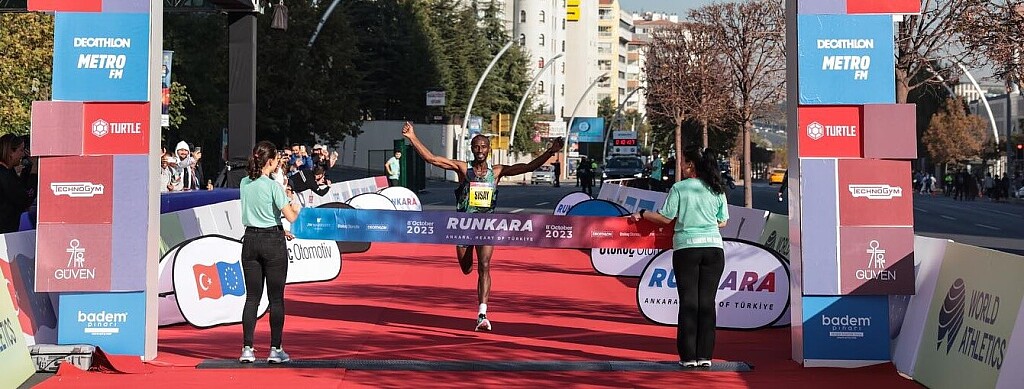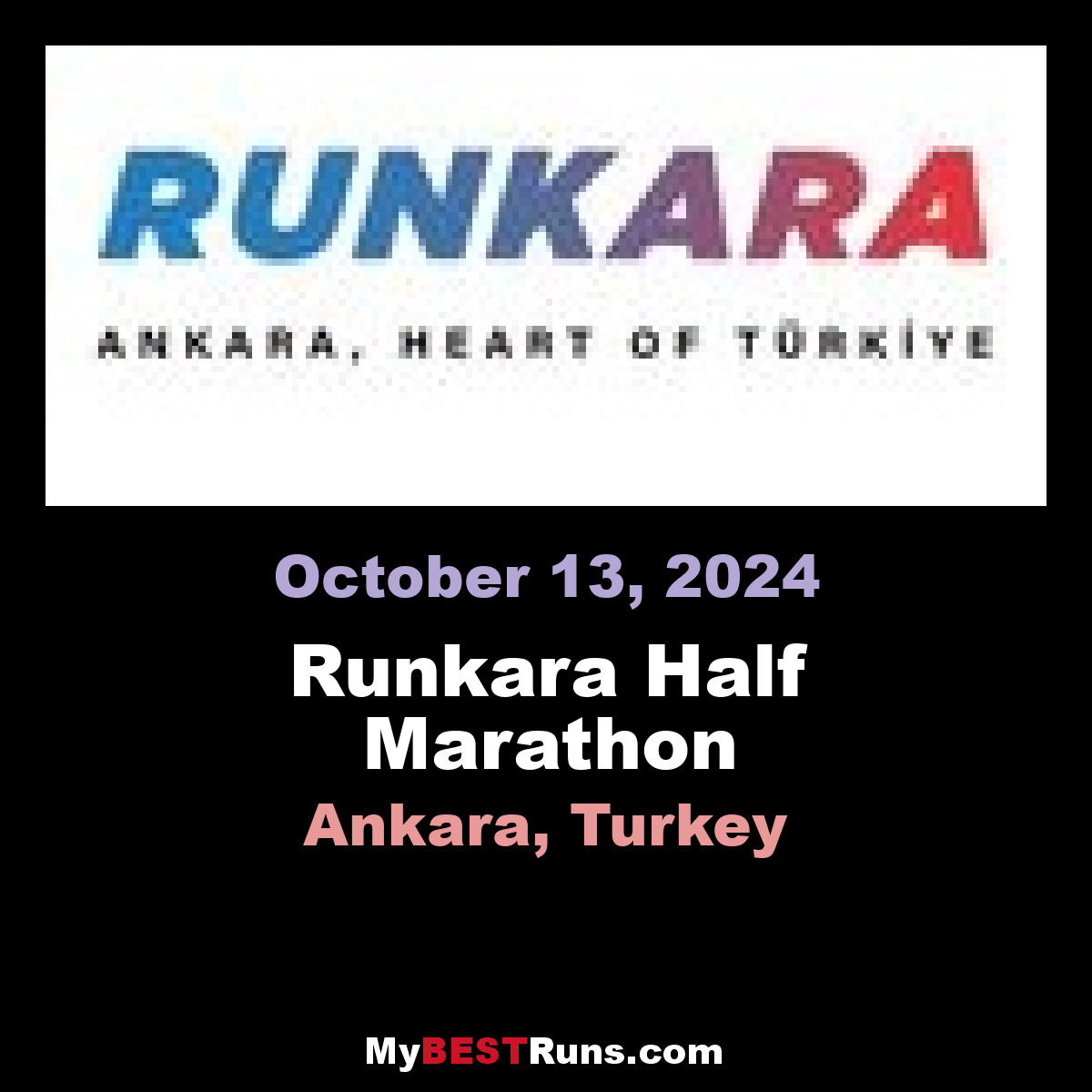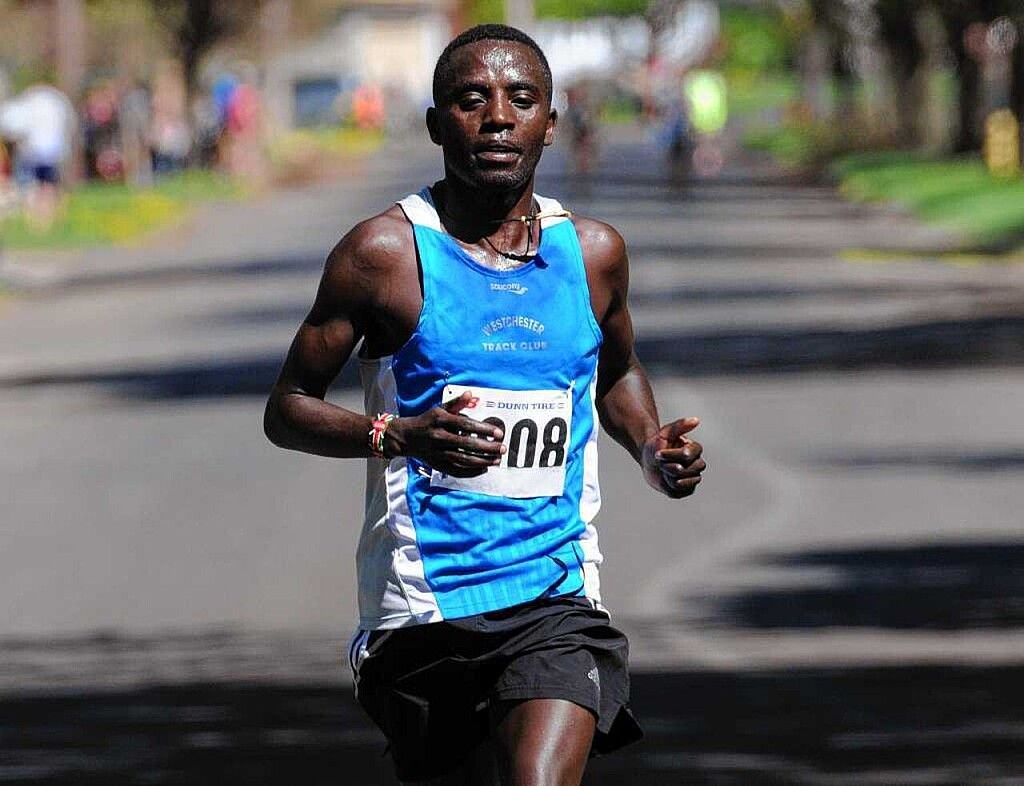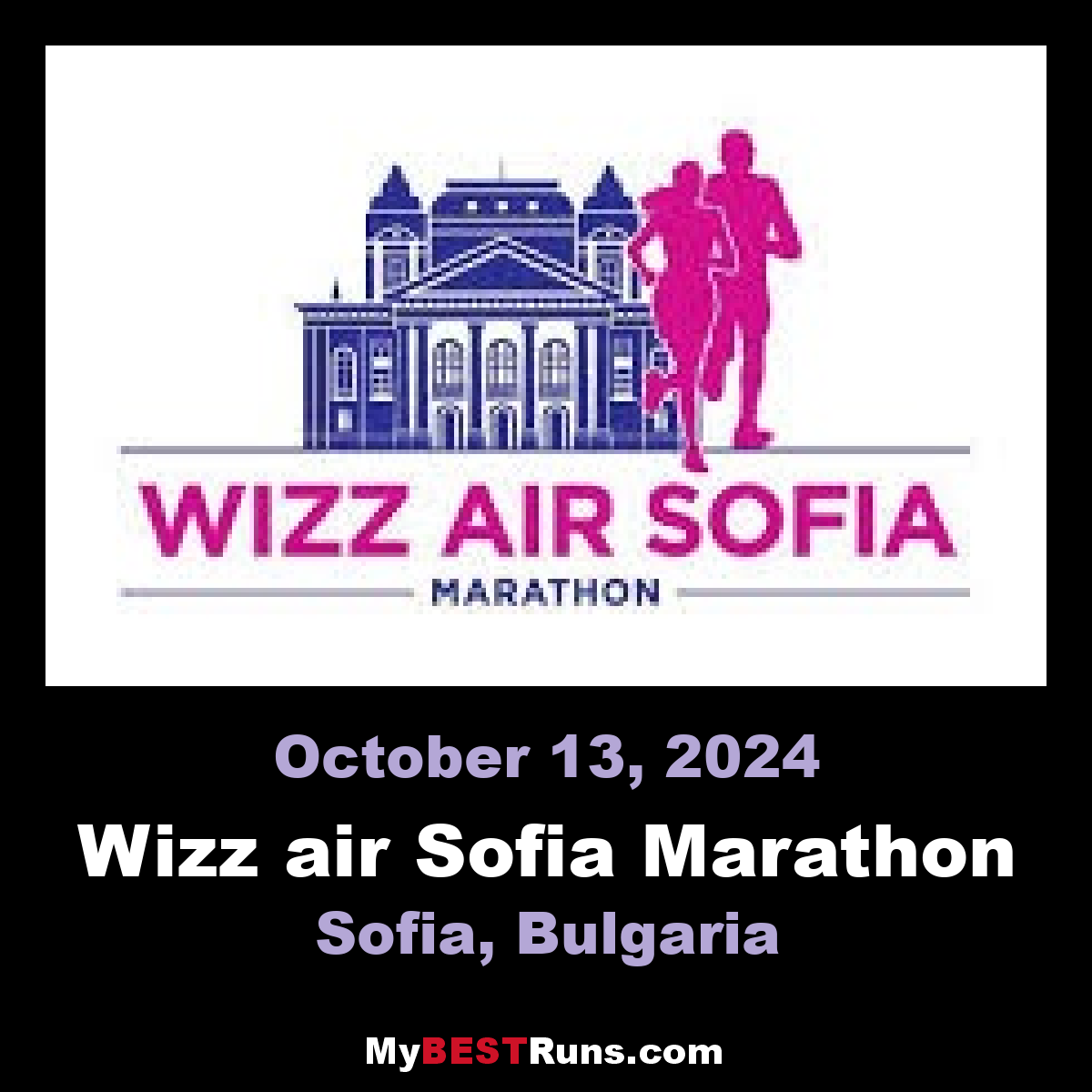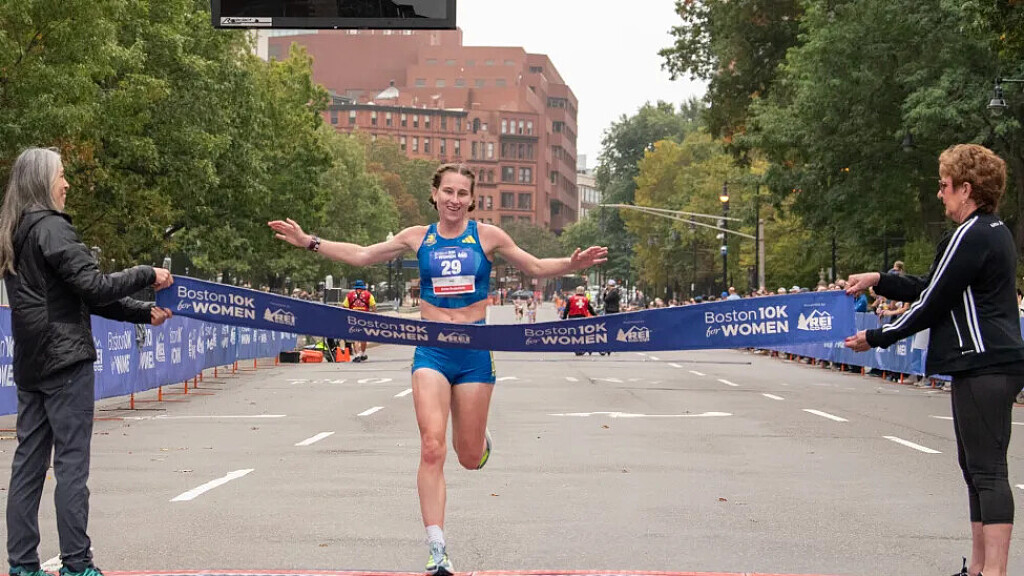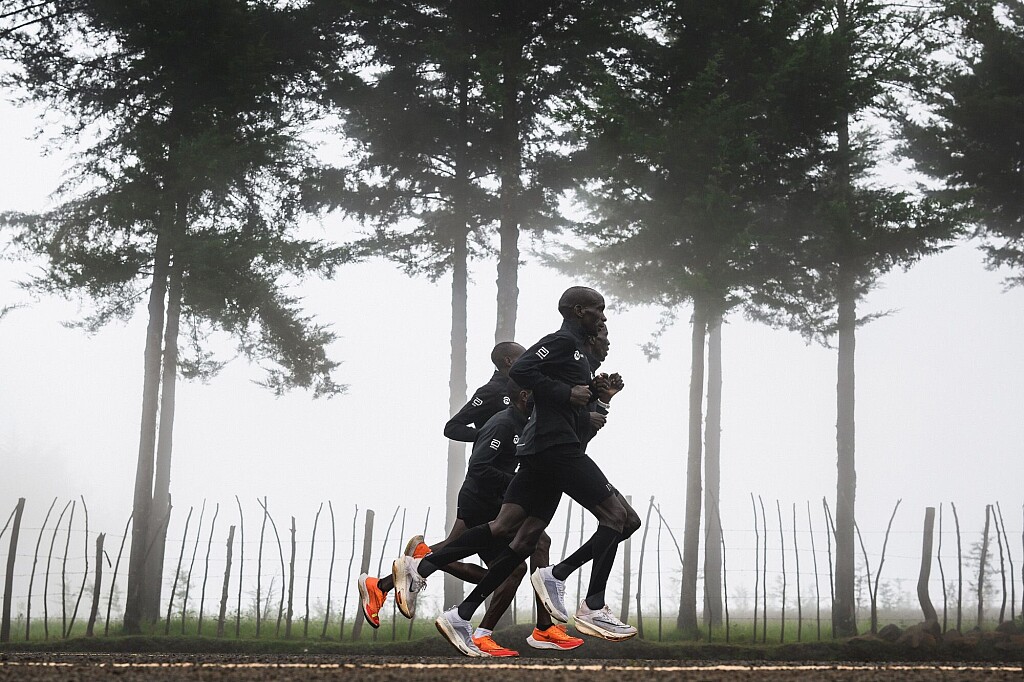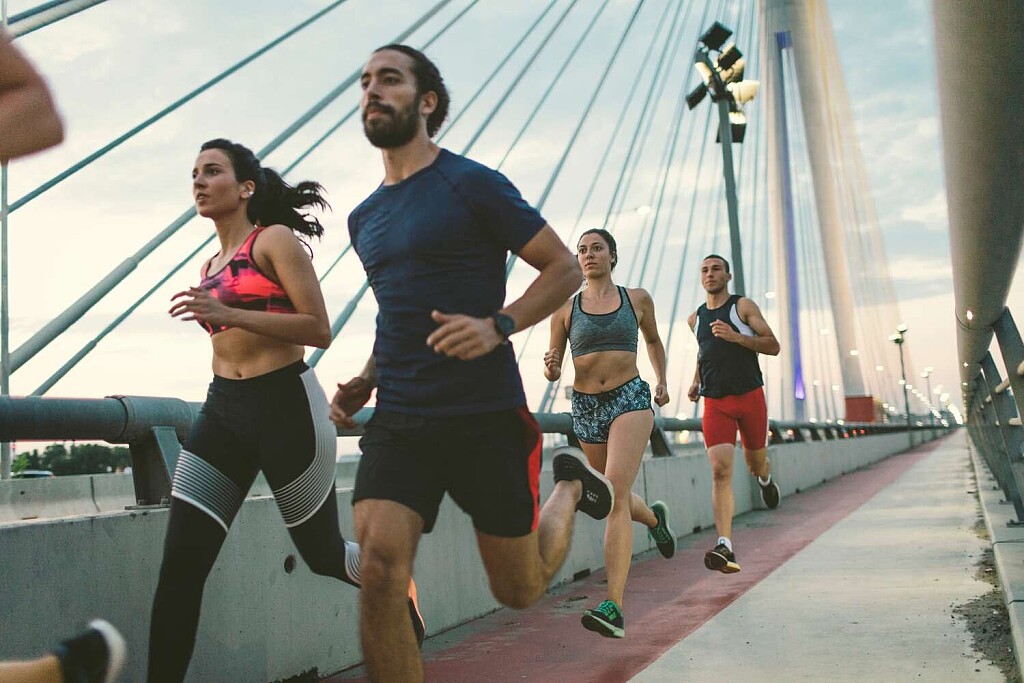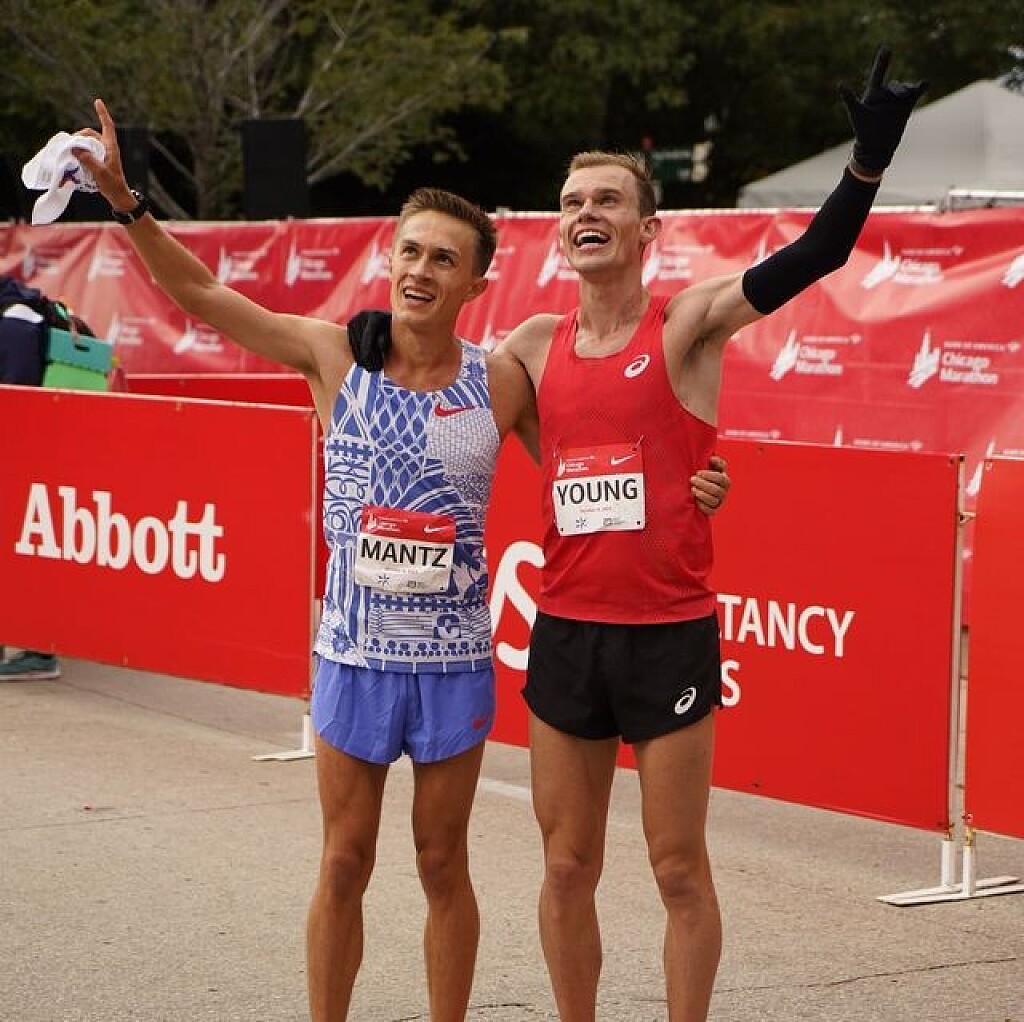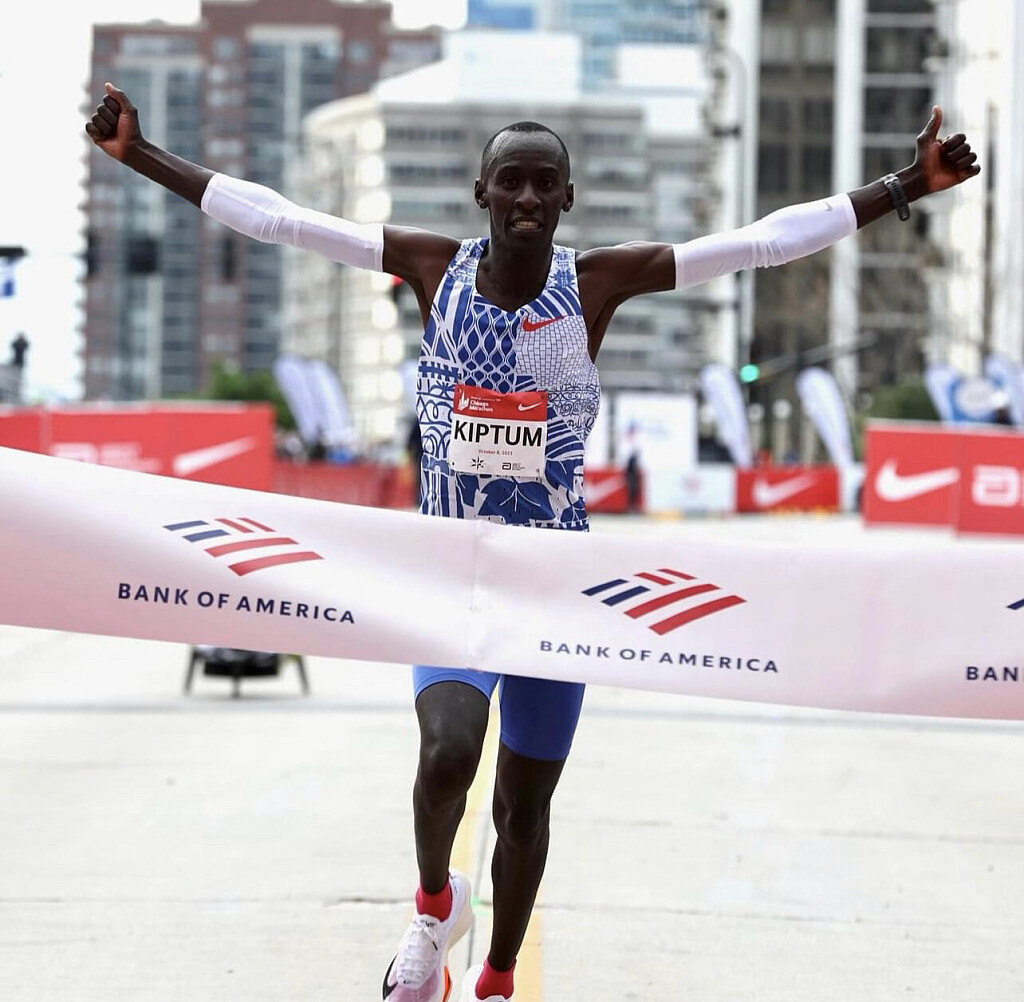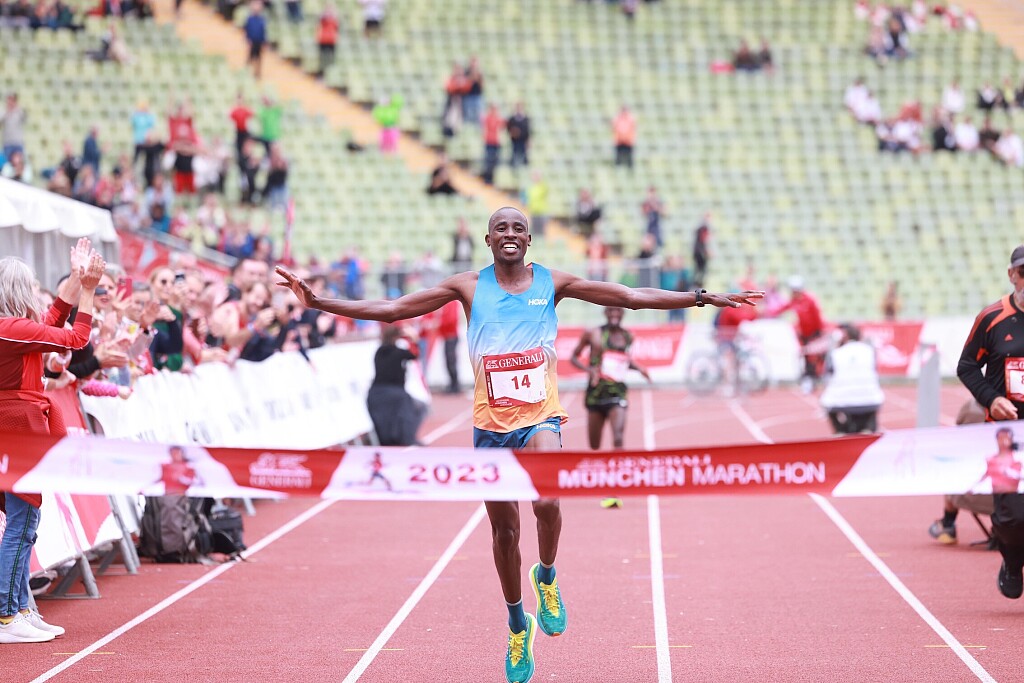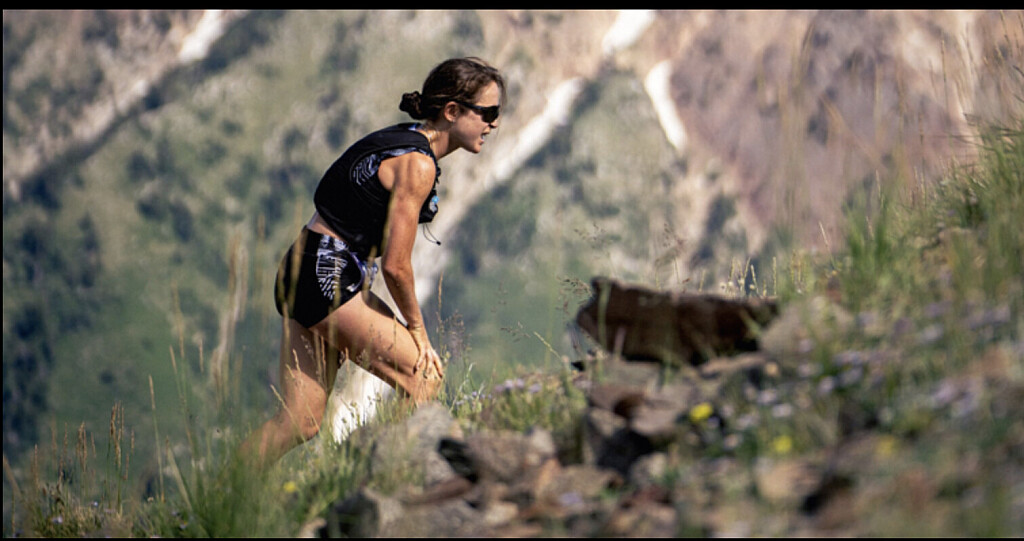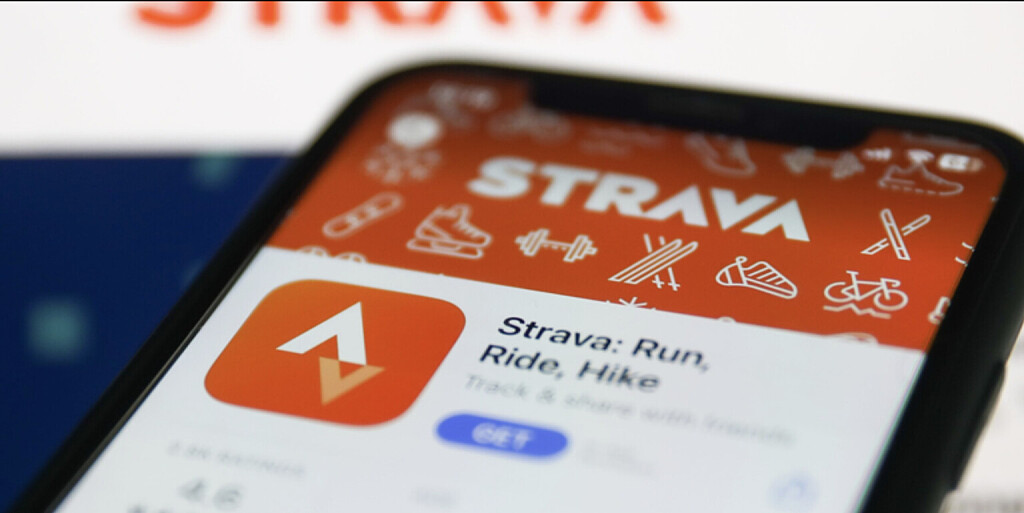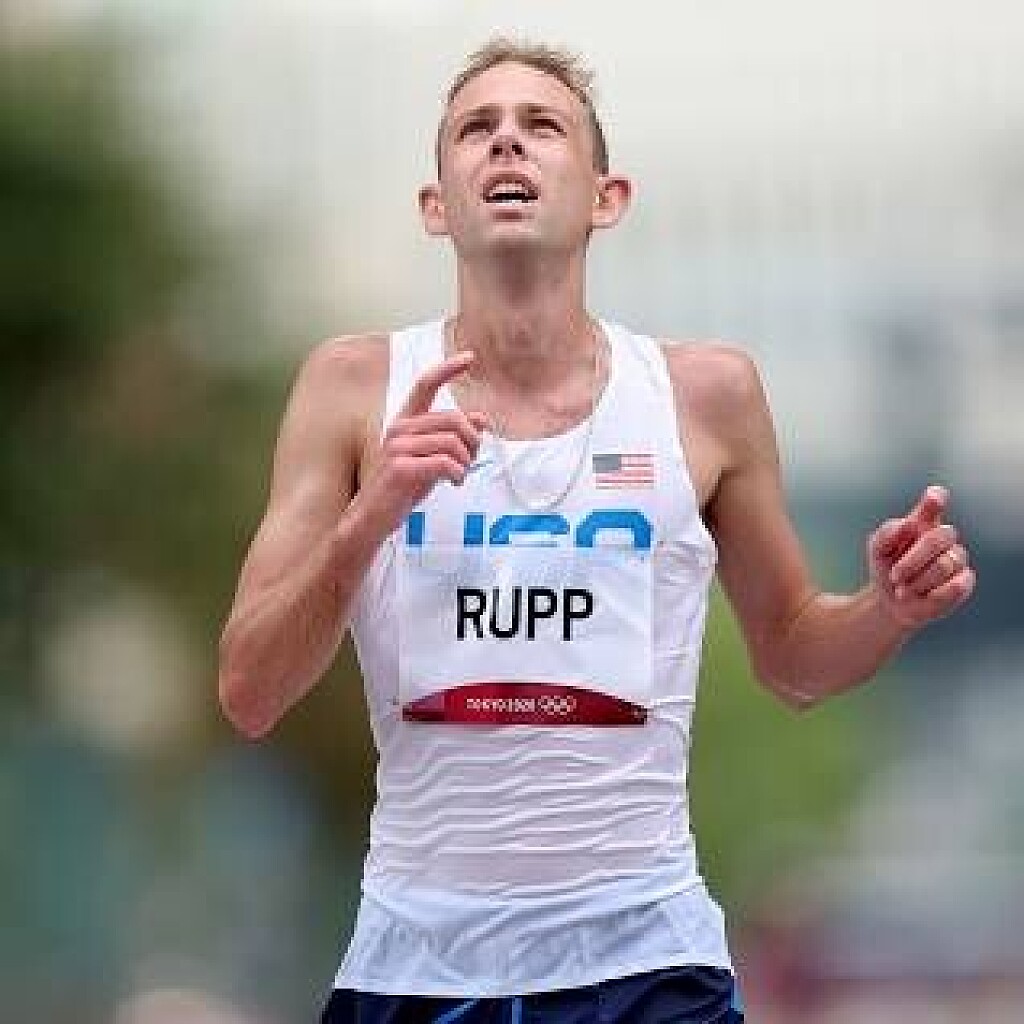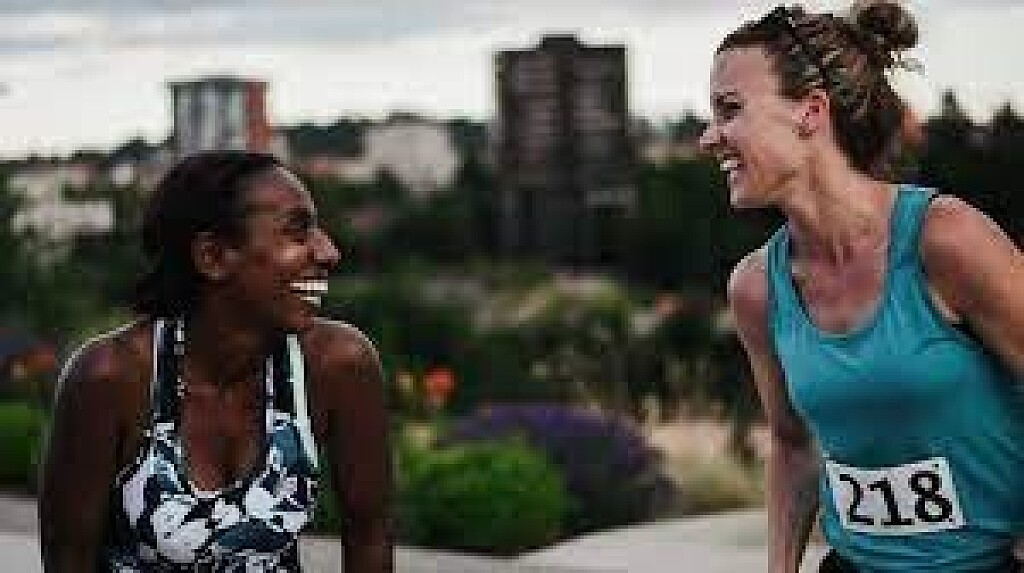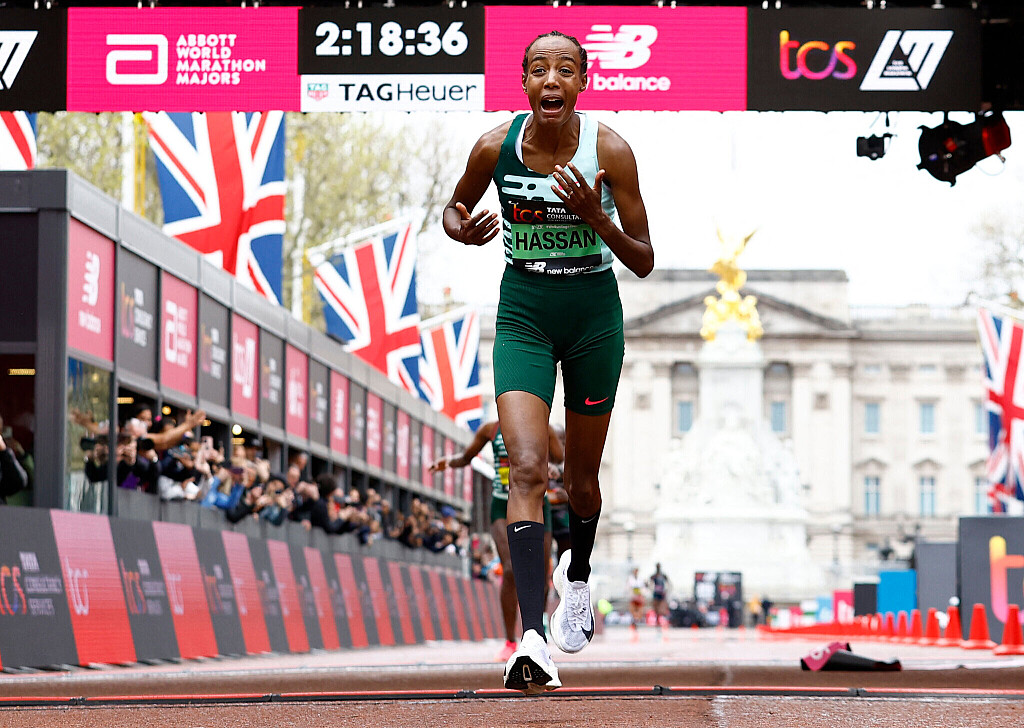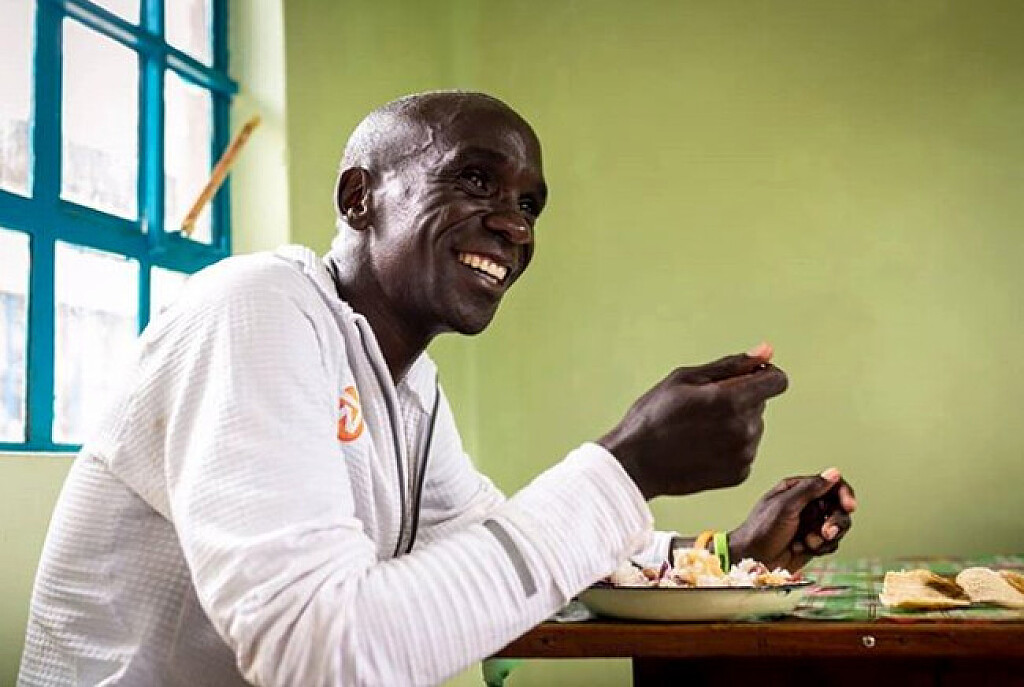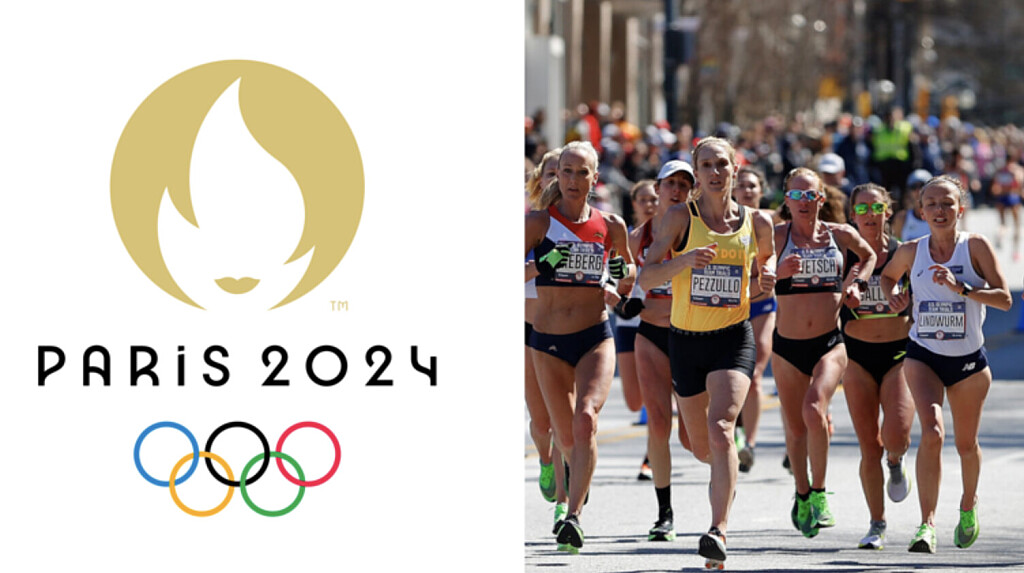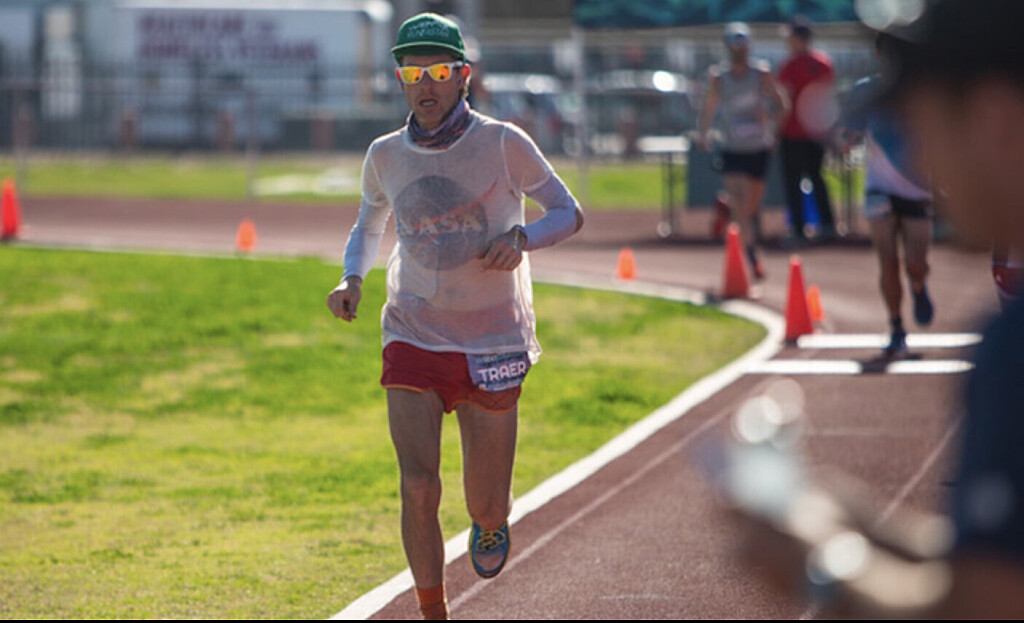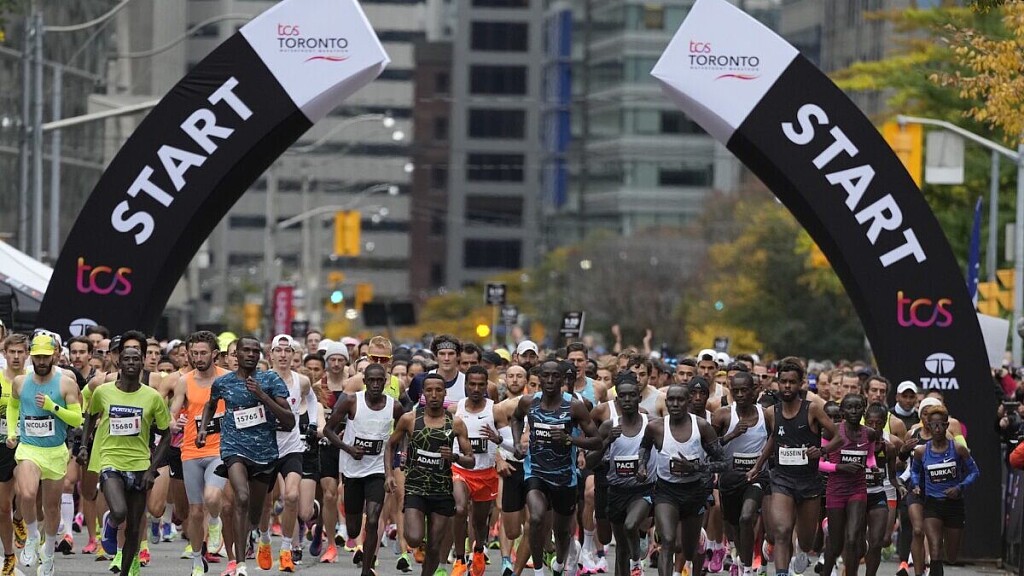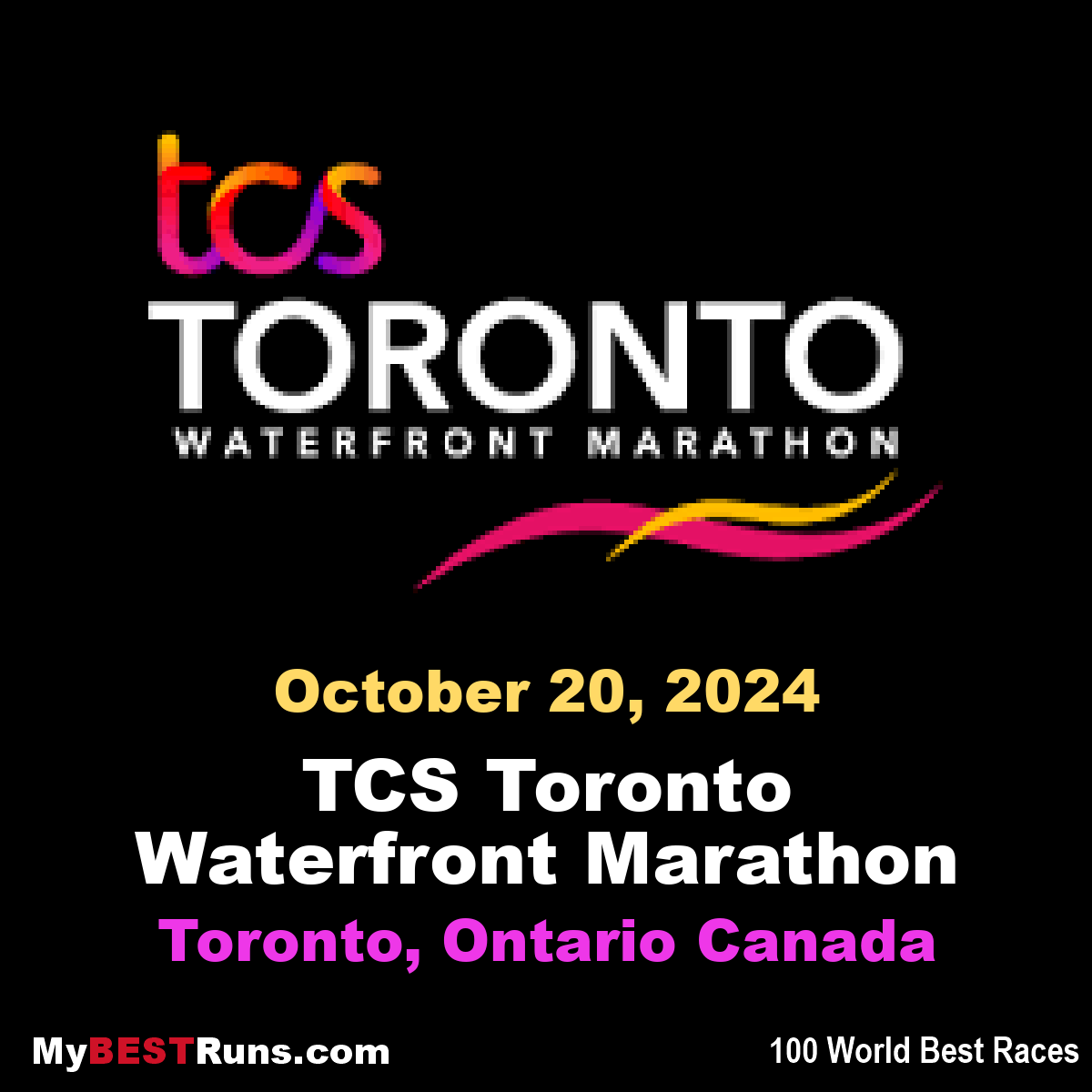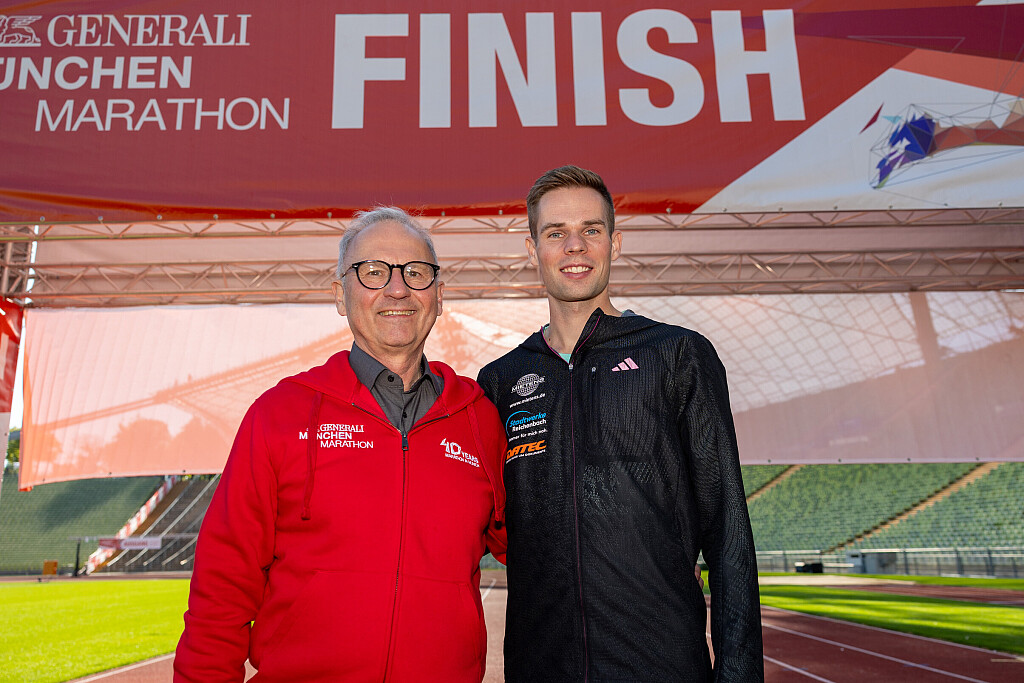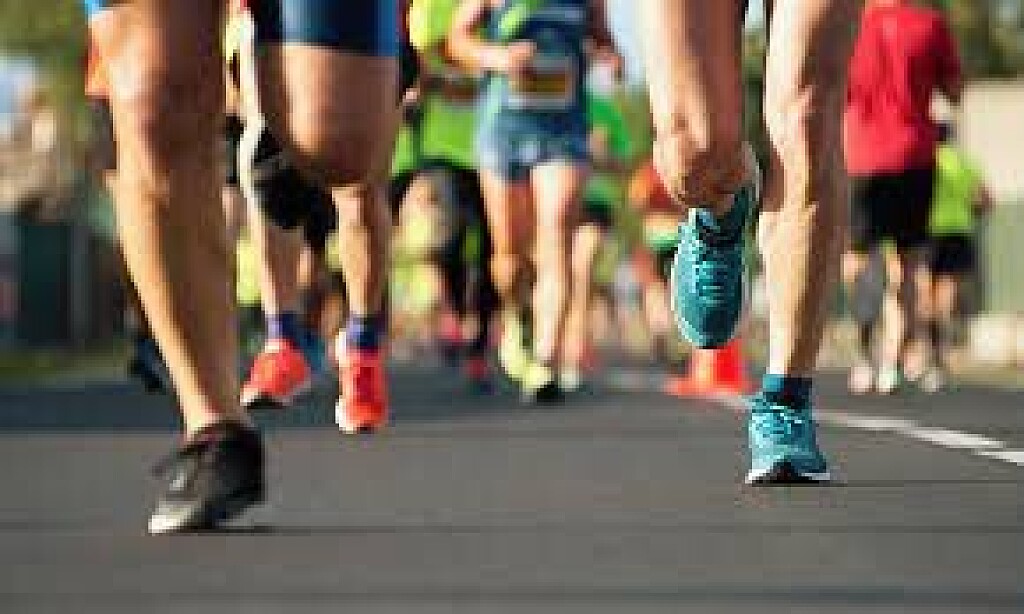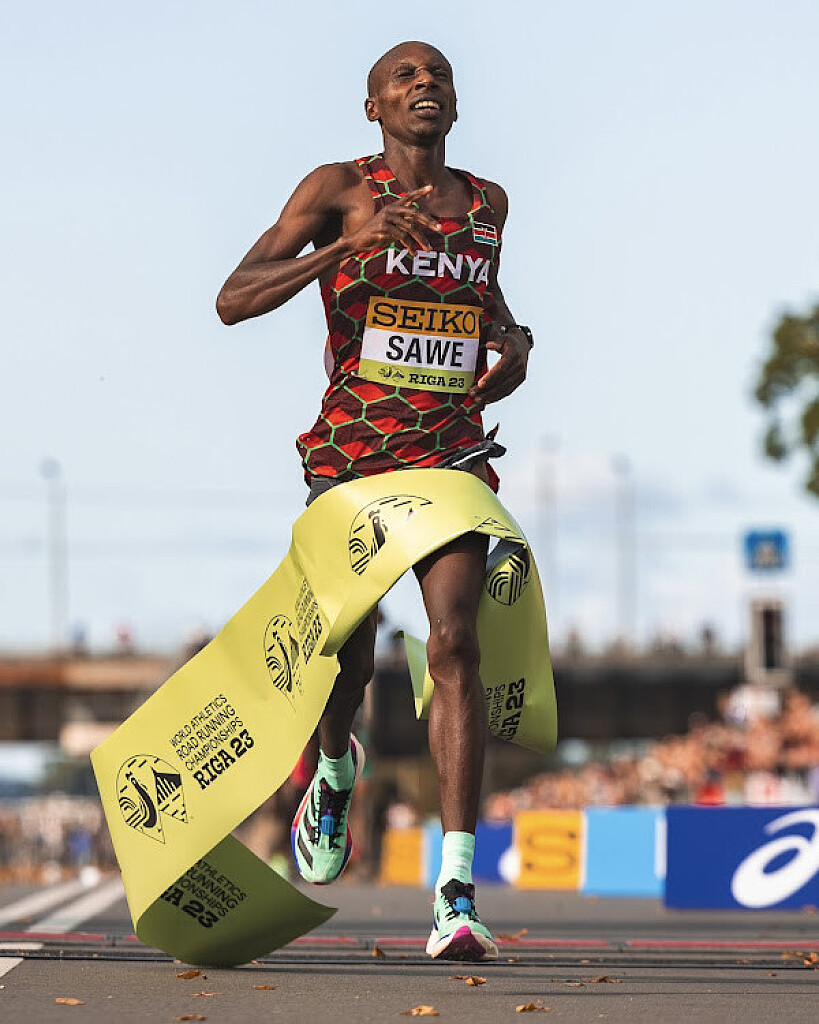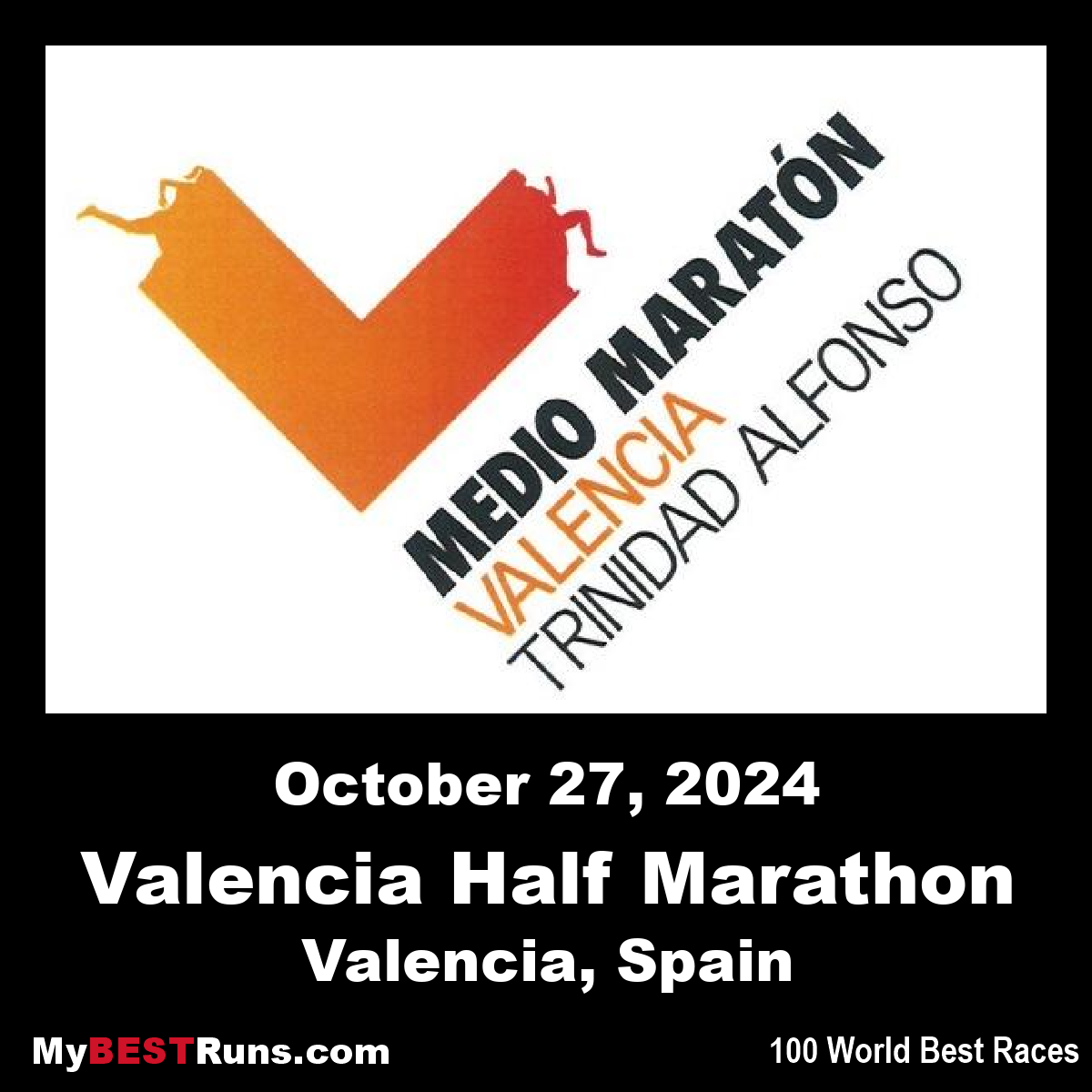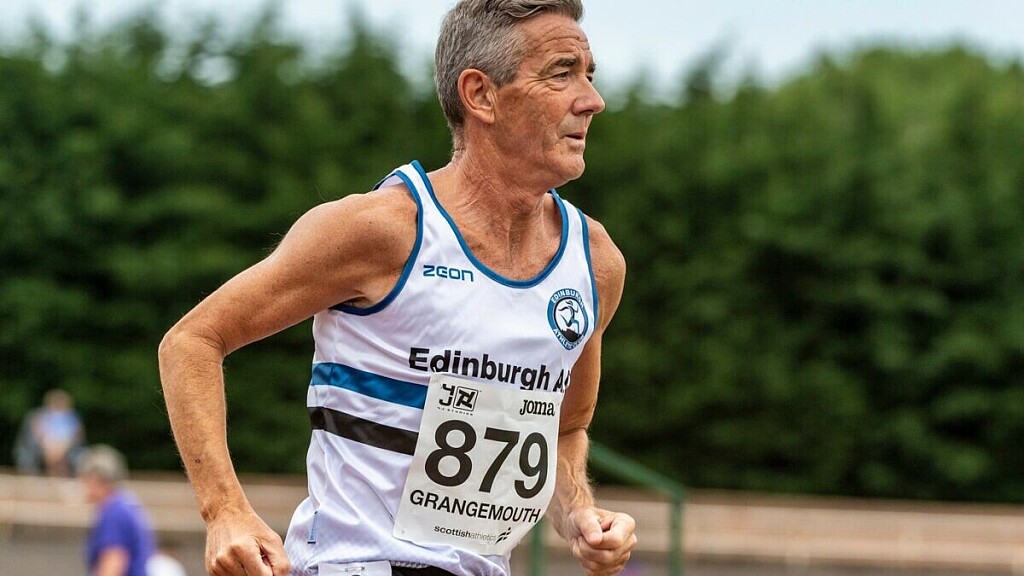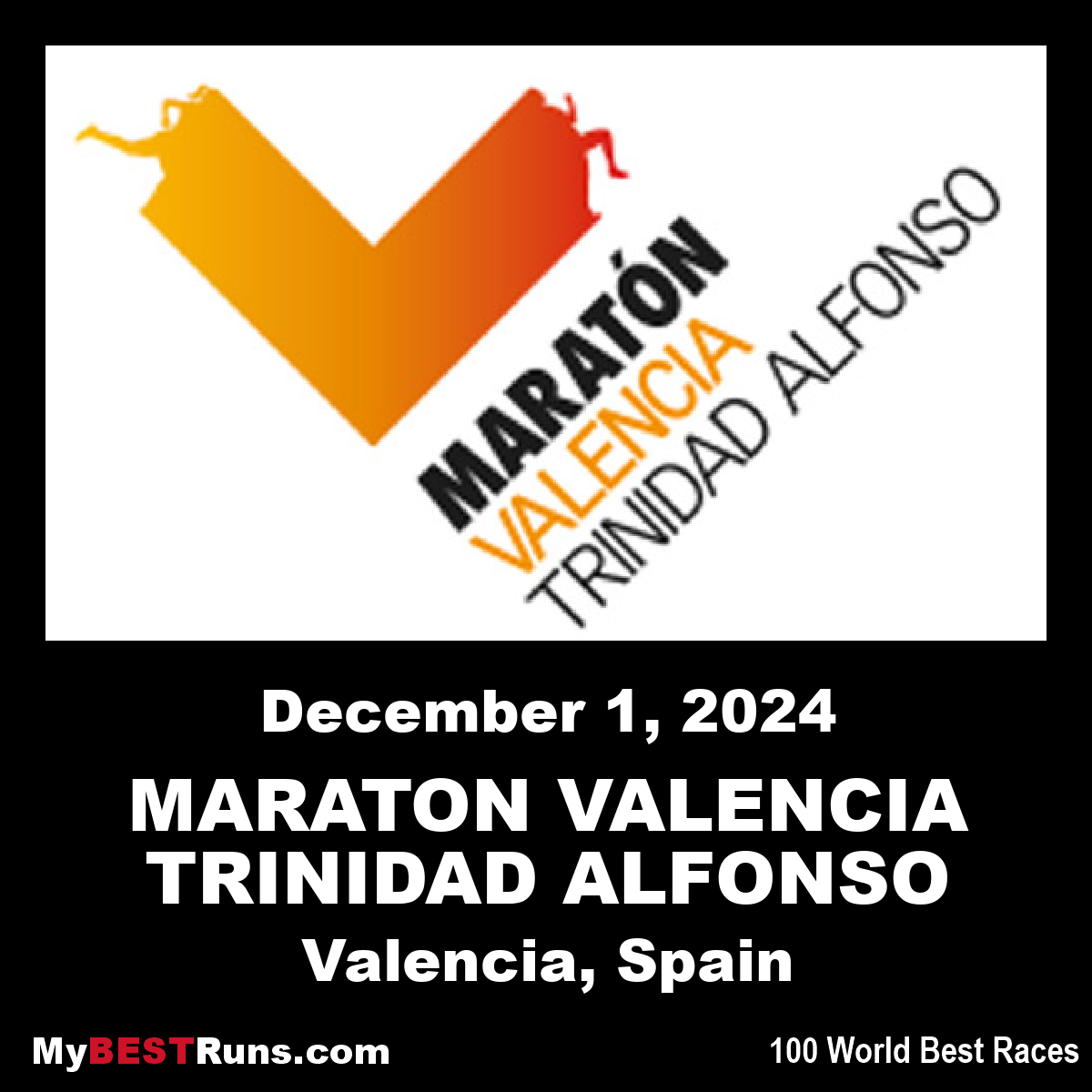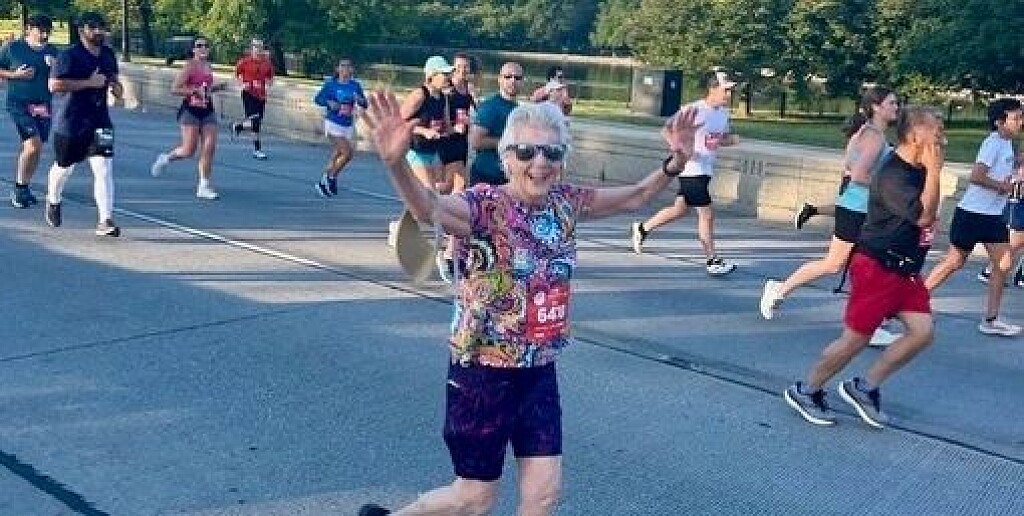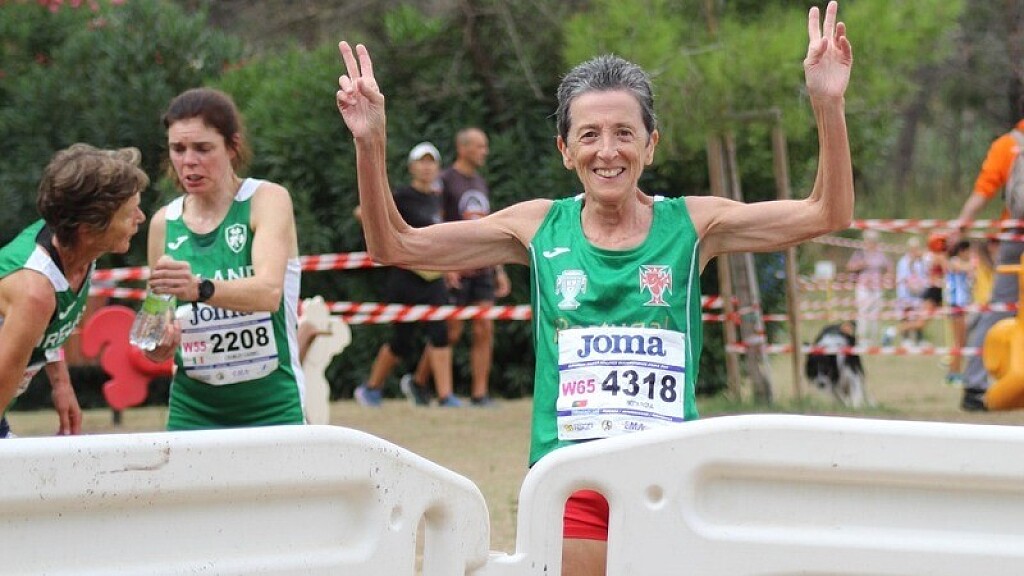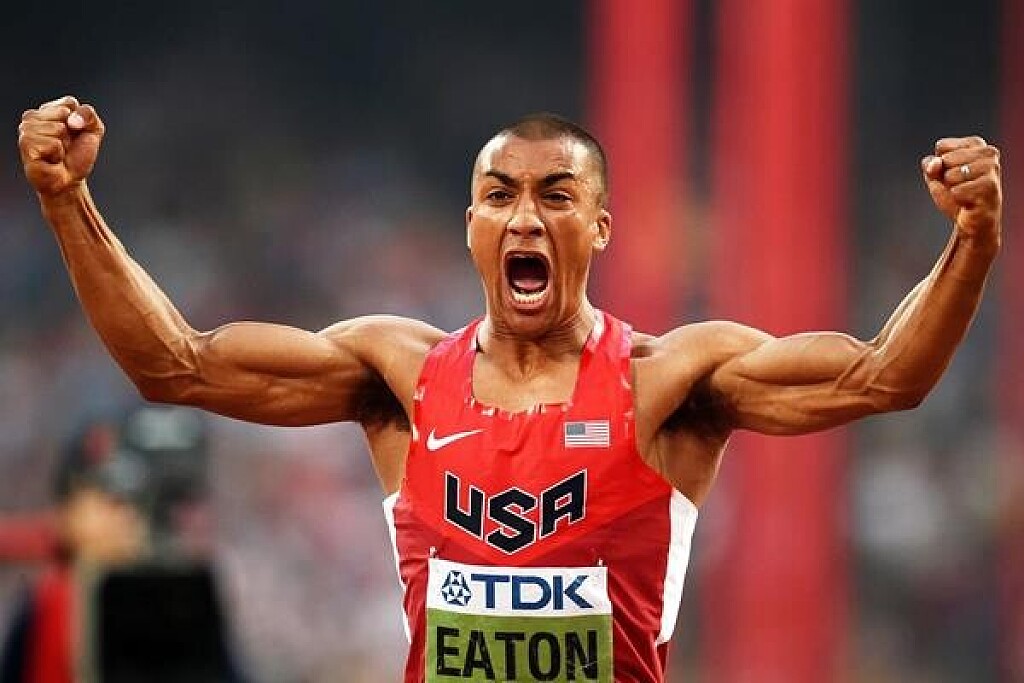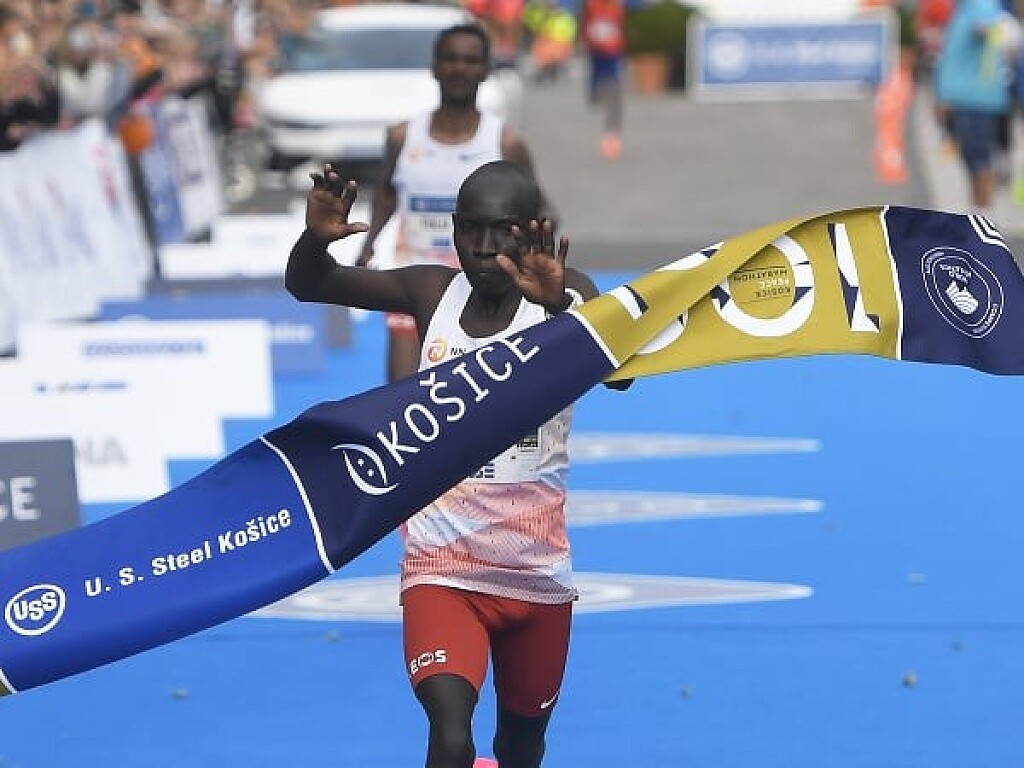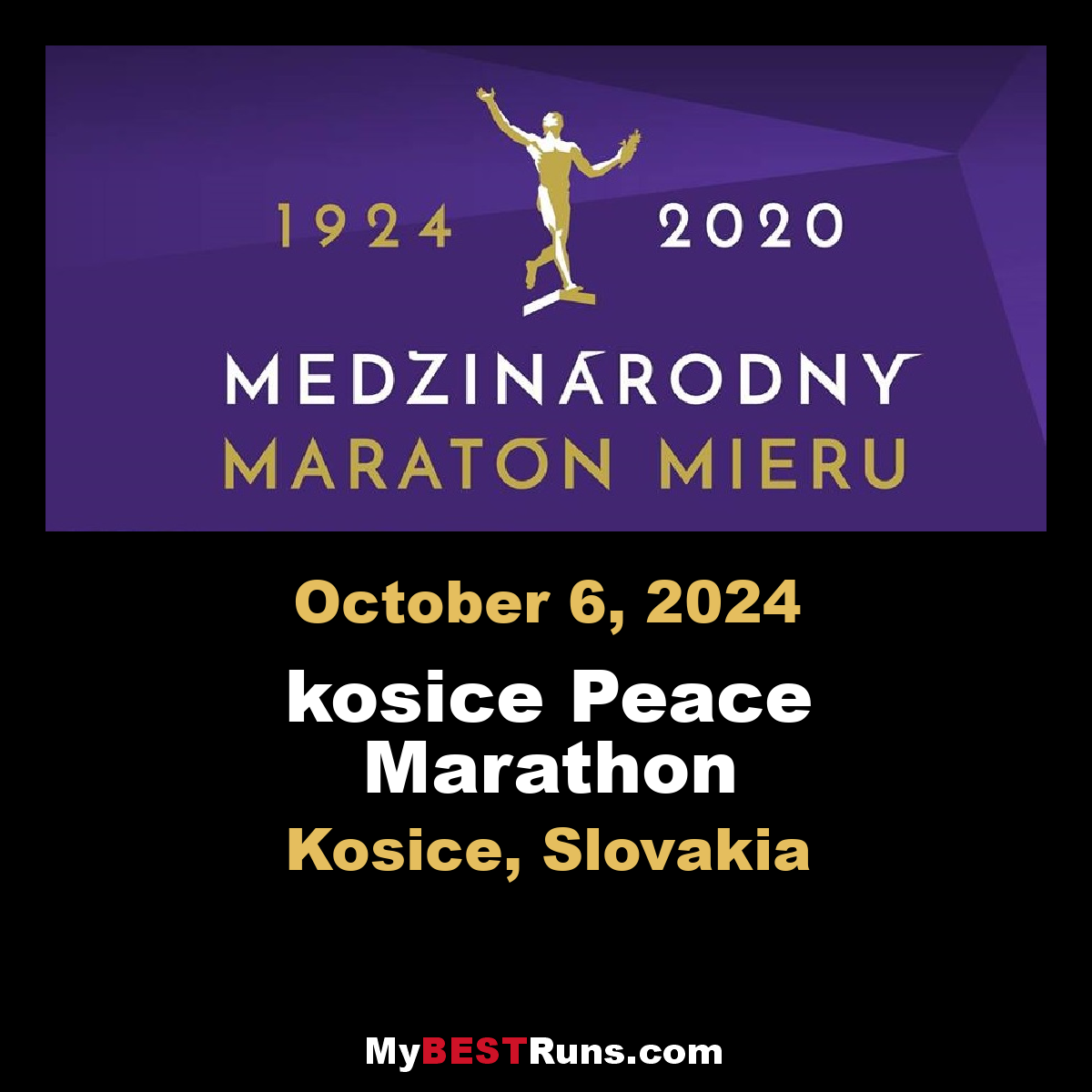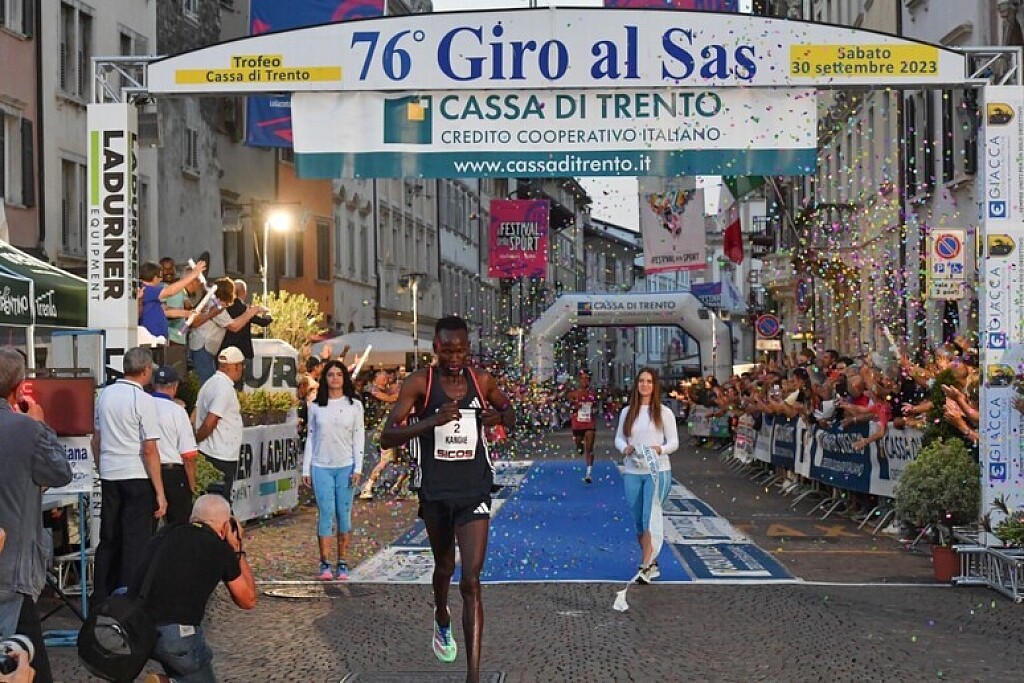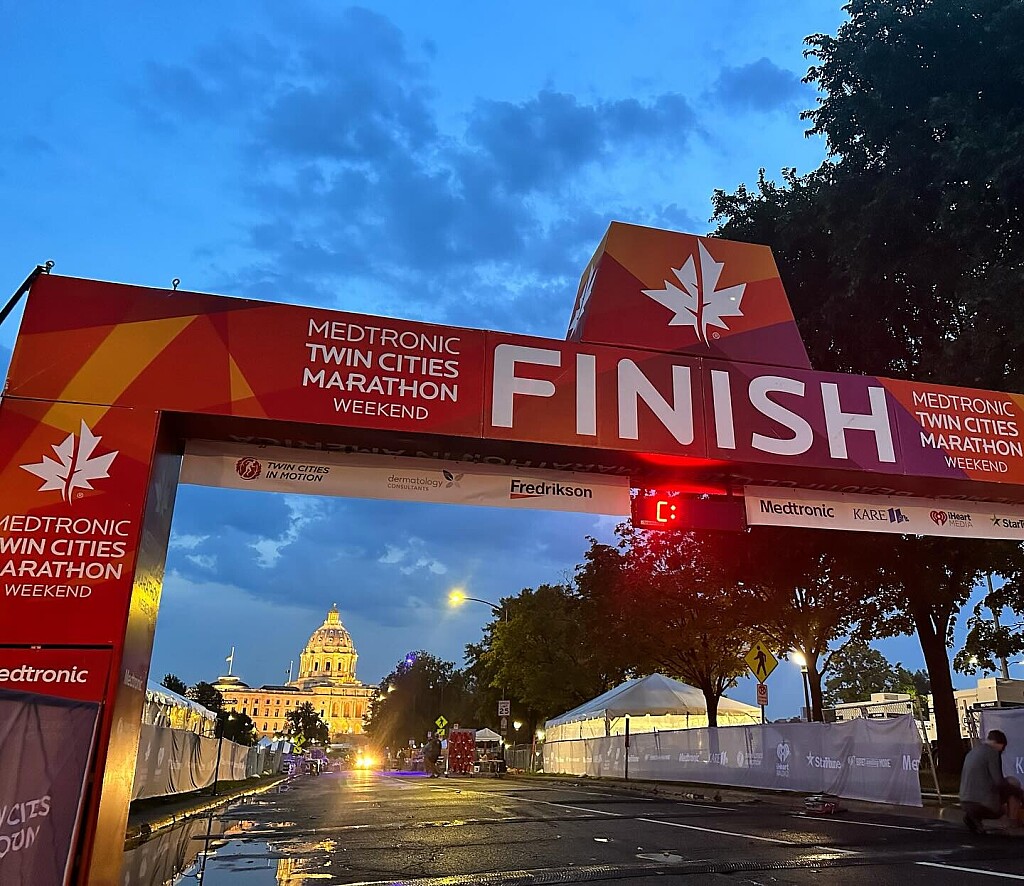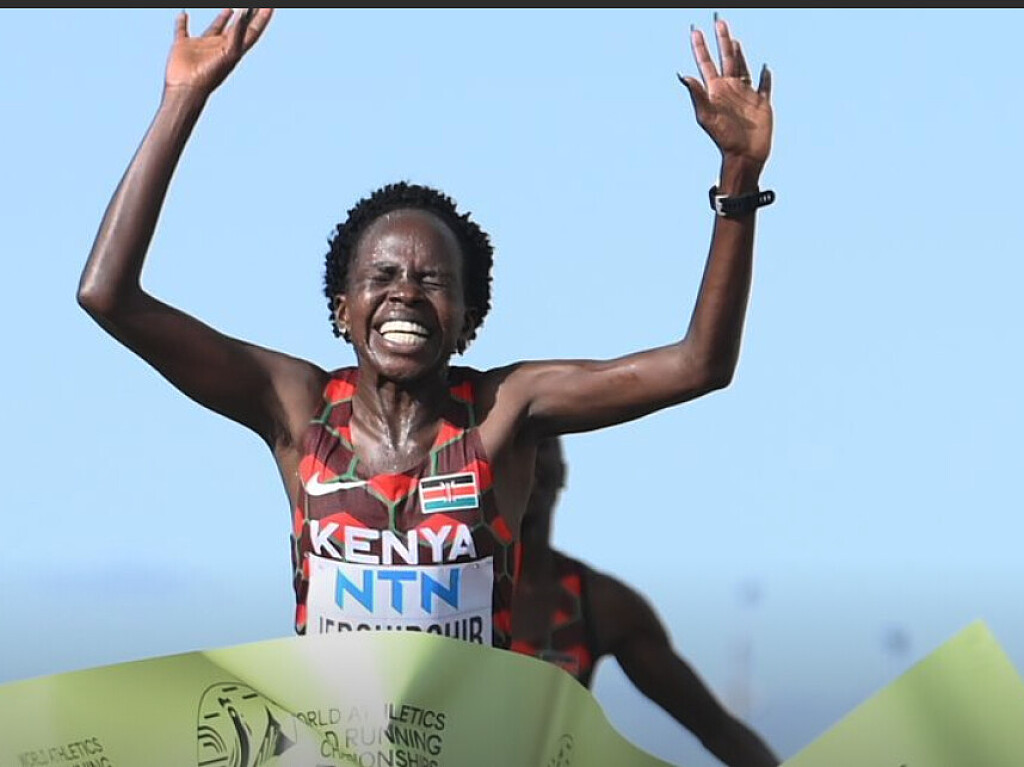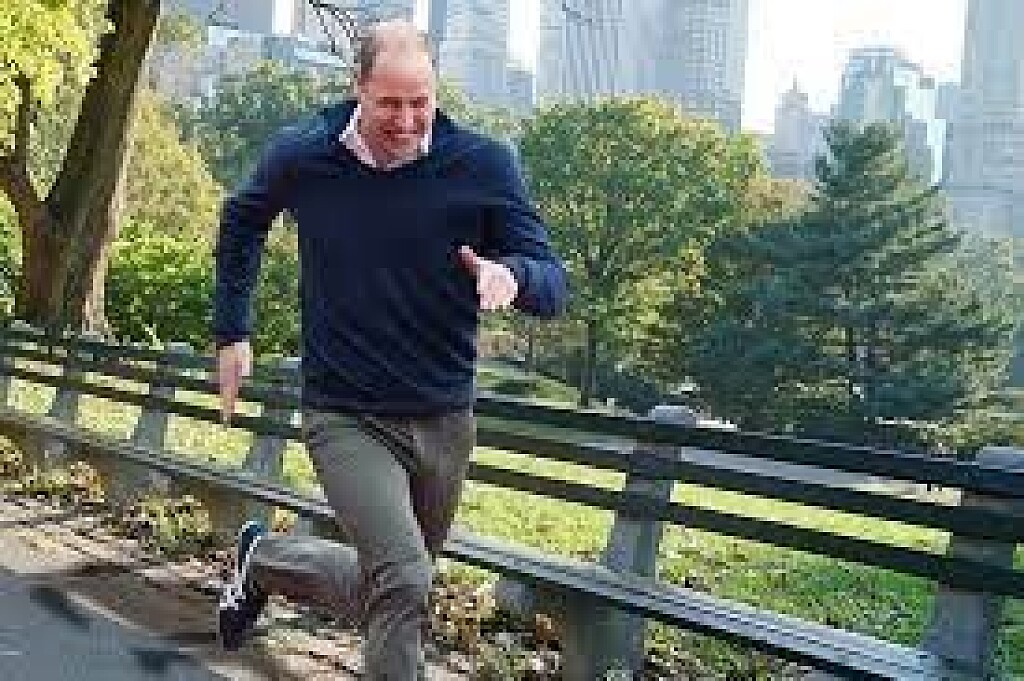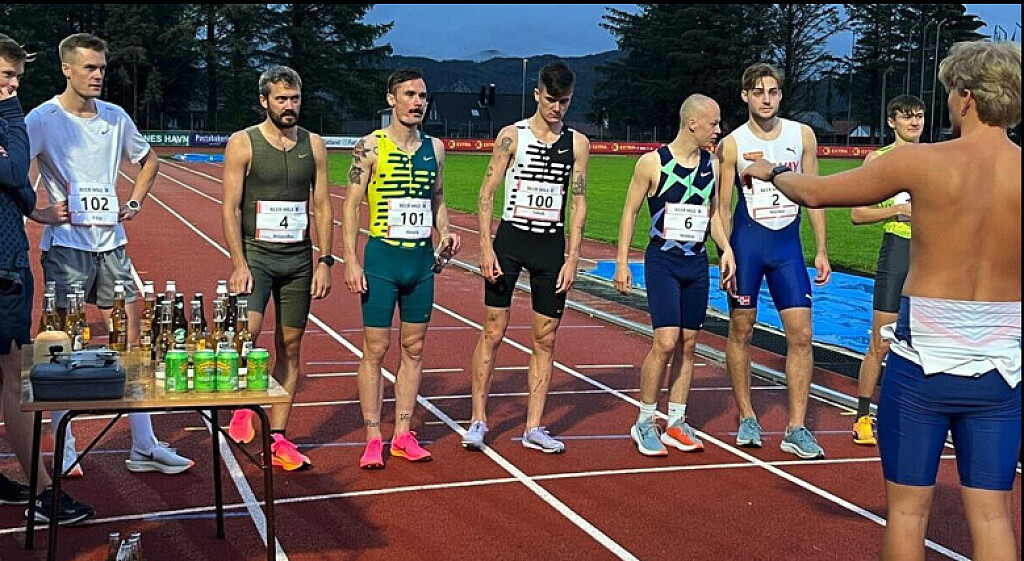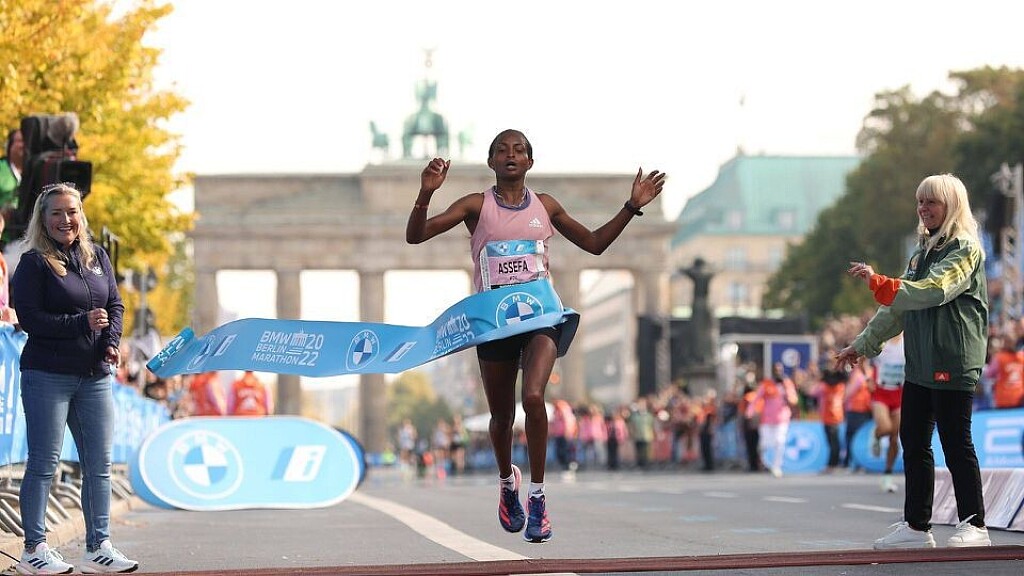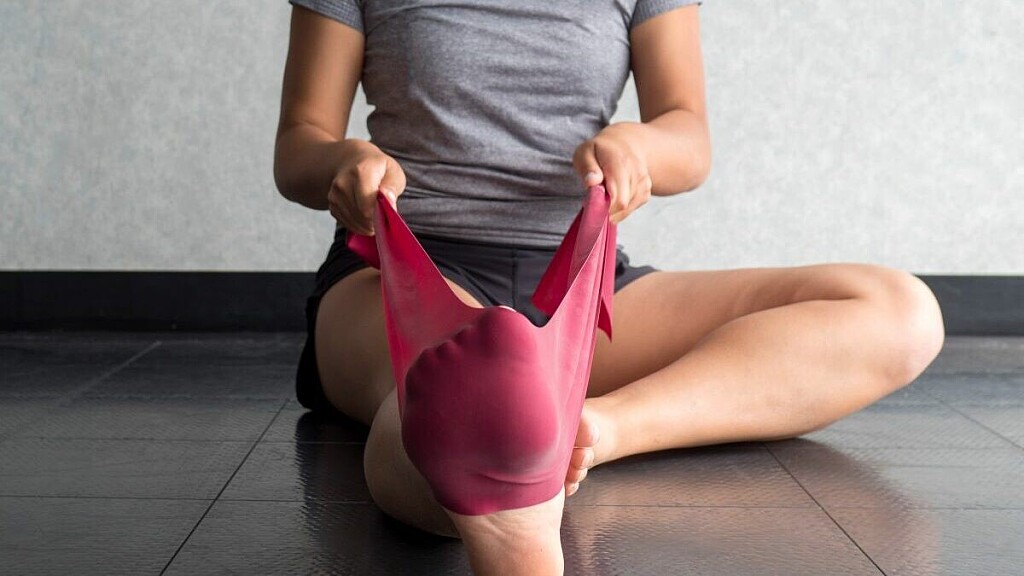Running News Daily
Running News Daily is edited by Bob Anderson in Los Altos California USA and team in Thika Kenya, La Piedad Mexico, Bend Oregon, Chandler Arizona and Monforte da Beira Portugal. Send your news items to bob@mybestruns.com Advertising opportunities available. Train the Kenyan Way at KATA Kenya. (Kenyan Athletics Training Academy) in Thika Kenya. KATA Portugal at Anderson Manor Retreat in central portugal. Learn more about Bob Anderson, MBR publisher and KATA director/owner, take a look at A Long Run the movie covering Bob's 50 race challenge.
Index to Daily Posts · Sign Up For Updates · Run The World Feed
Sisay Lemma and Zewditu Gelaw triumph in Ankara
Ethiopian duo are too good for the rest as they claim titles in Turkish capital’s first ever international half-marathon, writes Wendy Sly
Sisay Lemma and Zewditu Gelaw won the inaugural Runkara Half-Marathon, a landmark race for organisers in Turkey.
Until Sunday (Oct 8), Ankara had been the only capital city in the world without a road race event – despite a population of over six million.

Appropriately starting within a stone’s throw of the Ataturk Mausoleum – Mustafa Kemal Ataturk founded modern Turkey 100 years ago this month – the course looped around the western side of the city centre in glorious conditions.
The first ever international half-marathon in the Turkish capital had 4000 entries, including an eye-catching elite line-up.

Lemma, the 2021 London Marathon champion, was one of the standout names in the men’s race while home favourite Sultan Haydar looked to challenge Zewditu Gelaw and Roselidah Jepketer in the women’s field.
The men’s event saw Victor Mutai and Julius Kipchumba set the early pace as the leaders went through the undulating first 10km in 29:27. By the 12km mark a small group of six had broken away. They went through in 38:05 and at a solid pace, bearing in mind the hills and 860m altitude.
Bethwell Yegon, who finished second behind Guye Adola at the 2021 Berlin Marathon, battled Lemma for a large proportion of the race. Lemma continued to push hard and, around the 50-minute mark, with roughly 3km to go, broke away. The Ethiopian won by 18 seconds in a time of 61:09 ahead of compatriot Chimdessa Debele (61:27), while Kenya’s Vincent Nyageo 61:44 was third.
In the women’s race, Haydar – a former Ethiopian now running for Turkey – went through 10km in 32:01 (67:30 pace) along with Gelaw and Jepketer. Gelaw was the pre-race favourite and made her mark on the race when it mattered the most.
Running a strong last 6km, the Ethiopian finished in 68:28 to take first place, with Haydar (69:09) in second and Kenyan Vivian Kosgei (70:10), making her half-marathon debut, taking third.
The Runkara event is sure to go from strength to strength when finding its place on the international road racing calendar. Race Director Victoria Blyth was instrumental in putting it together, alongside support from RunCzech.
(10/10/2023) ⚡AMPby Athletics Weekly
Runkara Half Marathon
Runkara Half Marathon is a marathon planned at international standards and includes both amateurs and professional participants. This race brings together elite athletes from abroad and the city for you. 21 km is for those who really want to challenge themselves and love long distance running. “All runners are beautiful.” We run to push our limits, stay healthy and have...
more...Former european indoor 3000m champion Yelena Korobkina suspended for doping
Former European indoor 3000m champion Yelena Korobkina has been banned from international competition for four years for violating anti-doping rules, the Russian Athletics Federation reported.
Yelena Korobkina was suspended by a decision of the Court of Arbitration for Sport (CAS) on September 27. The reason is the use of prohibited stimulants.

In addition to the penalty, which expires on September 26, 2027, Yelena Korobkina’s results between July 2, 2013 and July 24, 2016 have been voided. Thus, the new European 3,000m champion for 2015 becomes Sviatlana Kudzelich from Belarus, but this has not yet been announced by the international federation.

The CAS decision most likely officially ends the career of Yelena Korobkina, who is already 32 years old.
Yelena Korobkina is a Russian distance runner who competes in events from 1,500m to 10,000m. She won the silver medal in the 1,500m at the 2013 Summer Universiade in Kazan.
(10/10/2023) ⚡AMPby Eli Semkova
Kenyans Mathew Kiplagat and Beatrice Toroitich won the 40th edition of the Wizz Air Sofia Marathon
Kenya’s Mathew Kiplagat won the 40th edition of the Wizz Air Sofia Marathon held on Sunday (08) in Sofia, Bulgaria
The 35 year-old took the honors in a new personal best time of 2:12.12 and was followed a distant later in second by Ethiopia’s Alem Niguse in 2:14.31 with Chakib Latrache from Morocco wrapping up the podium three finishes 2:15.43.

Kenya’s Hosea Kipkemboi, France’s Alaa Hrioued and Duncan Koech also from Kenya finished in fourth, fifth and sixth place in respective time of 2:21.36, 2:22.06 and 2:22.10.
Kenya’s Beatrice Toroitich won the women’s marathon title at the 40th edition of the Sofia Marathon held on Sunday (08) in Sofia, Bulgaria.

The 41 year-old took the honors in 2:38.26 and was followed by Bulgaria’s Marinela Ninova in second place in 2:41.02 with her compatriot Hellen Kimutai sealing the podium three finishes in a time of 2:49.07.
Gladys Biwott from Kenya and Ethiopia’s Sintayeho Kibebo finished in fourth and fifth in respective time of 2:51.43 and 2:55.58.
(10/09/2023) ⚡AMPby John Vaselyne
Wizz air Sofia Marathon
The home of Sofia Marathon was founded thousands of years ago and today it continues to develop as the country’s cultural and economic centre. Sofia is Bulgaria’s capital and one of the oldest capitals in Eastern Europe.Sofia has been settled for many millennia. In honour of its hot springs, which you should visit after running the marathon in Sofia, in...
more...Annie Rodenfels Wins Boston 10k For Women
The 47th running of the Boston 10K for Women, presented by REI, returned to the Boston Common and the streets of Boston and Cambridge on Saturday.
Over 4,000 women participated in the autumn classic, which began at 8:50 a.m. for handcycle and wheelchair participants and at 9 a.m. for all runners.

Formerly known as the Tufts Health Plan 10K for Women, the race is New England's largest all-women's sporting event.
The 6.2-mile course brings runs through Boston’s Back Bay and into Cambridge and finishes on Charles Street between the Public Garden and Boston Common.

This year's race was won by Annie Rodenfels, who broke the tape in her 10K debut in a time of 32:08. She was followed by Emily Venters with a time of 32:31 and Jenny Simpson at 32:39.
A Boston resident, Rodenfels surged on the Massachusetts Avenue bridge and ran uncontested through the last mile until the Charles Street finish line.
“I thought I would sit back and wait and out-kick them at the end, like -- their mistake if they leave me until the end -- because besides maybe Jenny Simpson I think I’ve probably got the best kick in the field,” Rodenfels said afterward, with an American flag draped around her shoulders. “But I just felt too good, I figured I’d just go for it. What do I have to lose?”
For Rodenfels, who trains along the banks of the Charles River, the familiarity aided her approach in the new distance.
“I like the course a lot – I love running in Boston, I feel like I can have a mediocre year the rest of the year and then when I get a race in Boston, I knock it out of the park. I feel like I get more cheers because I am from around here,” said Rodenfels, who earned $9,000 with the victory.
Winning the Masters Division and finishing 11th overall was Sara Hall, who clocked a 33:19. Fourteen-year-old Madelyn Wilson won the wheelchair division in a time of 35:50, racing for the first time in a larger chair.
(10/09/2023) ⚡AMP
Boston 10K for Women
The Boston 10K for Women, formerly known as the Tufts Health Plan 10K for Women and the Bonne Bell Mini Marathon, is a major 10K held annually in Boston, on Columbus Day, popular as both an elite world-class competition and a women's running event promoting health and fitness. Feel the empowerment as you unite with over 7,000 fellow runners...
more...Lessons from the long run: with Kipyegon, Kipchoge and Sang
The long run, for elite and amateurs alike, forms an integral part of distance runners’ training.
In the west of Kenya, 20km to the south-east of Eldoret, that weekly ritual takes place early on a Thursday morning.
At 6am sharp the first runners make their way out of the gates of the Global Sports Communications Camp in Kaptagat to join some local runners who will try to keep them company.
In the pitch-black late June morning, the runners have already woken up half an hour or so before to get dressed, take some sips of water and go to the toilet.

The 30 or so athletes do not eat beforehand. They have determined that there are benefits to running fasted, the most prominent being training your body to get better accustomed to taking energy from your body’s fat reserves, something that may be important when carbohydrates sources are depleted towards the end of a marathon.
Of course, these are experienced athletes. For the double Olympic champion making his way to the group, he has spent 20 years building up and adapting his body to such challenges.
What is possible for Eliud Kipchoge would be simply unsustainable, and even ill-advised, for athletes new to the sport.

This particular morning, coach Patrick Sang has assigned the ‘Boston loop’ – an undulating route with far more elevation than its namesake marathon, eventually finishing high on the escarpment a few hundred meters higher than the 2200m starting elevation at Kaptagat.
For the Global Sports group, it is simply 40km straight out; the minibuses and pick-up trucks following them picking them up after to drive them home.
Most of Sang’s athletes training for an autumn marathon are expected to complete the full distance, among them three-time world cross-country champion Geoffrey Kamworor, fellow 2:04 marathon-man Kaan Kigen Özbilen, Kipchoge and a collection of five others all boasting either sub-60-minute half marathon or sub-2:07 marathon bests.
World and Olympic medalist Linet Masai and 2:20 marathon runner Selly Chepyego, setting off 15 minutes beforehand, have also been set that distance goal.
For world and Olympic champion and multiple world record-holder Faith Kipyegon, today’s task is 30km. Despite being on the longer end of what might be expected from a 1500m runner, Kipyegon is insistent that this run is her favorite type of training.
It may also be some indication of the strength shown in her 5000m world record in Paris.
Sang’s final instructions are minimal. He does not prescribe paces, simply asking that his athletes set an honest pace, go on how they feel and try if possible to pick up the pace towards the end of their run.
The early footsteps are on a dirt road, the group paying attention to where their marathon-specific shoes land and running in silence. Information about tree routes or dips in the road is often communicated via hand signals pointing to the hazard.
From the off, the going is uphill and within 10km the group is receiving the first of their carbohydrate drinks being passed from the pick-up truck following them.
After 15km the group hits the first of the tarmac roads of the C51 and the pace then starts to rise, slowly and subtly.
As they do, they gradually catch the groups ahead of them.
Geoffrey Kirui, the 2017 world marathon champion, has been told to run by himself as he is returning from an injury. Sang has intentionally encouraged Kirui not to fall into the usual pitfalls of over-exerting himself to go with a group.
Likewise Daniel Mateiko – the ninth fastest half-marathon runner in history, boasting a 58:26 best – was told to set off a few minutes before and will then join the group up to about the 35km marker. Still only 24 years of age and racing over a shorter distance, Mateiko’s training has its own minimal differences with the shorter-distance athletes generally doing shorter long runs.
Throughout the run, Sang will come alongside in the pick-up, judging his athletes’ efforts from the way they run. He later tells us he can notice minor indications from the way they land their feet on whether recent training has taken its toll.
Little advice is given; those he coaches have done this route many times before. More welcome instead are the drinks passed around every 5km or so. The group stays intact for almost 30km before it slowly fragments, Sang encouraging his athletes to sustainably push their effort over the final kilometers.
Kipyegon herself is nearing the end of her run, gradually progressing throughout the 30km but not pushing herself to the point of depletion.
Unfortunately for her, the moment her watch completes the distance, a few minutes over two hours after she began, is almost the highest point the group will reach that day.
She stops, jogs slowly for a few hundred meters before jumping in the van.
About a litre of carbohydrate drinks consumed after her run, she will not eat until an hour or so later when the whole group returns to the camp.
A long line of runners scattered along the road has yielded to a few isolated pockets completing the full distance and the leading group has whittled down to four.
Though interspersed with steady rises, the final five kilometers are slightly downhill. Kipchoge, Özbilen, Laban Korir and Hillary Kipchirchir run four abreast, completing these last kilometers in a few seconds inside 15 minutes.
Two hours 22 minutes after they started, they finish their undulating 40km with over 500m of elevation at a pace about 30 minutes slower than their best marathon times. It is an effort they might refer to as ‘steady’ and one in the midst of a typical 220km training week.
Like Kipyegon, they consume about a litre of drink as they get in the vans and make the 40-minute journey home, eating a nutritionally simple meal of beans, ugali, vegetables and some protein upon their return.
Their reward? A rare afternoon without another run, some sleep and a lighter Friday of two short easy runs.
A similar routine in a different setting to runners throughout the world, there are morsels of lessons for the everyday runner.
Progress sustainably, hydrate appropriately and perhaps trust your effort over your watch.
(10/09/2023) ⚡AMPby George Mallett for World Athletics
Three progression workouts to transform your training
If you have ever started off strong on race day but found yourself falling apart at the closing stages, a progression run may be the ticket to elevating your performance. In a traditional progression run, a runner starts at an easy pace and gradually increases their speed throughout the run, finishing faster than they began. The progression training session aims to train the body to run efficiently, and to build endurance while gradually increasing the effort level.
Progression workouts are versatile and fun to switch up: run them by pace or by Rate of Perceived Exertion (RPE), on trails or on roads, and adjust the distance and time to suit any goals.
Because your body is properly warmed up in a progression session before you begin any tough effort, you have a lower risk of injury than in many other hard-and-fast traditional speed workouts. You’ll also recover more quickly from a progression session than you would with faster-paced intervals. We have three progression workouts you can slide into your training schedule this week–you’ll reap the rewards with tireless legs next race.

For all of these workouts, make sure to use the beginning of the run as your warm up, taking it very slow and easy.
1.- Thirds progression run

A thirds progression run gives your aerobic capacity a boost while you practice managing steady pacing, and simulates using discipline during the initial stages of a race.
For this workout, break up your run into three equal parts. It doesn’t matter whether you train using distance or time; split the total up accordingly.
Begin running at an easy pace and gradually speed up as you enter the next third of your run. Make sure your speed changes are slight and not abrupt: each pace should feel sustainable.
If your progression run is scheduled for 60 minutes, run the first 20 minutes at an easy pace, the next 20 minutes at a race pace, and the last 20 minutes at a pace that is 10 seconds faster than your race pace.
Cool down with five minutes of very easy running.
2.- Fast finish progression run
Finishing a progression run quickly will help you crush that fast race-day kick. This workout is the perfect way to push mind and body to simulate racing conditions, without overtaxing yourself, and needing extra recovery time.
Start out at an easy pace or effort and extend that throughout most of this session, leaving only four to six minutes at the end for your hard effort. The final few minutes of this workout should be a much harder effort than in your other progression runs because the fast running time is much more limited.
Think of your 5K race pace or effort for the last section.
Cool down with five to 10 minutes of very easy running.
3.- Fast finish progression run
Finishing a progression run quickly will help you crush that fast race-day kick. This workout is the perfect way to push mind and body to simulate racing conditions, without overtaxing yourself, and needing extra recovery time.
Start out at an easy pace or effort and extend that throughout most of this session, leaving only four to six minutes at the end for your hard effort. The final few minutes of this workout should be a much harder effort than in your other progression runs because the fast running time is much more limited.
Think of your 5K race pace or effort for the last section.
Cool down with five to 10 minutes of very easy running.
(10/09/2023) ⚡AMPby Keeley Milne
Two American men achieve the Olympic standard at Chicago Marathon
The American contingent was led by Conner Mantz, who finished sixth overall and ran a personal best of 2:07:47. His former BYU teammate Clayton Young placed seventh in 2:08:00. Both athletes dipped under the Olympic qualifying standard of 2:08:10.
Running his first marathon since the 2022 World Athletics Championships in Eugene, Oregon, Galen Rupp finished eighth in 2:08:48.

Three American women crack the top 10
A year after breaking the national record in Chicago, Emily Sisson returned as the top American with a seventh-place finish in 2:22:09. Olympic bronze medalist Molly Seidel finished eighth overall in 2:23:07, and Sara Vaughn placed 10th in 2:23:24.
After turning 40 in July, Des Linden broke the American masters record by running 2:27:35, beating the previous record (2:27:47) set by Deena Kastor.
(10/09/2023) ⚡AMPBank of America Chicago
Running the Bank of America Chicago Marathon is the pinnacle of achievement for elite athletes and everyday runners alike. On race day, runners from all 50 states and more than 100 countries will set out to accomplish a personal dream by reaching the finish line in Grant Park. The Bank of America Chicago Marathon is known for its flat and...
more...Kiptum smashes world marathon record with 2:00:35, Hassan runs 2:13:44 in Chicago
Kenya’s Kelvin Kiptum became the first athlete to break 2:01 in a record-eligible marathon, clocking a tremendous 2:00:35* to take 34 seconds off the world record at the Bank of America Chicago Marathon on Sunday (8).
On a remarkable day of racing, Dutch star Sifan Hassan moved to No.2 on the women’s all-time list, running 2:13:44 to triumph in the World Athletics Platinum Label road race. The only woman to have ever gone faster is Ethiopia’s Tigist Assefa, who set a world record of 2:11:53 to win the BMW Berlin Marathon last month.

Less than six months on from his 2:01:25 London Marathon win, which saw him become the second-fastest marathon runner of all time, Kiptum improved by another 50 seconds to surpass the world record mark of 2:01:09 set by his compatriot Eliud Kipchoge in Berlin last year.

In the third marathon of his career, which began with a 2:01:53 debut in Valencia last December, Kiptum even had enough energy to celebrate his historic performance on the way to the finish line – pointing to the crowds and the tape on his approach.
The 23-year-old broke that tape in 2:00:35, winning the race by almost three and a half minutes. Defending champion Benson Kipruto was second in 2:04:02 and Bashir Abdi was third in 2:04:32.
Kiptum pushed the pace throughout the 26.2-mile race. He broke away from a seven-strong lead group after reaching 5km in 14:26, joined only by his compatriot Daniel Mateiko, who was making his marathon debut. They were on world record pace at 10km, passed in 28:42, but the tempo dropped a little from that point and they reached half way in 1:00:48.
Kiptum had been running in a hat but that came off as they entered the second half of the race. After 30km was passed in 1:26:31, Kiptum kicked and dropped Mateiko. He was glancing over his shoulder but running like he still had the world record – not only the win – in his sights.
A blistering 5km split of 13:51 took him to the 35km checkpoint in 1:40:22 and he was on sub-2:01 pace, 49 seconds ahead of Mateiko.
Continuing to run with urgency, he passed 40km in 1:54:23 – after a 27:52 10km split – and sped up further, storming over the finish line with the incredible figures of 2:00:35 on the clock.
"I knew I was coming for a course record, but a world record – I am so happy,” he said. “A world record was not on my mind today, but I knew one day I would be a world record-holder.”
Despite only having made his marathon debut 10 months ago, Kiptum now has three of the six fastest times in history to his name. Only Kipchoge (with 2:01:09 and 2:01:39) and Kenenisa Bekele (with 2:01:41) have ever gone faster than the slowest of Kiptum’s times.
Mateiko had helped to pace Kiptum to his 2:01:25 win in London, running to the 30km mark. The pair stayed together until that point in Chicago, too, but Mateiko couldn’t maintain the pace and dropped out after reaching 35km in 1:41:11.
Kenya’s Kipruto used his experience of the course to leave the chase group behind after 35km and was a comfortable runner-up in 2:04:02, finishing half a minute ahead of Belgium’s world and Olympic bronze medallist Abdi.
Kenya’s John Korir was fourth in 2:05:09, Ethiopia’s Seifu Tura fifth in 2:05:29 and USA’s Conner Mantz sixth in 2:07:47.
In the women’s race, Hassan returned to marathon action just six weeks on from a World Championships track medal double that saw her claim 1500m bronze and 5000m silver in Budapest.
She was up against a field including the defending champion Ruth Chepngetich of Kenya, who was on the hunt for a record third win in Chicago following her 2:14:18 victory last year.
It soon became apparent that it would be those two athletes challenging for the title. After going through 5km in 15:42 as part of a pack that also featured Kenya’s Joyciline Jepkosgei and Ethiopia’s Megertu Alemu and Ababel Yeshaneh, Chepngetich and Hassan broke away with a next 5km split of 15:23 and reached 10km in 31:05 – on pace to break the recently-set world record.
They ran a 10km split of 30:54 between 5km and 15km, that point passed in 46:36, and they maintained that world record pace to 20km, reached in 1:02:14.
Chepngetich had opened up a six-second gap by half way, clocking 1:05:42 to Hassan’s 1:05:48, but Hassan would have surely felt no concern. On her debut in London in April, after all, she closed a 25-second gap on the leaders despite stopping to stretch twice, and went on to win in 2:18:33.
In a race of superb depth, Alemu, Jepkosgei and Yeshaneh were still on 2:14:52 pace at that point as they hit half way together in 1:07:26.
Hassan soon rejoined Chepngetich at the front and they ran side by side through 25km in 1:18:06. Then it was Hassan’s turn to make a move. Unable to maintain the pace, Chepngetich had dropped 10 seconds behind by 30km, reached by Hassan in 1:34:00, and from there the win never looked in doubt. The Dutch athlete was half a minute ahead at 35km (1:50:17) and she had more than doubled that lead by 40km (2:06:36).
Hassan was on track to obliterate her PB and also the course record of 2:14:04 set by Brigid Kosgei in 2019, which had been the world record until Assefa’s 2:11:53 performance last month.
She held on to cross the finish line in 2:13:44, a European record by almost two minutes. With her latest performance, the versatile Hassan is now the second-fastest woman in history for the track mile, 10,000m and marathon.
"The first group took off at a crazy pace, but I wanted to join that group,” said Hassan. “The last five kilometres, I suffered. Wow – I won again in my second marathon in a fantastic time. I couldn't be happier.”
Behind her, Chepngetich held on for second place in 2:15:37 as the top four all finished under 2:18 – Alemu placing third in 2:17:09 and Jepkosgei finishing fourth in 2:17:23. Ethiopia’s Tadu Teshome was fifth in 2:20:04, her compatriot Genzebe Dibaba sixth in 2:21.47 and USA’s Emily Sisson seventh in 2:22:09.
Leading results
Women1 Sifan Hassan (NED) 2:13:44 2. Ruth Chepngetich (KEN) 2:15:37 3. Megertu Alemu (ETH) 2:17:09 4. Joyciline Jepkosgei (KEN) 2:17:235 Tadu Teshome (ETH) 2:20:046 Genzebe Dibaba (ETH) 2:21:477 Emily Sisson (USA) 2:22:098 Molly Seidel (USA) 2:23:079 Rose Harvey (GBR) 2:23:2110 Sara Vaughn (USA) 2:23:24
Men1 Kelvin Kiptum (KEN) 2:00:352 Benson Kipruto (KEN) 2:04:023 Bashir Abdi (BEL) 2:04:324 John Korir (KEN) 2:05:095 Seifu Tura (ETH) 2:05:296 Conner Mantz (USA) 2:07:477 Clayton Young (USA) 2:08:008 Galen Rupp (USA) 2:08:489 Samuel Chelanga (USA) 2:08:5010 Takashi Ichida (JPN) 2:08:57
(10/08/2023) ⚡AMPby World Athletics
Bank of America Chicago
Running the Bank of America Chicago Marathon is the pinnacle of achievement for elite athletes and everyday runners alike. On race day, runners from all 50 states and more than 100 countries will set out to accomplish a personal dream by reaching the finish line in Grant Park. The Bank of America Chicago Marathon is known for its flat and...
more...Kenyans Bernard Muia and Catherine Cherotich take eventful races in Munich
An eventful GENERALI MUNICH MARATHON produced a Kenyan double triumph on Sunday. In fine weather conditions Bernard Muia clocked 2:09:17. This is the second fastest winning time in the history of the race which saw its 37th edition. Catherine Cherotich took the women’s race crossing the finish line in the Munich Olympic Stadium in 2:31:34. Germany’s Sebastian Hendel was the fastest European runner in fifth place with a personal best of 2:10:14. However he missed the Olympic qualifying time of 2:08:10.
The men’s leading group passed the half way mark in 64:29, which was almost exactly the split time targeted. With less than ten kilometers to go Kenyans Bernard Muia and Benson Nzioki pushed the pace, breaking up the leading group. They covered the kilometre sections from 34 to 36k in 2:56, 2:58 and 2:53 and built a decisive lead. It was then Bernard Muia - a training partner of the World Half Marathon Championships’ bronze medallist Samwel Mailu - who left behind his compatriot in the final kilometre.

The 28 year-old was first over the line with 2:09:17 after he was added to the Munich elite field only on Tuesday. He had been training for a marathon and was accepted in Munich after an other athlete had to cancel his start. Marathon debutant Benson Nzioki took second in 2:09:12 while Mica Cheserek completed the Kenyan podium with 2:09:26.
The men’s leading group was unfortunate during the race when they missed a turn shortly before the 10k mark. The group had to turn around and lost about half a minute. „It is a pity that something like this has occurred, but unfortunately it can happen in a marathon. At least I know I am stronger than in 2022 and should be able to run sub 2:10 next time,“ said Sebastian Hendel, who ran 2:10:37 in Munich a year ago in his debut and now improved by 23 seconds.
The women had a major problem in this section of the course as well, when they were misguided and took the same turn too early. They were suddenly around 600 m short and their times would have been invalid. However organisers staged a unique rescue mission for these athletes by adding two laps for the affected runners in the Olympic Stadium before the finish.

There was an all-Kenyan podium in the women’s race as well: Catherine Cherotich, who left behind Teclah Chebet just before the 30k mark, was the winner with 2:31:34. Chebet took second in 2:32:13 while Flomena Ngurasia followed in third with 2:33:17. "Of course I was very tired, but the spectators pushed me towards the finish line on these two laps in the stadium. The atmosphere was great,“ said 28 year-old Catherine Cherotich.
“I have never experienced anything like this in 23 years of organizing this race. I can not point the finger on anyone. The section of the course where they took the wrong turns contains major road works and it was all very confusing,“ said Race Director Gernot Weigl, who was still happy with the overall event: “We had thrilling races and there was a lot of excitement.“
A total of 21,647 runners from 87 nations entered the 37th edition of the GENERALI MUNICH MARATHON, including races at shorter distances. 5,210 of them were marathon runners, making the event the fourth biggest German marathon.
Results:
Men:
1 Bernard Muia KEN 2:09:17
2 Benson Nzioki KEN 2:09:21
3 Mica Cheserek KEN 2:09:26
4 Cosmas Kiplimo KEN 2:10:07
5 Sebastian Hendel GER 2:10:14
6 Amos Birgen KEN 2:11:15
7 Luke Kibet KEN 2:11:41
8 Merhawi Ghebreslasie FRA 2:17:33
Women:
1 Catherine Cherotich KEN 2:31:34
2 Teclah Chebet KEN 2:32:13
3 Flomena Ngurasia KEN 2:33:17
4 Caroline Chepkwony KEN 2:36:32
5 Beatrice Cheburet KEN 2:46:42
(10/08/2023) ⚡AMPGenerali Munich Marathon
The GENERALI MUNICH MARATHON has held the elite label of the WORLD ATHLETICS since 2020 and the marathon route is officially measured and recognized. The route runs from the Olympic Park and Schwabing to Leopoldstraße with the Siegestor, via Königsplatz and the Pinakotheken to the English Garden. From there past the Chinese Tower and Art Nouveau villas in Bogenhausen, through...
more...Daily Habits for Better Sleep
Reclaim your breath to strengthen your sleep routine
If you’re looking for the shortest path to better sleep, Patrick McKeown suggests starting at your nose. The sleep and breathing expert has authored four books, including bestseller The Oxygen Advantage, which shows the link between good breathing, good sleep, and good performance. His new Oxygen Advantage app functions as a virtual breathing instructor, with hundreds of tips and exercises designed to help you take control of your breathing and sleep better.

“Getting good sleep is important in every aspect of our lives,” McKeown says. “It affects cognition, mood, productivity, recovery from exercise, and more.”
Here are McKeown’s first sleep-strengthening steps to improve your waking performance. From there, check out a full 30 days of new tips for training well, eating well, living well, and feeling great. Lean into the daily guidance and grab a think! High Protein Bar to provide your body with delicious fuel to crush your goals. Each week adds up to a unique routine according to a different expert, with advice on improving everything from muscles and mobility to your mental state.
Multiple studies show a link between mouth breathing and poor sleep.
Nasal breathing enables you to spend more time in slow-wave deep sleep and less time in light sleep, but roughly half of the population breathes through their mouth while sleeping, according to McKeown. “How did you feel when you woke up this morning?” McKeown asks. “Did you feel totally refreshed? Did you have energy throughout the day? That’s what it’s all about.”
Create good nighttime habits by breathing through your nose during the day; how you breathe during wakefulness can affect how you breathe during sleep. Starting the path toward nasal breathing is as simple as paying attention to your breathing during the day and actively trying to breathe more often through your nose.
This sounds like tough love, but sleeping an extra four hours on Saturday disrupts your sleep patterns and establishes bad sleep hygiene. “It’s like jet lag,” McKeown says. “It throws off your schedule.” You’ll actually feel more refreshed if you skip your weekend slumberfest.
Establish a sleep/rise schedule and stick to it daily.
Do you have a treat-sneaking routine before bed? Or maybe you like a beer after dinner? If you’re having trouble sleeping, it’s time to refine the timing of your snacks. Grab a think! Chocolate Peanut Butter Pie protein bar earlier in the evening to stave off those late-night munchies. Eating late at night affects sleep quality, says McKeown, and alcohol has been proven to make people more restless at night.
“A lot of people, including myself, experience restless sleep if they eat too late, in theory because the body is metabolizing the food, which may affect sleep quality,” McKeown says. “We should wake up feeling hungry in the morning. After all, the word ‘breakfast’ literally means ‘break the fast.’”
As bedtimes and dinner times vary, there’s no hard-and-fast rule about when you should stop eating, so spend some time experimenting on your own. Try not snacking after dinner and see if that improves your sleep quality.
Calming down after a hectic day can be difficult, but slow, deep exhalations have been proven to activate the vagus nerve, which signals the brain to relax, enabling you to fall asleep easier. Try this simple breathing sequence to calm down before bedtime.
Slowly breathe in through your nose for several seconds, then exhale through your nose for several more seconds, slow and relaxed to the point where you begin to feel light air hunger—that stimulates the vagus nerve, slows the heart rate, and activates the rest response. Repeat the process for 10 minutes.
(10/08/2023) ⚡AMPby Outside Online
Molly Seidel Stunned the World (and Herself) with Olympic Bronze in Tokyo. Then Life Went Sideways.
She stunned the world (and herself) with Olympic bronze in Tokyo. Then life went sideways. How America’s unexpected marathon phenom is getting her body—and brain—back on track.
On a clear December night in 2019, Molly Seidel was at a rooftop holiday party in Boston, wearing a black velvet dress, doing what a lot of 25-year-olds do: passing a joint between friends, wondering what she was doing with her life.


“You should run the Olympic Trials,” her sister, Izzy, said, as smoke swirled in the chilly air atop The Trackhouse, a retail shop and community hub on Newbury Street operated by the running brand Tracksmith. “That would be hilarious if you did that as your first marathon.”
Molly, an elite 10K racer who’d spent much of 2019 injured, looked out at the city lights, and laughed. Why the hell not? She’d just qualified for the trials, winning the San Antonio Half with a time of 1:10:27. (“The shock of the century,” as she’d put it.) True, 13.1 miles wasn’t 26.2—but running a marathon was something to do. If only because she never had before.
A four-time NCAA track and cross-country champion at The University of Notre Dame in Indiana, Molly had moved to Boston in 2017, where she’d worked three jobs to supplement her fourth: running for Saucony’s Freedom Track Club. The $34,000 a year that Saucony paid her (pre-tax, sans medical) didn’t go far in one of America’s most expensive cities. Chasing kids around as a babysitter, driving around as an Instacart shopper, and standing around eight hours a day as a barista—when you’re running 20 miles a day—wasn’t ideal. But whatever, she had compression socks. And she was downing free coffee and paying rent, flying to Flagstaff, Arizona, every so often for altitude camps, and having a good time. Doing what she loved. The only thing she’s ever wanted to do since she was a freckly fifth-grader in small-town Wisconsin clocking a six-minute mile in gym class.
“I was hustling, and I loved it. It was such a fun, cool time of my life,” she says, summarizing her 20s. Staring into Molly’s steely brown eyes, listening to her speak with such clarity and conviction about her struggles since, it’s easy to forget: She is still only 29.
After Molly had hip surgery on her birthday in July 2018, her doctors gave her a 50/50 chance of running professionally again. By summer 2019, she’d parted ways with FTC, which left her sobbing on the banks of the Charles River, getting eaten alive by mosquitoes and uncertainty. Her biggest achievement lately had been being named #2 Top Instacart Shopper (in Flagstaff; Boston was big-time).
The day after that rooftop party, Molly asked her friend and former FTC teammate Jon Green, who she’d newly anointed as her coach: “Think I should run the marathon trials?” Sure, he shrugged. Nothing to lose. Maybe it’d help her train for the 10K, her best shot—they both thought—at making a U.S. Olympic team.
“I’m going to get my ass kicked six ways to Sunday!” she told the host of the podcast Running On Om six weeks before the trials in Atlanta.
Instead, on February 29, 2020, she kicked some herself. Pushing past 448 of the fastest, most-experienced women marathoners in the country, coming in second with a 2:27:31, earning more in prize money ($60,000) than she had in two years of racing—and a spot on the U.S. trio for the 2020 Tokyo Olympics, along with Kenyan-born superstars Aliphine Tuliamuk and Sally Kipyego. “I don’t know what’s happening right now!” Molly kept saying into TV cameras, wrapped in an American flag, as stunned as a lottery winner.
Saucony who? Puma came calling. Along with something Molly hadn’t anticipated: the spotlight. An onslaught of social media followers. And two weeks later, a global pandemic and lockdown—and all the anxiety and isolation that came with it. She was drowning, and she hadn’t even landed in Tokyo yet.
The 2020 Olympics, as we all know, were postponed to 2021. An emotional burden but a physical boon for Molly, in that it allowed her to get in a second marathon. In London, she finished two minutes faster than her debut. When the Olympics finally rolled around, she was ready.
Before the race, Molly says, “I was thinking: ‘Once I cross the starting line, I get to call myself an Olympian and that’s a win for the day.’”
But then she crossed the finish line—with a finger-kiss to the sky and a guttural Yesss!—in third place with a 2:27:46, just 26 seconds behind first (Kenya’s Peres Jepchirchir). And realized: She gets to call herself an Olympic medalist forever. Only the third American woman to ever earn one in the marathon.
Lots of kids have fleeting hopes of making it to the Olympics. I remember thinking I could be Mary Lou Retton. Maybe FloJo, with shorter fingernails. Then I decided I’d rather be Madonna or president of the United States and promptly forgot about it. But Molly held tight to her Olympic aspirations. She still has a poster she made in 2004, with stickers and a snapshot of her smiley 10-year-old self, to prove it. “I wish I will make it into the Olympics and win a gold medal,” she wrote, and signed it: Molly Seidel, the “y” looping back to underline her name. In case there was any doubt as to who, specifically, would be winning the medal.
Molly grew up in Nashotah, Wisconsin, and is the eldest of three. Her sister and brother, younger by not quite two years, are twins. Izzy is a running influencer and corporate content creator for companies like Peloton; and Fritz favors Formula 1 racing and weightlifting and works for the family’s leather-tanning business. The family was active, sporty. Dad, Fritz Sr., was a ski racer in college; Mom, Anne, a cheerleader. You can tell. Watching clips of Molly’s mom and dad watching the Olympic race from their backyard patio, jumping up and down, tears streaming, is the kind of life-affirming moment you wish you could bottle. “I’m in shock. I’m in disbelief,” Molly says into the mic, beaming. “I just wanted to come out today and I don’t know…stick my nose where it didn’t belong and see what I could come away with. And I guess that’s a medal.” When the interviewer holds up her family on FaceTime, Molly breaks down. “We did it,” she says into the screen between sobs and smiles. “Please drink a beer for me.
Molly hasn’t always been unabashedly herself, even when everyone thought she was. A compartmentalizer to the core, she spent most of her life hiding a huge part of it: anorexia, bulimia, anxiety, obsessive-compulsive disorder, debilitating depression.
It started around age 11, when she learned to disguise OCD tendencies, like compulsively knocking on wood, silently reciting prayers “to avoid God getting mad at me,” she says. “It was a whole thing.” She says her parents were aware of the behaviors, but saw them more as odd little habits. “They had no reason to suspect anything. I was very high-functioning,” she says. “They didn’t realize that it was literally taking over my life.”
She wasn’t officially diagnosed with OCD until her freshman year of college, when she saw a therapist for the first time. At Notre Dame, disordered eating took hold, quietly yet visibly, as it does for up to 62 percent of female college athletes, according to the National Eating Disorders Association. As recently as the Tokyo Olympics, she was making herself throw up in the airport bathroom, mere days before taking the podium. Molly hesitates to share that detail; she fears a girl might read this and interpret it as behavior to model. “Having been in that place as a younger athlete, I know I would have,” she says. But she also understands: Most people just don’t get how unrelenting eating disorders can be.
In February 2022, she finally received a diagnosis of the root cause for all of it: ADHD. About being diagnosed, she says, “It made me feel really good, like [I don’t have] a million different disorders. I have a disorder that manifests itself in a lot of different symptoms.”
She waited to try Adderall until after the Boston Marathon in April, only to drop out at mile 16 due to a hip impingement. Initially, the meds made her feel fantastic. Focused. Free. Until she realized Adderall hurt more than it helped. She couldn’t sleep, couldn’t eat, lost too much weight. Within weeks, she devolved. “The eating disorder came roaring back,” she says, referring to it, as she often does, as its own entity, something that exists outside of herself. That ruthlessly takes control over her very need for control. “I almost think of it as an alter ego,” she explains. “Adderall was just bubblegum in the dam,” as she puts it. She ditched the drug, and her life—professionally, physically—unraveled.
In July 2022, heading into the World Championships, she bombed the mental health screening, answering the questions with brutal honesty. She’d been texting Keira D’Amato weeks prior. “Yo girl, things are pretty bad right now. Get ready…” Sobbing on the sidewalk in Eugene, Oregon, she texted D’Amato again. And the USATF made it official: D’Amato would take her spot on the team. Then Molly did what she’d been “putting off and putting off”— checked herself into eating disorder treatment for the second time since 2016, an outpatient program in Salt Lake City, where her new boyfriend was living at the time.
Somehow (see: expert compartmentalizer) mid-meltdown, in February 2022, she had met an amateur ultrarunner named Matt, on Hinge. A quiet, lanky photographer, he didn’t totally get what she did. “I didn’t understand the gravity of it,” he tells me. “I was like, Oh she’s a pro runner, that’s cool. I didn’t realize she was, like, the pro runner!”
Going back to treatment “was pretty terrible,” she says. At least she could stay with Matt. Hardly a honeymoon phase, but the new relationship held promise. “I laid it all out there,” says Molly. “And he was still here for it, for all the messiness. It was really meaningful.” And a mental shift. “He doesn’t see me as just Molly the Runner.”
Almost a year later, on a freezing April evening in Flagstaff, Molly is racing around Whole Foods, palming a head of cabbage, grabbing a thing of hummus, hunting for deals even though she doesn’t need to anymore.
“It’s all about speed, efficiency, and quality,” she says, explaining the secret to her earlier Instacart success. She checks the expiration date on a container of goat cheese and beelines for the butcher counter, scans it faster than an Epson DS3000, though not without calculation, and requests two tomato-and-mozzarella-stuffed chicken breasts. Then she darts over to the beverage aisle in her marshmallow-y Puma slip-ons that Matt custom-painted with orange poppies. She grabs a case of La Croix (tangerine), then zips to the checkout. We’re in and out in under 15 minutes and 50 bucks, nothing bruised or broken.
Other than her body. Let’s just say: If Molly were an avocado or a carton of eggs, she probably wouldn’t pass her own sniff test. The week we meet, she is just coming off a month of no running. Not a single mile. She’s used to running twice a day, 130 miles a week. No wonder she’s spraying her kitchen counter with Mrs. Meyer’s and scrubbing the stovetop within minutes of welcoming me into her new home.
The place, which she shares with Matt and his Australian border collie, Rye, has a post-college flophouse feel: a deep L-shaped couch draped in Pendleton blankets, a bar cluttered with bottles of discount wine, a floor lamp leaning like the Tower of Pisa next to a chew toy in the shape of a ranch dressing bottle. Scattered about, though, are reminders that an elite runner sleeps here. Or at least tries to. (“Pro runner by day, mild insomniac by night” reads the bio on her rarely used account on what used to be Twitter.) There’s a stick of Chafe Safe on the coffee table. Shalane Flanagan’s cookbooks on the counter. And framed in glass, propped on the office floor: Molly’s Olympic kit—blue racing briefs with the Nike Swoosh, a USA singlet, her once-sweat-drenched American flag, folded in a triangle. “I’m not sure where to hang it,” she says. “It seems a little ostentatious to have it in the living room.”
With long brown curls and a round, freckly face, Molly has an aw-shucks look so innocent that it’s hard, at first, to perceive her struggles. Flat-out ask her, though—How are you even functioning?—and she’ll tell you: “I’m an absolute wreck. There’s no worse feeling than being a pro runner who can’t run. You just feel fucking useless.” Tidying a stack of newspapers, she adds, “Don’t worry, I’ve had therapy today.”
She’s watched every show. (Save Ted Lasso, “too sickly sweet.”) Listened to every podcast. (Armchair Expert is a favorite.) She’s got nothing else to do but PT and go easy on the ElliptiGo in the garage, onto which she’s rigged a wooden bookstand, currently clipped with A History of God: The 4,000 Year Quest of Judaism, Christianity and Islam. “I don’t read running books,” she says. “I need something different.”
Like most runners—even the most amateur among us—running, moving, is what keeps her sane. “What about swimming? Can you at least swim?” I ask, projecting my own desperation if I were in her size 8.5 shoes. “I fucking hate swimming,” says Molly. Walking? “Oh, yeah, I can go on walks. Another. Long. Walk.”
The only thing she has on her schedule this week is pumping up a local middle school track team before their big meet. The invitation boosted her spirits. “Should I just memorize Miracle on Ice?” she says, laughing. “No, I know, I’ll do Independence Day.”
Injuries are nothing new for Molly. Par for the course for any professional athlete. But especially for women, like her, who lack bone density—and have since high school, when, according to a study in the Orthopedic Journal of Sports Medicine, nearly half of female runners experience period loss. Osteoporosis and its precursor, osteopenia, are rampant in female runners, leading to ongoing issues that threaten not just their college and professional running careers, but their lives.
Still, Molly admits, laughing: She’s especially accident-prone. I ask her to list every scratch she’s ever had, which takes her 10 minutes, and goes all the way back to babyhood, when she banged her head against the bathtub spout. There was a cracked spine from a sledding incident in 8th grade, a broken collarbone from a ski race in high school, shredded knee cartilage in college when a driver hit her while she was riding a bike. “Ribs are constantly breaking,” she says. In 2021, two snapped, and refused to heal in time for the New York City Marathon. No biggie. She ran through the pain with a 2:24:42, besting Deena Kastor’s 2008 time by more than a minute and setting the American course record.
Molly’s latest injury? Glute tear. “Literally a gigantic pain in the ass,” she posted on Instagram in March. Inside, Molly was devastated. Pulling out of the Nagoya Marathon—the night before her 6:45 a.m. flight to Japan, no less—was not in the plan. The plan, according to Coach Green, had been simple. It always is. If the two of them even have one. “Just to have fun and be consistent.” And get a marathon or two in before the Olympic Trials in February 2024.
She’d been finally—finally—fit on all fronts; ready to race, ready to return. She needed Nagoya. And then, nothing. “It feels like I’m back at the bottom of the well,” says Molly, driving home from Whole Foods in her Toyota 4Runner. “This last year-and-a-half has been so difficult. It’s just been a lot of doubt. How do I approach this, as someone who has now won a medal? Like, man, am I even relevant in this sport anymore?” She pops a piece of gum in her mouth. I wait for her to offer me some, because that’s what you do with gum, but she doesn’t. She’s so in her head. “It’s hard when you’re in the thick of it, you know, to figure out: Why the fuck do I keep doing this? When it just breaks my heart over and over and over again?”
We pull into her driveway. “I was prepared for the low period after Tokyo,” she says. “But this has been much longer and lower than I expected.”
The curse of making it to the Olympics, let alone coming back with a medal: expectations. Molly’s own were high. “I think I thought, after the Olympics, if I win a medal, then I will be fixed, it will fix everything.” Instead, in a way, it made everything worse.
That’s the problem that has plagued Molly for most of her running career: Her triumphs and troubles intermingle, like thunder and lightning. Which, by the way, she has been struck by. (A minor backyard-grill, summer-thunderstorm incident. She was fine.)
The next morning in Flagstaff, Molly’s feeling like she can run a mile, maybe two. It’s snowing, though, and she doesn’t want to risk the slippery track, so we meet at Campbell Mesa Trails. She loops a band around the back of her truck to stretch and sends me off into the trees to run alone while she does a couple of laps on the street.
Molly leaves for an acupuncture appointment, and we reunite later at Single Speed Coffee (“the best coffee in Flagstaff,” promises the ex-barista who drinks up to three cups a day). We curl up on a couch like it’s her living room, and she talks as freely—and as loudly—as if it was. Does she realize everyone can hear her? She doesn’t care. I guess that’s what happens when you’ve grown so comfortable sharing—in therapy, on podcasts, in a three-part video series on ADHD for WebMD—you just…share. Loud and proud.
Mental illness is so insidious, says Molly. “It’s not always this Sylvia Plath stick-my-head-in-a-fucking-oven thing, where you’re sad all the time,” she says. “High-functioning depressed people live normal successful lives. I can be having the happiest moment, and three days later I’m in a total downward spiral.” It’s something you never recover from, she says, but you learn to manage.
“I’m this incredibly flawed person who struggles so much. I think: How could I have won this thing when I’m so flawed? I look at all the people around me, all these accomplished people who have their shit together, and I’m like, ‘one of these things is not like the other,’” she says, taking a sip of her flat white. “I was literally in the Olympic Village thinking: Everybody is probably looking at me wondering: Why the hell is she here?”
They weren’t. They don’t. She knows that.
And yet her mind races as fast as she does. It takes up So. Much. Space. When she’s running, though, the noise disappears. She’s not Olympic Molly or Eating Disorder Molly, she’s not even, really, Runner Molly. “When I’m running,” she says, “I’m the most authentic version of myself.”
Talking helps, too. Molly first shared her mental health history a few years ago, “before she was famous,” as she puts it. After the Olympics, though, she kept talking and hasn’t stopped. The Tokyo Games were a turning point, she says. Suddenly the most revered athletes in the world were opening up about their mental health. Molly credits Simone Biles’s bravery for her own. If Biles, and Michael Phelps and Naomi Osaka, could come clean... then maybe a nerdy, niche-y, unlikely medaling marathoner could, too.
“Those guys got a lot more shit for it than I did,” says Molly. “I got off easy. I’m not a household name,” she laughs. She knows she can be candid and off the cuff—and chat freely in a not-empty café—in a way Biles never could. “I’m a nobody!” she laughs.
Still, a nobody with 232,000 Instagram followers whom she has touched in very IRL ways—becoming an unintentional poster woman for normalizing mental health challenges among athletes. “You are such an incredible inspiration,” @1percentpeterson posts, one comment of a zillion similar. “It’s ok to not be ok!” says another. Along with all the online love is, of course, online hate. Molly rattles off a few lowlights: “She’s an attention-seeking whore,” “Her bones are so brittle she’ll never race again,” “She’s running so badly and posting a lot she should really focus on her running more.” Molly finds it curious. “I’m like, ‘If you hate me, you don’t need to follow me, sir.’”
It’s Molly’s nobody-ness—what Outside writer Martin Fritz Huber called her “runner-next-door” persona, and I’ll just call “genuine personality”—that has made her somebody in running’s otherwise reserved circles.
Somebody who (gasp!) high-fives her sister in the middle of a major race, as she did at mile 18 of the 2021 New York City Marathon. “They shat on me in the broadcast for it,” she says. “They were like, ‘She’s not taking this seriously.’” (Except, uh, then she set the American course record, so…)
Somebody who, obviously, swears like a sailor and dances awkwardly on Instagram, who dresses up like a turkey, and viral-tweets about getting mansplained on an airplane. (“He starts telling me how I need to train high mileage & pulls up an analysis he’d made of a pro runner’s training on his phone. The pro runner was me. It was my training. Didn’t have the heart to tell him.”)
Somebody who makes every middle-aged mom-runner I know swoon like a Swiftie and say: “OMG! YOU HUNG OUT WITH MOLLY SEIDEL!!?” Middle-aged dad-runners, too. “I saw her once in Golden Gate Park!” my friend Dan fanboyed when he heard. “I waved!” Did she wave back? “She smiled,” he says, “while casually laying down 5:25s.”
And somebody who was as outraged as I was that I bought a $16 tube of French toothpaste from my hip Flagstaff motel. (It was 10 p.m.! It was all they had!) “For that price it better contain top-shelf cocaine,” she texted. Lest LetsRun commenters take that tidbit out of context: It’s a joke. It’s, in part, what makes Molly America’s most relatable pro runner: She’s not afraid to make jokes. (While we’re at it… Don’t knock her for smoking a little legal weed, either. That’s so 2009. Per the World Anti-Doping Agency: Cannabis is prohibited during competition, not at a Christmas party two months before it. Per Molly: “People would be shocked to know how many pro runners smoke weed.”)
I can’t believe I never asked to see it. Molly’s medal. A real, live Olympic medal. Maybe because it was tucked into a credenza along with Matt’s menorah and her maneki-neko cat figurines from Japan. But I think it was because hanging out with Molly felt so…normal, I almost forgot she’d won one.
People think elite distance runners have to be one-dimensional, she says. That they have to be sculpted, single-minded, running-only robots. “Because that’s what the sport has been,” she says.
Molly falls for it, too, she says. She scrolls the feeds, sees her fellow pros living seemingly perfect lives. She wants everyone to know: She’s not. So much so that she requested we not print the photos originally commissioned for this story, which were taken when she was at the lowest of lows. (“It’s been...refreshing...to be pretty open and real with Rachel [about] the challenges of the last year,” she wrote in an email to Runner’s World editors. “But the photos [were taken at] a time when I was really struggling and actively trying to hide how bad my eating disorder had become.”)
Molly finds the NYC Marathon high-five thing comical but indicative of a more serious issue in elite running: It takes itself too seriously. It’s too…elitist. Too stilted. “Running a marathon is a pretty freaking cool experience!” If you’re not having fun, she asks rhetorically, what’s the point? Still, she admits, she isn’t always having fun. Though you wouldn’t know it from her Instagram. “Oh, I’m very good at making it seem like I am,” she says.
She used to enjoy social media when it was just her friends. Before she gained 50,000 followers in a single day after the trials, and some 70,000 on Strava. Before the pandemic, before the Olympics. Keeping up with content became a toxic chore. “You feel like you’re just feeding this beast and it’s never going to stop,” she says. She’s taken to deleting the app off her phone, reloading it only to fulfill contractual agreements and post for her sponsors, then deleting it again.
As much as she hates having to post, she enjoys plugging products the only way that feels natural: through parody. As does Izzy, her influencer sister, who, like Molly, prefers to skewer rather than shill (à la their idea behind their joint Insta account: @sadgirltrackclub). “The classic influencer tropes make me want to throw up,” she says (perverse pun as a recovering bulimic not intended). “New Gear Drop!’ or ‘This is my Outfit of the Day!’ Cringe. “Hot Girl Instagram is not how I identify,” she says.
Nor is TikTok. “Sponsors tell me all the time: You should TikTok! I’m like, ‘I am not doing TikTok.’ I know how my brain works. They’ll say, ‘We’ll pay you less if you don’t’—and I’m, like, I don’t care.”
And to those sponsors who ghosted her after she returned to eating disorder treatment, good riddance. “Michelob dropped me like a bad habit,” she says. “Whatever. You have watery-ass beer anyway.”
To those who have stood by her, though, she’s utterly devoted. Pissed she couldn’t wear the Puma panther head to toe in Tokyo, Molly took off her Puma Deviate Elites and tied them over her shoulder, obscuring the Nike logo on her Olympic singlet for all the world to see. Or not see. “Nike isn’t paying my fucking bills.”
The love is mutual, says Erin Longin, a general manager at Puma. After decades backing legends like Usain Bolt, Puma was relaunching road running and wanted Molly as their guinea pig. “She’s a serious athlete and competitor, but she also has fun with it,” says Longin. “Running should be fun. Molly embodies that.” At their first meeting, in January 2020, Molly made them laugh and nerded out over their new shoes. “We all left there, fingers crossed she’d sign with us,” says Longin.
Come February, they all flipped out. Longin was watching the trials, not expecting much. And then: “We were all messaging, “OMG!!” Then Molly killed in London. Medaled in Tokyo. “What she did for us in that first year…” says Longin. “We couldn’t have planned it!”
Then came the second year, and the third, and throughout it all—injuries, eating disorder treatment, missed races, missed opportunities—Puma hasn’t flinched. “It’s easy for a company to do the right thing when everything is going great,” Molly posted in April, heartbroken from her couch instead of Heartbreak Hill. “But it’s when the sh*t hits the fan and they’re still right there with you….” She received 35,000 hearts—and a call from Longin: “You make me feel so proud.”
Does it matter to Puma if Molly never places—never races—again? “Nope,” Longin says.
My last afternoon in Flagstaff, it’s cloudy skies, still freezing. I find Molly on the high school track wearing neoprene gloves, black puffy coat, another pair of Pumas. Her breath is white, her cheeks red. Her legs churning in even, elegant strides. Upright, alone, at peace, backed by snow-dusted peaks. Running itself is what matters, not racing, she tells me. “I honestly don’t give a shit about winning,” she says. All she wants—really wants, she says—is to be healthy enough to run until she’s old and gray.
Molly’s favorite runner is one who didn’t get to grow old. Who made his mark decades before she was born: Steve Prefontaine. “Pre raced in such a genuine way. He made people feel something,” she says. “The sports performances you truly remember,” she adds, “are the ones where you see the struggle, the work, the realness.”
Sounds familiar. “I hate conversations like, ‘Who’s the GOAT?’” Molly continues. “Who fucking cares? Who’s got the story that’s going to get people excited? That’s going to make some kid want to go out and do it?”
I know one of those kids: My best friend’s daughter, Quinn, a rising track phenom in Oregon, who has dealt with anxiety and OCD tendencies. She has a picture of Molly Seidel, and her times, taped to her bedroom wall. This past May, Quinn joined Nike’s Bowerman Club. She was named Oregon Female Athlete of the Year Under 12 by USATF. She wants to run for Notre Dame.
“Quinn loves running more than anything,” her mom tells me, texting photos of her elated 11-year-old atop the podium. “But I don’t know…” She’s unsure about setting her daughter on this path. How could she not, though? It’s all Quinn wants to do. Maybe what Quinn, too, feels born to do.
It’ll be okay, I tell her, I hope. Quinn has something Molly never had: She has a Molly.
Molly and I catch up via phone in June. A team of doctors in Germany has overhauled her biomechanics. She’s been running 110 miles a week, feeling healthy, hopeful. Happy. A month later, severe anemia (and accompanying iron infusions) interrupts her summer racing schedule. She cancels the couple of 10Ks she had planned and entertains herself by popping into the UTMB Speedgoat Mountain Race: a 28K trail run through Utah’s Little Cottonwood Canyon—coming in second with a 3:49:58. Molly’s focus is on the Chicago Marathon, October 8th; her first major race in almost two years.
Does it matter how she does? Does it matter if she slays the Olympic Trials in February? If she makes it to Paris 2024? If she fulfills her childhood dream and brings home gold?
Nah. Not if—like Matt, like Puma, like, finally, even Molly herself—you see Molly the Runner for who she really is: Molly the Mere Mortal. She’s the imperfect one who puts it perfectly: What matters isn’t her time or place, how she performs on the pavement. Or social media posts. What matters—as a professional athlete, as a person—is how she makes people feel: human.
She’d been finally—finally—fit on all fronts; ready to race, ready to return. She needed Nagoya. And then, nothing. “It feels like I’m back at the bottom of the well,” says Molly, driving home from Whole Foods in her Toyota 4Runner. “This last year-and-a-half has been so difficult. It’s just been a lot of doubt. How do I approach this, as someone who has now won a medal? Like, man, am I even relevant in this sport anymore?” She pops a piece of gum in her mouth. I wait for her to offer me some, because that’s what you do with gum, but she doesn’t. She’s so in her head. “It’s hard when you’re in the thick of it, you know, to figure out: Why the fuck do I keep doing this? When it just breaks my heart over and over and over again?”
(10/08/2023) ⚡AMPby Runner’s World
Study Finds That Strava’s Heatmap Feature May Be Used to Reveal Home Addresses
Researchers found that they could predict user locations with roughly 37.5 percent accuracy.
Sharing your routes with friends and followers is a beloved practice by Strava users. But in recent years, the app’s location settings have been called into question as a potential security threat to runners everywhere. Recently, researchers at North Carolina State University took a closer look at privacy issues in the app.

In 2015, Strava introduced a feature called “heatmap” that aggregated data from the runners, cyclists, and hikers who relied on the app to trace their routes and track their stats. Heatmap allowed users to discover popular trails, meet friends, and complete their workouts in safer, more well-trafficked locations.
However, the researchers found that the heatmap feature may have unintentionally created a tool for tracking and de-anonymizing users if the map data is combined with specific user metadata.
To test their theory, NCSU researchers ran an impressively geeky test that involved collecting data from heatmaps in Arkansas, Ohio, and North Carolina over the course of a month. They then analyzed the heatmap images, overlaid images from OpenStreetMaps (a free geographic database), and pulled available user location data. In the end, their study indicated that finding users’ home addresses is possible on heatmap, especially given that so many users provide their full names and profile images on the app.
By correlating their findings with voter registration data, the researchers also discovered that their location predictions were roughly 37.5 percent accurate. “A more active user produces more heat on the Strava heatmap and therefore is more easily identified,” said the study authors. They also noted that users living in densely populated or unpopulated areas would be the most difficult to track.
As the researchers point out, there are many ways for Strava to make heatmap safer. For example, Strava could allow users to set privacy zones near their homes.
For now, if heatmaps concern you, ensure you’re not starting your Strava app until you’re a little way home or disable the feature entirely in your app settings. Making your account private and refraining from including your location in your profile can also bolster security.
As of now, Strava hasn’t commented on the study findings.
(10/08/2023) ⚡AMPby Runner’s World
Galen Rupp: Healthy Again After Two Rough Years
The past two years have been the most difficult of Galen Rupp’s career.
The four-time Olympian’s racing in 2022 and the first nine months of 2023 have included a mix of subpar results and DNFs. The last time he finished a marathon was July 2022, when he ran 2:09:36 at the 2022 World Championships in Eugene, Oregon, and finished 19th. Cameras caught him walking for short stretches during the final miles of the race. Last November, he started the New York City Marathon but dropped out before 18 miles. At the NYC Half in March this year, which was the last time he raced, Rupp was 17th in 1:04:57.

You’d have to go back to October 2021, when he finished second at the Chicago Marathon in 2:06:35, that he last had a result he was happy about.
Now, Rupp, 37, is back on the starting line at Chicago, having overhauled his mechanics and having spent the past two months away from Portland, Oregon, where he lives, and training in Flagstaff, Arizona, where his coach, Mike Smith, lives. For the first time in several years, Rupp is free of the back pain that had plagued him. He spoke to reporters at a press conference in Chicago. Here’s what we learned:
He was in pain just walking around last summer
After last year’s world championships, Rupp tried to push through the pain for his New York City Marathon buildup, but it didn’t work. Smith told Rupp that he needed to get fully healthy before he could start training again.
The NYC Marathon “was a really big wakeup call,” Rupp said, calling himself “hard-headed” in his attempt to run it, just getting through one workout at a time. “For a long time I was just surviving,” he said. “You can’t do that as an elite athlete.”
He’s been working on mechanics…
Rupp has been rebuilding his form, which he thinks was thrown off after his back injury. He’s been working with a team of therapists and running mechanics experts to fix what he called the “terrible” form he had in New York City last year. “That’s been the biggest thing I’ve been addressing,” he said. “I’ve got to clean that stuff up. It takes a lot of time. Running is such a repetitive motion. If you’re doing things a little funky or off, it starts to engrain in there. This past year, I’ve been trying to undo that.”
When pressed for specifics, Rupp cited the positioning of his hips, and how his left foot interacted with the ground. “My whole body was twisted up, in a nutshell,” he said.
…but now he’s training well
Rupp said his buildup has gone about as well as the one he did before Chicago two years ago and he’s returned to his previous volume, which at times has been 130 miles per week with 25-mile long runs. He was vague about his goals for Sunday, saying during the press conference portion of the day, “Above all else, I really just want to have a real solid race here.”
He’s unclear what role, if any, Alberto Salazar will have in his training going forward
Alberto Salazar, Rupp’s former coach with the Nike Oregon Project, was banned by the U.S. Anti-Doping Agency for 4 years in September 2019 for anti-doping violations. Subsequently, Salazar was banned permanently by the U.S. Center SafeSport for sexual misconduct.
Rupp was asked if he would use Salazar in a consulting role going forward.
“I’m not really going to get into that too much,” he said. “I am looking forward to having a personal relationship with [Salazar] going forward, but I’ve got to figure out what exactly the rules are. Things have been going good with Mike. It’s been a great buildup in Flagstaff. I’ve had enough to worry about getting ready for this race. I’ve been focusing on my training.”
He has no problem with the announced noon start at the Olympic Marathon Trials
Rupp said he is not a morning person, and whatever the weather conditions are like at the Trials, scheduled for noon on February 3, 2024, in Orlando, he’ll be ready. “That’s the one thing I absolutely hate about road running and the marathon. I’d rather run at 11 or 12 than 7 in the morning,” he said.
He also has no problem with the current Olympic marathon qualifications system, in which runners can “unlock” spots for their countries, based on running a qualifying time, finishing top 5 in a World Marathon Major, or being high enough in the world rankings.
But if an athlete unlocks a spot, he or she does not automatically get it. In the U.S., those spots go to the top three finishers of the Olympic Marathon Trials.
Rupp hasn’t paid much attention to it.
“The Trials to me has always come down to getting it done on that day,” he said. “You’ve got to get in the top three. That’s the way it’s always been. That pressure is a great thing. I learned at a young age, having to go through that process, about getting it right on that day, being ready and mentally dealing with all that pressure. I think it has served me well when I got to the Olympics.”
He has two Olympic medals to prove it.
He thinks he has several more years ahead of him.
Rupp isn’t giving thought to retiring any time soon. He hopes to get to the 2028 Olympics in Los Angeles, when his kids—he has 9-year-old twins and a 7- and 4-year-old—would be old enough to remember and appreciate it.
He doesn’t feel like age right now is a limiting factor. Staying healthy is.
“I truly believe, especially with the marathon, you can keep doing this well into your 40s,” he said. “A lot of it comes down to your health and how you’re moving. I really feel good about where I’m at.”
He also said he doesn’t lack for motivation, even after two Olympic medals and a Chicago Marathon title in 2017. He still enjoys getting the most out of himself as he can.
“I love movement, training, all that,” he said. “I love the journey of getting ready for races. That fire burns as hot as ever.”
(10/08/2023) ⚡AMPby Runner’s World
Three ways gratitude can support you as a runner
Anyone who’s hosted a big Thanksgiving meal knows, that as tasty as the results can be, slaving over a hot stove isn’t the easiest way to show gratitude. So why do so many of us, year after year, attempt the near-impossible feat of bringing the potatoes to a boil just as the turkey (or tofu roast) is at its crispiest without scalding the creamed corn? The pure fun of digging into a fall feast with family and friends is a big part of it, but perhaps it’s the deliberate effort to express thanks that really gives this holiday its full flavour.
Deliberate expressions of gratitude needn’t be reserved for special occasions, of course. Running offers easy but effective ways to make deliberate expressions of gratitude part of daily life. Here are three ways that incorporating gratitude into your daily rituals can make running an even richer experience.
1. Gratitude can get you out the door on tough days

Whether you can hold a pace for two hours or 20 seconds, being healthy and fit enough to run any distance is something to be thankful for. The ability to run is something that’s easily taken for granted, however, especially during long stretches when we’ve been lucky enough to avoid illness or injury. Being aware of how sickness or a sprain can sideline even the fittest runner can help cultivate gratitude for our good health, and make us less inclined to squander the days we’re physically able to run but feeling less motivated.
You can make a habit out of expressing gratitude for your ability to run by anchoring it to part of your existing pre-run ritual. For example, it can be as simple as thinking the word “thanks” as you tie off the bow while lacing up your shoes. One way I’ve made a habit of expressing gratitude for being able to run is to make use of the wait for my watch to get a GPS signal. I use that time to think back to when I was sidelined for almost a full year because of a stubborn stress fracture, and how desperately I wanted to be healthy enough to run again. Making a consistent practice of reflecting on those long, frustrating months fuels my appreciation for being able to exercise and helps get me out the door every day.

2. Gratitude can help strengthen your awareness
Like good health, the variety of sights and sounds along a running route can be easily overlooked if we’re not paying attention. While we might not want to approach every run as a sightseeing tour—there are other elements of a run we may choose to focus on instead, like posture, pace, heart rate or cadence—gratitude can make us more aware of the landscape, whether external or internal.
One way to promote awareness as a runner and to make your outing a richer experience is to commit to finding one thing you’re thankful for during each run. It could be external (the sight of geese in formation or the rustle of autumn leaves) or internal (the fact you didn’t head out too fast on your easy run or that you avoided taking a spill on an exceptionally tricky technical downhill). Committing to look for one such highlight that you can later record in a running journal or note in the log of your running app will not only make you a more observant runner, but also make each run a little more memorable.
3. Gratitude can support you as a runner during your downtime
Anchoring expressions of gratitude to daily routines that aren’t directly tied to running can also support us as runners. Eating and sleeping habits can have a tremendous influence on how we run, and making a point to recognize their impact can promote healthier habits.
Taking a brief moment to express gratitude—whether in a secular or spiritual way—at the start of a meal and at the end of each day can develop a greater respect for the role food and sleep play in supporting your running health.
(10/07/2023) ⚡AMPby Paul Baswick
Sifan Hassan reveals what she is counting on as she bids to stop Kenya’s Ruth Chepng’etich from Chicago Marathon hat-trick
Ethiopian-born Dutchwoman Sifan Hassan has explained what is giving her motivation as she seeks to stop Kenya’s Ruth Chepng’etich from winning three straight Chicago Marathon titles
Two-time Olympic champion Sifan Hassan is drawing inspiration from her London Marathon win as she looks to stop Kenya’s Ruth Chepng’etich from winning three straight Chicago Marathon titles on Sunday.

Hassan is among a strong field of elite women that Chepng’etich will have to contend with in her bid to retain her title with Joyciline Jepkosgei, the 2021 London Marathon and 2019 New York City Marathon champion, Tadu Teshome, the second-fastest woman in the field, who clocked 2:17:36 to win last year’s Valencia Marathon, and experienced Genzebe Dibaba of Ethiopia the other top rivals.
Hassan made her marathon debut in London in April this year when, despite stopping to stretch twice, she closed a 25-second gap on the leaders to win and set a national record of 2:18:33.

She took a break from her marathon training to race on the track at the World Championships in Budapest, where she contested three distances and came away with silver in the 5000m and bronze in the 1500m.
Now back on the road, the Ethiopian-born Dutchwoman feels her exploits in London puts her in good stead to claim her second marathon victory.
“As most people know, I like to be challenged,” Hassan told World Athletics. “I have the experience from London so I'm looking forward to see what the marathon can teach me this time.”
Chepng’etich won last year’s race in 2:14:18 – which, at the time, was the second-fastest performance in history and just 14 seconds shy of the then world record.
The 2019 world champion returns to Chicago on the hunt for her third consecutive victory in the Windy City.
She won the Nagoya Marathon earlier this year in 2:18:08, and more recently clocked 1:06:18 at the Buenos Aires Half Marathon.
Victory this weekend would make Chepng’etich the first woman to win the Chicago Marathon three times but she will have to overcome Hassan, Jepkosgei, Teshome and Dibaba are among those who will be hoping to spoil her party.
(10/07/2023) ⚡AMPby Joel Omotto
Bank of America Chicago
Running the Bank of America Chicago Marathon is the pinnacle of achievement for elite athletes and everyday runners alike. On race day, runners from all 50 states and more than 100 countries will set out to accomplish a personal dream by reaching the finish line in Grant Park. The Bank of America Chicago Marathon is known for its flat and...
more...The simple, yet effective, diet of Eliud Kipchoge
If you think a high-performance diet needs to be complicated, think again. In an interview with Kenyan news outlet Nairobi News, marathon world record-holder Eliud Kipchoge revealed that he adheres to a simple yet effective diet that supports his intense training and racing schedule. Fresh off his fifth win at the Berlin Marathon, Kipchoge’s diet seems to be working for him, and now we know what keeps the world’s best marathoner going.
It’s about balance

Like most elite runners, Kipchoge’s diet revolves around a balanced mix of protein and carbohydrates. One of Kipchoge’s favourite foods is the Kenyan staple, ugali, a maize meal porridge he typically enjoys with lean beef and a side of nutrient-rich vegetables, like managu, cabbage or kale. Kipchoge usually incorporates other carbohydrates into his meals, often accompanying his ugali with beans, potatoes, or chapati. When he travels, he opts for the classic pre-race meal of runners everywhere–pasta
Good nutrition starts in the morning

To kickstart his day after long training runs, Kipchoge’s breakfast typically consists of a combination of white tea, bread, and various fruits. On race day, he opts for slightly lighter breakfast options like cereals and milk or oats, ensuring he eats enough to fuel his race without overwhelming his digestive system.
Hydrate, hydrate, hydrate
Hydration is also a key component of Kipchoge’s regimen. He constantly aims to drink three litres of water per day, replenishing the fluids lost through sweat during his intensive workouts. He sometimes enjoys plain milk or mursik, a traditional fermented milk popular in Kenya.
Carbs are key
Kipchoge’s nutritionist emphasizes consuming the right carbohydrates to enhance his endurance performance. This includes foods like rice, pasta, potatoes, oatmeal, bananas and pancakes in his diet. His nutritionist points out, however, that runners should be cautious when including a lot of whole grains or high-fibre carbohydrates in their diets since this can cause gastrointestinal distress for some.
Keep it simple
Despite his success, Kipchoge’s dietary approach remains uncomplicated, focusing on locally sourced, wholesome ingredients that provide the necessary nutrients to fuel his training. Nutrition is highly individual, so following the marathon world record holder’s diet religiously is not the right approach, but the simplicity of his diet is something everyone can emulate.
Your nutrition plan does not need to be complicated or expensive to be effective. By focusing on whole foods and balanced nutrition, you can get the energy and nutrition you need to perform at your best.
(10/07/2023) ⚡AMPby Brittany Hambleton
What Makes Training High-Quality—or Not?
All the digital training data in the world may not tell you whether your workout was any good
The next frontier in training science, currently being debated in publications like the International Journal of Sports Physiology and Performance, sounds like it was torn from the pages of Robert Pirsig’s 1974 road novel, Zen and the Art of Motorcycle Maintenance. Pirsig’s narrator is obsessed to the point of madness with the seemingly intractable question of how we know what is good. “Some things are better than others,” he proclaims, “that is, they have more quality.” That’s true of training, too, according to Norwegian sports scientist Thomas Haugen: some workouts are better than others, in ways that aren’t necessarily indicated by stats like pace, power, heart rate, and cadence.

Earlier this year, Haugen, a professor at Kristiania University College in Oslo, published a paper with colleagues attempting to transform this observation into a more concrete definition of training quality—and suggesting ways that athletes and coaches can improve it. It’s a riddle Haugen has been contemplating since the 1990s, when he was a sprinter and an assistant coach with legendary sprint guru Leif Olav Alnes, who currently coaches Karsten Warholm, the world record holder in the 400-meter hurdles. “One of the things I observed was that all other sprint groups in Norway tried to copy our training program, without achieving the same progress and success,” Haugen says. “That made me realize that the training program itself was of limited importance.”
What does it mean, then, when you complete a training session feeling that it was a great—or at least high-quality—workout? The easy answer is that you went faster, lifted heavier, or felt less effortful than you had in comparable workouts. But that’s a trap. Hammering your workouts at the wrong time can blow up a season and torpedo your competitive goals. When Australian researchers interviewed elite swimmers to understand how they viewed training quality, their answers were more nuanced. A common theme, in the words of one of the study’s participants, was “whether you’re hitting the times you’re supposed to be hitting”—that is, not necessarily going faster, but nailing the intended pace.
The swimmers also emphasized less quantifiable quality benchmarks like “feeling my stroke” and “feeling determined and driven.” On that basis, the researchers, led by Stephanie Shell of the Australian Institute of Sport, proposed a Subjective Training Quality scale that asks athletes to rate, from one to ten, their agreement with three statements: I met my physical training objectives in this session; I met my technical training objectives in this session; and I was mentally and emotionally engaged in this session. The STQ, Shell and her colleagues suggest, could be incorporated into training logs alongside conventional metrics like pace and subjective effort, offering a reminder of how well you’re doing at following your workout plan.
There’s a gap in the STQ, though, as Haugen and his colleagues point out. What if you do an amazing job of following your plan, but your plan is bad? Part of high-quality training is having workouts that are well chosen for a given athlete at a given time working toward a given goal. And even with a good plan, rigidly observing it doesn’t always make sense. “Based on how you felt today, was the easy long run slightly too fast?” Haugen asks. “Or, if you felt really good on the intervals, why didn’t you add two or three more to the session?”
In their paper, Haugen and his colleagues define training quality as “the degree of excellence related to how the training process or training sessions are executed to optimize adaptations and/or improve overall performance.” It’s hard to argue with so general a definition, but it’s also tricky to figure out how to make practical use of it. How do I assess whether this morning’s fartlek was very good, very bad, or somewhere in between for my overall performance in a race a few months from now?
Haugen’s practical advice focuses on three key windows. Before a workout, you should be clear about the purpose of the session; make sure you’re properly fueled, hydrated, and equipped; and get yourself in the right head space. During the workout, you need to monitor how well you’re adhering to your goals, whether with a smartwatch or by tracking subjective effort; make adjustments based on how you’re feeling; and stay focused, fueled, and hydrated. After the workout, you need to recover well and—perhaps most crucially—debrief and assess how the workout went in relation to your goals. “The best practitioners have established a culture of continuous learning,” Haugen and his coauthors write.
The great cliché of the Strava age, borrowed from corporate management gurus, is that what gets measured gets managed. But even the business world knows that isn’t the full story. Management writer Simon Caulkin suggests a qualification: “even when it’s pointless to measure and manage it.” Much of the fire hose of training data that our wearables collect could be said to fall into this category. But the broadest definitions of training quality land at the opposite end of the spectrum, so vague and generic in their guidance that they risk being ignored. To manage training quality, or at least keep it on our radar, maybe we do need something to measure.
A useful option is the STQ; a simpler one is the intention-execution gap: How close did you come to doing what you meant to do in the workout? You could quantify this with average pace, power, or heart rate. But the easiest and most generalizable option is your subjective perception of effort. How hard, on a ten-point scale, is the workout supposed to be? And how hard did you actually push? This approach works whether you’re in the gym or on the bike, out for hours or crushing short intervals. It adjusts for whether you’re feeling better or worse than expected. It gives you a quick and easily understandable metric for whether you pushed yourself to the degree your training plan called for. And if you start noticing a pattern of big misses, it tells you that you’ve got a problem.
Haugen recognizes the benefit of tracking some quantifiable quality metrics. But that is just part of the story, he says. The core of training quality is, well, qualitative. “This involves a strong sense of ownership of the training process, motivation, dedication, determination, and training intelligence,” he says. These are the characteristics that athletes and coaches spend a career or perhaps a lifetime pursuing, and they don’t lend themselves to checklists and shortcuts. But they matter. Training quantity is nothing without training quality—and for now, the best way to improve quality might be to keep arguing about what it means. After all, as Robert Pirsig pointed out, “If no one knows what it is, then for all practical purposes it doesn’t exist.”
(10/07/2023) ⚡AMPby Outside Online
Armed with Smarts and Science, Camille Herron Sets an Astounding Record in Greece
The American ultrarunner credits patience and reduced carbohydrate intake to helping her smash the women’s course record in the Spartathlon, the iconic 153-mile race from Athens to Sparta
Camille Herron continues up to her usual record-breaking ways, smashing the women’s record at the 40th edition of the daunting Spartathlon ultra-distance running event in Greece on October 2.

Herron, a 41-year-old Lululemon-sponsored runner from Warr Acres, Oklahoma, covered the 153-mile course in 22 hours, 35 minutes and 30 seconds. She shaved more than two hours off the previous record and became the first woman to finish the course in under 24 hours in the 40-year history of the race.
Spartathlon was created in 1983 to send runners on a journey following the ancient route of Pheidippides, a courier who ran the distance between Athens and Sparta to seek military aid during a battle against the Persians in 490 B.C.. The modern-day race route includes flat roads and mountainous trails with more than 10,000 feet of elevation gain.
Incredibly, Herron averaged 8:55 mile pace, with her fastest mile clocking in at 6:28 (for the seventh mile).
“Wow, it was so much fun because we were running in the footsteps of Phidippides,” Herron says. “The whole time I was running, I was just trying to imagine what he did running on those ancient roads and paths. It’s a little different nowadays having cars and like all these things we have to dodge along the way. But it was incredible. I just loved the whole day because I love both road running and trail running and the course had big sections of each. To have a race that combined all of that, the process in my mind was all about a journey to a destination.”
Greek runner Fotis Zisimopoulos was the overall winner in 19:55:09, a new course record that broke the longstanding mark of 20:25:00 by ultrarunning legend Yiannis Kouros in 1984. Herron finished third overall behind Zisimopoulos and Norway’s Simen Holvik (22:35:31) and shattered the women’s record of 24:48:18 set by Poland’s Patrycja Bereznowska in 2018.

The Spartathlon course starts with a fast urban road section between Athens and Corinth—where dodging vehicles, traffic and pedestrians is necessary—before transitioning onto trails and meandering through vineyards and orchards before eventually going into the Geraneia Mountains. The final section of the course consists of downhill and flat road sections that lead to Sparta.
As she’s known to do, Herron started fast. But she was surprised to have five other women running seven-minute mile pace alongside her. She made a judgment call to slow down a bit, knowing she had a lot of running ahead of her and needed to save her legs.
“In my mind I’m thinking, ‘This is way too fast,’” Herron says. “I was worried we weren’t going to have our legs under us to hit the mountain section. So I ended up just backing off and let all of these women go. They were just hammering it. I was like, ‘Whoa, this is crazy!’ But at the same time, I was inspired by the other women in the race that they had the courage and the strength to go for it. I was like, ‘Hey, you go girl.’”
Finland’s Noora Honkala and Satu Lipiäinen were at the front, followed by Hungary’s Szvetlana Zétényi, Switzerland’s Stine Rex and Germany’s Sarah Mangler. They all wound up building 10- to 30-minute gaps on Herron. But when they entered the trail section with significant climbing, Herron tapped into her uphill abilities and started closing the deficits to the other women. Once back on the roads, she snapped back into her quintessential quick stride turnover and quickly made up the 12-minute gap to pass Lipiäinen, the second-place woman.
Out front, Honkala ran fast and pushed the pace the whole day. When she entered the mountain phase of the race, she had a 26-minute gap on Herron. But Herron’s relatively strong trail and downhill running abilities paid huge dividends, and with 20 more miles to go, she caught and passed Honkala. Herron surged the rest of the way, ultimately building a gap of more than 50 minutes on Honkala (23:23:03). Lipiäinen finished third (23:48:34), followed by Zétényi (27:57:49) and Rex (28:18:35) in what was the most competitive women’s race in the history of the event.
Herron continues to improve with age, especially in longer events. In February, she set multiple masters world records and U.S. records at the Raven 24-Hour race in South Carolina, running 150.43K (93.47 miles) in 12 hours, and then crossing the 100-mile mark in 12:52:50.
Then in March, Herron set a new women’s world record after logging 435.336K (or 270.505 miles) in 48 hours at the Sri Chinmoy 48-Hour Festival in Canberra, Australia. That mark not only broke the existing women’s 48-hour world record of 411.458K (255.668 miles) set by U.K. runner Joasia Zakrzewski, but it also surpassed the all-time American record of 421.939K (262.181 miles) previously set by Olivier LeBlond in 2017. In surpassing LeBlond’s mark, Herron became the first female runner ever to hold an overall American record at any distance.
Herron credits her recent testing with Trent Stellingwerff, the Director of Innovation and Research at the Canadian Sports Institute, for helping discover that Herron has a high VO2 max and produces a naturally high fat oxidation rate when she’s running long distances. Herron underwent that testing as part of Lululemon’s FURTHER initiative, which is backing scientific studies for women as a means to better understand women’s sports performance.
Working with her dietician, Herron used that knowledge to cut back on her carbohydrate intake during Spartathlon to less than 50 grams per hour, down from the 60 to 75 grams per hour that she had been consuming in events earlier this year and in prior years.
Her main source of fueling? Aside from taking a gel every hour, she consumed sections of honey and salt sandwiches that her husband and coach, Conor Holt, served her at aid stations.
“Those changes were life-changing,” Herron says. “I mean, you hear about athletes in marathons and shorter races that are trying to increase carbohydrate intake. But we learned my body is naturally wired for fat oxidation, so I ended up backing off my carbohydrate intake and it made me feel better. It just paid off later in the race. I wasn’t having the gut problems I’ve had in the past, so I was able to just run like a ‘Steady Freddie’ and perform better. It just shows the longer I go, the stronger I am, and I’m able to really show what my natural physiology is capable of beyond a hundred miles.”
Colt said Herron’s training also played a key role in her success. She put in significant mileage during stints in Oregon, Colorado, and Oklahoma during the summer and then arrived in Greece a week before the race so she could run the course over several days.
“We did our homework and we did the training and she was ready,” Colt says. “She’s got a few more good, good ones in her, I think.”
Herron dedicated her performance to German ultrarunner and friend Nele Alder-Baerens, who is suffering from Amyotrophic lateral sclerosis (ALS) and can no longer compete. She said she’s inspired by women like Alder-Baerens, who holds the world record for running 85.492K (53.1 miles) in six hours.
She’s grateful for the opportunities Lululemon is providing and is excited to see what continued sports science testing with the Canadian Sports Institute will reveal, especially as it relates to adapting to training and racing through perimenopause.
“It’s important for the general visibility of women and showing what happens when a brand really gets behind women,” Herron says. “Most sports science is based on men, but we’re studying women. I mean, we’re making it happen. The support from Lululemon has just been incredible. And it just goes to show what happens when women are supported in sports. It feels like there’s no ceiling.”
(10/07/2023) ⚡AMPby Outside Online
The Road to the Paris Olympics and here is What You Need to Know.
American runners are about to begin training for the U.S. Olympic Trials Marathon
It’s early October, which means it’s the peak marathon season for many runners. But with an Olympic year on the horizon, it also means America’s top marathoners are about to hit the road to Paris.


More specifically, the men’s and women’s 2024 U.S. Olympic Trials Marathon races—scheduled for February 3 in Orlando, Florida—are just four months away. And that means the top U.S. runners hoping to represent their country at next summer’s Olympics are about to begin preparing for the all-or-nothing qualifying race that decides which six runners will represent Team USA next summer on the streets of Paris.
Although several top American runners are racing the Chicago Marathon on October 8, even they have their eyes on a much bigger prize next February.
“There’s nothing in my mind that compares with being an Olympian and being in the Olympic Games,” says 26-year-old Utah-based Nike pro Conner Mantz, who returns to Chicago after finishing seventh last year in 2:08:16 in his debut at the distance. “So putting that first has been the plan for a long time. We’re just putting that first and we’re working backwards through the season with other races.”
Registration will open for the U.S. Olympic Trials Marathon in early November for runners who have surpassed the qualifying times in the marathon (2:18:00 for men, 2:37:00 for women) or half marathon (1:03:00 for men, 1:12:00 for women). The qualifying window extends through December 3—the race date of the last-chance California International Marathon, which for decades has been one of the most popular Olympic Trials qualifying races.
In 2020, a record 708 runners—465 women and 243 men—qualified for the U.S. Olympic Trials Marathon in Atlanta just before the onset of the Covid-19 pandemic. But USA Track & Field lowered the women’s qualifying standard by eight minutes from the more attainable 2:45:00 plateau, which means there will most likely be a much smaller women’s field this year.
But even so, amid the handful of runners who have a legitimate shot at making the Olympic team, there will also be dozens of dreamers, wannabes, and just-happy-to-be-there elite amateurs who have worked hard, put in the miles, and earned the chance to be on the start line of the deepest and most competitive U.S. distance-running races that only happen once every four years.
The men’s and women’s races will run simultaneously with the men beginning at 12:10 P.M. EST. and the women starting 10 minutes later. Runners have complained that a high noon start means they will be forced to race in hot, humid conditions. Over the past decade, the average temperature on February 3 in Orlando has been 69.6 degrees Fahrenheit at noon, rising to 73.3 at 4 PM. But actual temperatures have varied drastically, from 81 degrees Fahrenheit at 2 P.M. last year to 56 at the same time the year before. USATF officials have responded by saying that the start times are to accommodate live coverage on NBC and to match the expected conditions in Paris.
Here’s an update and overview of what’s next, who the top contenders are, the course, and what to expect in the next four months.
The 26.2-mile U.S. Olympic Trials course runs through downtown Orlando and consists of one 2.2-mile loop and three eight-mile loops. The marathon course will run through several neighborhoods, main streets, and business districts in Orlando, including Central Business District, City District, South Eola, Lake Eola Heights Historic District, Lake Cherokee Historic District, Lake Davis Greenwood, Lake Como, North Quarter, Lawsona/Fern Creek, SoDo District, and the Thornton Park neighborhood. It will then head east to and around The Milk District neighborhood and Main Street. (Notably, the course will come close to Disney World, which is about 15 miles to the southwest.)
Unlike the Olympic Marathon course in Paris, which will challenge runners with significant hills in the middle, the Orlando course is mostly flat. Each loop has a few minor variations in pitch, but only 38 feet separate the high and low points on the course. Ultimately, though, it’s a spectator-friendly route with chances for family, friends, and fans of runners to see the action several times.
The top women—based on personal best times and recent race results—are Emily Sisson, Emma Bates, Keira D’Amato, Betsy Saina, and Lindsay Flanagan. But the U.S. Olympic Trials races almost always produce surprises with a few great runners having off days and a few good runners having exceptional days, so there is reason to expect the unexpected.
Sisson lowered the American record to 2:18:29 last year when she finished second in the Chicago Marathon. She’s running Chicago again on October 8 along with Bates, who has said she’s hoping to break the American record. In January, Sisson, 31, chopped her own American record in the half marathon in Houston with a 1:06:52 effort, and most recently won the U.S. 20K Championships (1:06:09) on September 4 in New Haven, Connecticut. Bates, also 31, hasn’t raced at all since her sterling fifth-place effort at the Boston Marathon in April, when she slashed her personal best to 2:22:10.
While Chicago will be another good place to test themselves, both have unfinished business after Bates was seventh at the 2020 Trials and Sisson dropped out near the 21-mile mark.
The same goes for Flanagan, 32, who has been one of America’s best and most consistent marathoners for the past five years. She placed 12th at the trials in 2020. She had a breakthrough win (2:24:43) at the Gold Coast Marathon in 2022 followed by a strong, eighth-place finish (2:26:08) at the Tokyo Marathon earlier this year. In August, she ran perhaps the best race of her career, when she finished ninth (2:27:47) at the world championships in Budapest amid hot, humid conditions.
The 38-year-old D’Amato, meanwhile, just capped off another strong season with a 17th-place showing (2:31:35) at the World Athletics Championships in Budapest, a year after finishing eighth in the world championships and setting an American record 2:19:12 at the 2022 Houston Marathon. She was 15th at the Trials in 2020 in 2:34:24, just two years into her competitive return to the sport after having two kids and starting a career in real estate in her early 20s.
“It’s such a huge goal of mine to become an Olympian,” says D’Amato, who lowered Sisson’s U.S. record in the half marathon with a 1:06:39 effort at the Gold Coast Half Marathon on July 1 in Australia. “It’s really hard for me to put words into this because my whole life, wearing a Team USA jersey has been like a huge dream. And when I left the sport (temporarily), I felt like I said goodbye to that dream and I kind of mourned the loss of being able to represent my country. I feel like it’s the greatest honor in our sport to be able to wear our flag and race as hard as possible.”
Saina, a 35-year-old Kenya-born runner who ran collegiately for Iowa State University, became a U.S. citizen in late 2021. She placed fifth in the 10,000-meters at the 2016 Olympics in Rio de Janeiro while competing for Kenya. She’s spent the past several years splitting time between Kenya and Nashville, Tennessee, where she gave birth to a son, Kalya, in December 2021.
She’s returned with a strong fourth-place 1:11:40 result at the Tokyo Half Marathon last October and a fifth-place 2:21:40 showing at the Tokyo Marathon in February. In May, Saina won the U.S. 25K Championships in Michigan. Two weeks ago she broke the tape at the Blackmores Sydney Marathon in Australia in 2:26:47.
Other top contenders include but are not limited to Tokyo Olympics bronze medalist Molly Seidel (who’s personal best is 2:24:42), 2022 U.S. Olympic Trials champion Aliphine Tuliamuk (2:24:37, 11th in Boston this year), Susanna Sullivan (2:24:27 personal best, 10th in London this year), two-time Olympian and 2018 Boston Marathon winner Des Linden (2:22:38), and Sara Hall (2:20:32, fifth at last year’s world championships), plus Kellyn Taylor (2:24:29), Nell Rojas (2:24:51), Sarah Sellers (2:25:43), Lauren Paquette (2:25:56), Dakotah Lindwurm (2:25:01), Annie Frisbie (2:26:18), Sara Vaughn (2:26:23), Tristin Van Ord (2:27:07), and Jacqueline Gaughan (2:27:08).
The list of potential men’s top contenders isn’t as clear-cut, partially because there are so many sub-2:11 runners and several fast runners who are relatively new to the marathon. But all that suggests a wide-open men’s race where more than a dozen runners are legitimately in the mix for the three Olympic team spots. That said, the top runners on paper, based on both time and consistent results over the past few years, are Scott Fauble, Jared Ward, Galen Rupp, Conner Mantz, Leonard Korir, Matt McDonald, and C.J. Albertson.
The 31-year-old Fauble, who was 12th in the Olympic Trials in 2020 and owns a 2:08:52 personal best, has finished seventh in the Boston Marathon three times since 2019 and also finished seventh in the New York City Marathon in 2018. Ward is a 2016 U.S. Olympian and has three top-10 finishes at the New York City Marathon and a 2:09:25 personal best from Boston in 2019. He’s 35, but he just ran a 2:11:44 (27th place) at the Berlin Marathon in late September.
Rupp, who won the past two U.S. Olympic Trials Marathons and earned the bronze medal in the marathon at the 2016 Olympics, is nearing the end of his competitive career. He boasts a 2:06:07 personal best and has run under 2:10 more than any American in history, including when he finished 19th at the world championships (2:09:36) last year. He’s a bit of a wild card because he’s 37 and hasn’t raced since his lackluster 17th-place showing at the NYC Half Marathon (1:04:57) in March, but the world will get a glimpse of his fitness in Chicago this weekend.
Mantz followed up his solid debut in Chicago last fall with a good Boston Marathon in April (11th, 2:10:25) and solid racing on the track and roads all year, including his recent runner-up showings at the Beach to Beacon 10K in August and the U.S. 20K Championships in September.
McDonald, 30, who was 10th in the 2020 U.S. Olympic Trials, has quietly become one of the best marathoners in the U.S. while serving as a postdoctoral associate in chemical engineering at M.I.T. His last three races have clocked in at 2:10:35 (Boston 2022), 2:09:49 (Chicago 2022), and 2:10:17 (Boston 2023). The only other runner who rivals that kind of consistency is Albertson, 29, who has run 2:10:23 (Boston 2022), 2:10:52 (Grandma’s Marathon 2022) and 2:10:33 (Boston 2022) in his past three marathons and was seventh in the U.S. Olympic Trials in 2020 (2:11:49).
The men’s race will likely have a mix of veteran runners and newcomers who have run in the 2:09 to 2:10 range since 2022. Among those are 2020 U.S. Olympic Trials runner-up Jake Riley (2:10:02 personal best), who is returning from double Achilles surgery; 2016 U.S. 10,000-meter Olympian Leonard Korir (2:07:56), who ran a 2:09:31 in Paris in April; Zach Panning (2:09:28, plus 13th at the world championships in August); U.S. 25K record-holder Parker Stinson (2:10.53); Futsum Zienasellassie who won the California International Marathon last December in his debut (2:11:01) and then doubled-back with a new personal best (2:09:40) at the Rotterdam Marathon in the spring; Abbabiya Simbassa, who ran a solid debut marathon (2:10:34) in Prague this spring; and Eritrean-born Daniel Mesfun (2:10:06) and Ethiopian-born Teshome Mekonen (2:10:16), who both received U.S. citizenship within the past year; and solid veterans Nico Montanez (2:09:55), Elkanah Kibet (2:10:43) and Nathan Martin (2:10:45).
Additional sub-2:12 runners who will be in the mix are Andrew Colley (2:11:26), Clayton Young (2:11:51), Brendan Gregg (2:11:21), Josh Izewski (2:11:26), Jacob Thompson (2:11:40), and Kevin Salvano (2:11:49).
As noted previously, some top contenders will season their marathon legs one final time at the flat and fast Chicago Marathon on October 8. An even more select few will opt for the New York City Marathon on November 5. After that, nearly every American with eyes set on an Olympic berth will double-down over the holiday season for that one final, critical marathon training cycle. Expect to see a wide range in heat training, from sauna protocols, to warm weather training trips, to simply an adjusted race day strategy.
Of course, with the Olympic Marathon falling under the purview of World Athletics, qualifying for the U.S. Olympic Marathon team is not quite as simple as finishing on the podium in Orlando. Any American looking to have a breakout performance and finish within the top three at the U.S. Olympic Trials Marathon will need to have run under 2:11:30 for men and 2:29:30 for women within the qualification window, which spans from November 1, 2022 to April 30, 2024. Given the possibility of oppressively hot and humid temps on February 3 in Orlando, they’re best bet is to secure that time now.
These qualification standards are in accordance with a new rule from World Athletics, which allows national Olympic committees to circumvent the typical Olympic qualification process of running under 2:08:10 for men and 2:26:50 for women, or being ranked among the top 65 in the world on a filtered list of the top three athletes from each country. The catch, though, is that three other runners from said country must have met one of these two standards. If this sounds complicated, that’s because it is.
For the hundreds of elite amateurs on the cusp of hitting that coveted U.S. Olympic Trials qualifying time, it’s do or die mode. While a few made the cut at the Berlin Marathon on September 24, one of those opportunities was lost when the Twin Cities Marathon was canceled on October 1 because of excessive heat. Temperatures are shaping up for an auspicious day in Chicago this weekend, and many more will give it a final shot at the Columbus Marathon on October 15; Indianapolis Monumental Marathon on October 28; the Philadelphia Marathon on November 18; and the last-call California International Marathon, a point-to-point race ending in Sacramento, California on December 3.
Ultimately, only six American runners will likely continue on along the road to Paris and earn the chance to run in the men’s and women’s Olympic marathons next August 10-11. For a handful of younger runners, the 2024 U.S. Olympic Trials will be a motivation to reinvigorate the Olympic dream or keep a faint hope alive, at least until the 2028 U.S. Olympic Trials that will determine the team for the Los Angeles Olympics. But for many runners, the journey to the U.S. Olympic Trials in Orlando will lead to the end of their competitive road running careers as new jobs, young families, a switch to trail running, and other priorities will take hold.
“I think the Olympic Trials is an important part of American distance running,” says Kurt Roeser, 36, a two-time U.S. Olympic Trials Marathon qualifier who works full-time as a physical therapist in Boulder, Colorado. “I’m glad that they kept it the same event for this cycle and hopefully for future cycles because it gives people like me a reason to keep training. I’m older now and I’m not going to actually have a chance to make an Olympic team, but for somebody that’s fresh out out of college and maybe they just barely squeak in under the qualifying time, maybe that’s the catalyst they need to start training more seriously through the next cycle. And maybe four years from now, they are a serious factor for making the team.”
(10/07/2023) ⚡AMPby Outside Online
He Qualified for Team USA. Then Came the Bill.
Even as trail and ultrarunning explode, the spoils of professionalization aren’t spread equally across the sport. Athletes on this year’s U.S. 24-hour team are looking to change that
Scott Traer qualified for his first U.S. national team more than a decade ago in 2012. He was new to the sport and naive about what it took to compete at the international level—even after being selected as one of the country’s best athletes in the 24-hour discipline, a niche tributary of trail and ultrarunning where athletes complete as many laps around a track as possible within 24 hours.


While the 24-hour race format may seem eccentric, well-known names like Courtney Dauwalter, Kilian Jornet, and Camille Heron have dabbled in the ultra-track scene. International governing bodies regulate the discipline with USA Track & Field (USATF), the national governing body for track and field, cross country, road running, race walking, and mountain-ultra-trail (MUT) disciplines, overseeing the American contingent.
Traer, then 31, was working odd construction jobs in and around Boston to make ends meet while training when he got the call from USATF that he had been selected for Team USA.
“I was really excited,” says Traer. “Then, I found out that I had to pay for everything. So I was like, ‘Forget about it.’”
That financial reality took the wind out of Traer’s sails. He didn’t have the disposable income to foot the bill for international travel and didn’t have paid time off from his jobs. While he was disappointed that he wouldn’t get to represent his country in 2012, he was still determined to pursue his dream of chasing a career in coaching and racing.
Now, Traer, 42, is a full-time coach living near Phoenix and working with the Arizona-based event organization Aravaipa Running as an assistant race director. He has earned top accolades in the sport, including a course record at the Javelina 100K and a Golden Ticket to Western States at the Black Canyons 100K, eventually leading to a top-ten finish at the Western States Endurance Run.
True to his blue-collar roots, he is known for racing in unbranded gear, typically a long-sleeve, white SPF shirt unbuttoned and flapping in time with his stride. Ten years after making his first 24-hour team, he re-qualified for the opportunity to compete for the U.S. again, this time for the 2023 IAU 24-Hour World Championships in Taiwan (which international sports federating bodies officially refer to as Chinese Taipei), on December 2.
The catch: USATF is only providing a stipend of $600 to Team USA athletes.
Oregon ultrarunner Pam Smith has competed on Team USA seven times in the 24-hour and 100K world championship events. Now, she’s serving as the Team USA manager to help steward the next generation of ultra athletes. But that passion has come at a cost.
“I estimate I’ve spent around $10,000 in personal funds to be able to compete at the world championships and to represent the USA at these events,” says Smith, 49, who finished fourth at the 2019 IAU World Championships in France. “USATF does pay for the manager’s travel expenses, but there is no other compensation; in fact, the managers have to use their own funds to cover some fees, like membership dues and background checks.”
It might surprise fans of the sport that many of their favorite athletes are paying significant money to sport the red, white, and blue uniform—and that many can’t compete because they cannot shoulder the cost. The U.S. is known for strong 24-hour runners, and the men’s and women’s teams both won gold at the previous IAU 24-Hour World Championships in 2019 in Albi, France, with two individual podium spots.
“The U.S. has many of the best 24-hour runners in the world,” says Smith. “It’s a shame that these athletes don’t even get their airfare covered.”
While Smith’s airfare is covered, her work and that of her colleagues is presumed to be done on a volunteer basis. (A quick online search shows a flight to Chinese Taipei from most U.S. cities costs in the $1,500-$2,400 price range.)
Trail running, particularly the elite side of the sport, is at an inflection point. While some races dole out prize money, and a select few athletes at the top of the sport command respectable salaries, most runners at the elite level rely on a scattershot combination of brand partnerships and personal funding to float their racing. While the sport’s very best athletes are well compensated professionals, most “sponsored” trail runners earn between $10,000 and $30,000 per year. Between travel, gear, nutrition, and other expenses, many runners at the elite level are fronting their own cash to compete.
When Chad Lasater qualified for Team USA after a strong run at the Desert Solstice 24-Hour Race, he hadn’t planned on making the team. But, when he found out he’d qualified, he started looking into the logistics and was shocked to discover he’d be responsible for paying his way to Taipei.
“The cost of airfare, lodging, food, and time away from work can be significant, especially when traveling to somewhere like Taipei,” says Lasater, 51, from Sugar Land, Texas. “I feel that everyone should have an equal opportunity to be on the U.S. team, and the cost of traveling to the world championships should not preclude anyone from accepting a spot on the team. We should really be sending our best 24-hour athletes to the world championships, not the best athletes who can afford to travel.”
Teams that rely on individual brands or athletes to foot the bill will prefer runners with sponsorships or disposable income and can afford to take time off work and pay for childcare.
At the top of the sport, like the world championships, it’s routine to see completely unsponsored runners competing with no brand affiliation, especially in the eccentric realm of 24-hour track events. Even some sponsored runners don’t always get their travel expenses covered.
While a world championship event is certainly a big deal, it doesn’t command the same fanfare and media attention as other marquee events, like the Western States Endurance Run or Ultra-Trail du Mont-Blanc, where many brands prefer to focus their resources.
Jeff Colt, a 32-year-old professional ultrarunner for On who lives in Carbondale, Colorado, publicly debated the merits of returning to Western States in California this year or competing in the 2023 World Mountain and Trail Running Championships in Austria in early June. (The trail running world championships and 24-hour world championships are different events, but the Team USA athletes who compete in each one face similar challenges when it comes to funding and market value to brands.) He ultimately decided to claim his Golden Ticket and compete at States. More eyeballs on the event mean a higher return on the investment for running brands, which in turn elevates athletes’ value to their sponsors
“My sponsor, On, was clear that they supported my decision either way, but they were more interested in me running Western States,” says Colt. “And rightfully so. There’s a lot of media attention at races like States and UTMB, which allow brands to activate and get visibility for their logo. That support feels good as an athlete, too. It’s not just better for the brand.”
Nike has an exclusive partnership with USATF; all athletes competing at any world championship event in the mountain-ultra-trail disciplines (as well as the Olympics and World Athletics Championships for track and field and the marathon) must wear Nike-issued Team USA uniforms that are provided to the athletes free of charge, with the exception of shoes. Any photos or videos of professional runners at these events are less valuable to competing running brands because their athletes will appear bedecked in another company’s logo. This disincentivizes many brands from investing in unsponsored athletes’ travel expenses and limits athletes’ ability to get financial support, most of which currently comes from shoe and apparel brands in the trail running industry. And if athletes cannot compete because of illness or injury, they must return parts of the kit. Even if they keep the kit, many sponsored runners’ contracts prohibit them from training and racing in the gear, so it gathers dust at the back of their closets.
Arizona runner Nick Coury, preparing to compete on his third U.S. 24-hour team, says this contract limits the economic opportunities of unsponsored athletes—partially because it disallows an athlete to place another sponsor’s logo on the Nike gear.
“This is especially upsetting to many because Nike provides large sums of money to USATF for this arrangement, yet neither passes through significant support to national teams despite USATF being a nonprofit aimed at ‘driving competitive excellence and popular engagement in our sport,’” says Coury, 35, from Scottsdale, Arizona. “USATF is taking money from Nike, restricting elite athletes to fund themselves through sponsorship, and doing little to nothing to encourage a competitive national team.”
One athlete, sharing anonymously, reported selling parts of their Nike kit to help offset travel expenses. “It’s the same kit [100-meter and 200-meter track and field superstar] Noah Lyles wears, so it’s super valuable.”
Traer thinks it’s unfair that athletes are forced to wear Nike gear and render free labor supporting a huge company, especially when the 24-hour team isn’t fully funded. Lyles, an Adidas athlete who won the 100-meter dash at this year’s World Athletics Championships in Budapest, had to wear Nike gear while warming up and racing, too. But his travel and expenses were paid in full by USATF, and his Adidas relationship benefits because track and field stars get considerably more exposure than ultrarunners. Furthermore, in track and field, the world championships serve as a prelude to the biggest running event on the calendar, the Olympics, which take place every four years and attract an expansive viewership that reaches far beyond hardcore running fans.
“It bothers me because Nike is making a huge amount of money,” Traer says. “I don’t want to hear that there isn’t enough money to support athletes because I see smaller brands in our sport that have less money doing a much better job supporting athletes.”
Nancy Hobbs is the chairperson of the USATF Mountain and Ultra Trail Running Council, the division of USATF that oversees the U.S. 24-Hour Team. Her executive committee has been discussing more equitable distribution of funds. Initially, funding was based on the number of years the championships had been held and how many athletes were attending.
Ultimately though, it comes down to the relatively small amount of Nike money that USATF allocates to the USATF MUT Running Council.
“With a certain amount of money in the budget, we could choose to send fewer athletes (i.e., just a scoring team with no spares in case of injury, etc.), but the council discussion has been on the importance of fielding a full team with some additional athletes for attrition and providing more athletes an opportunity to compete internationally (provided they qualify for the team based on selection criteria),” says Hobbs.
Though the compensation for mountain-ultra-trail athletes may feel low, it is significantly higher than in the past. In 1999, a mere $250 was distributed to each MUT subcommittee, totaling $750 for all 1999 expenses. In 2013, MUT teams received $25,000 in funding for travel. This year, $83,000 was distributed across all of the teams it sends to international championships for MUT disciplines.
“We’ve come a long way with MUT since 1998,” says Hobbs. “We have more work to do. This is a volunteer-driven group which is passionate about our sport and trying to provide athletes opportunities through championships, teams, and programs within the structure of USATF.”
Coury qualified for his third U.S. 24-hour team in 2021 and broke the American 24-hour record. He’s had to fund his travel out of pocket for all three international appearances. He says the lack of funding limits the team’s ability to compete on the world stage.
“I’ve found it extremely challenging to train for a 24-hour event while holding a full-time job, as have others, and I know I haven’t and won’t hit my personal potential as a result,” says Coury. “We’ve seen an explosion in the competitiveness and interest in trail races, and part of that is the ability for ultrarunners to make a living as professional athletes. We see very few runners in the 24-hour space who can go professional, which reflects in our team’s competitiveness.”
While Team USA won both gold medals in 2019, international competition is escalating. Coury says opening up additional funding would help draw elites and strong amateurs alike to try their hand at the 24-hour format, which would help Team USA’s standing on the world stage.
“Athletes like Courtney Dauwalter and Camille Herron have represented Team USA multiple times and been key to our results,” says Coury. “Yet I am certain they must weigh training, qualifying, and representing Team USA against the sponsorship opportunities in trail ultrarunning, where financial support is much greater. I imagine there would be more interest from some of our most capable athletes if we had a better financial story around the team, providing a path for it to fund an athlete’s career instead of costing out of pocket. Given the prospects of making a living at a trail race versus paying to represent Team USA, I’m positive we’re discouraging some of our best athletes from even wanting to try.”
In previous years, Team USA has resorted to raising money through bake sales and selling T-shirts to raise funds for the team’s travel expenses. Past team captain Howard Nippert made and sold ice bandanas to support the team. This year’s captain Smith is hosting fundraising dinners. Coury says that the ultrarunning community has stepped up to support the team where traditional funding has failed.
“It reminds me in some ways of the amateur athlete situation back in the 1970s, where representing your country came at a significant financial burden and really made athletes reconsider it,” says Coury. “Why isn’t USATF making it desirable to train and compete for Team USA? Why is it seemingly doing the opposite?”
The 24-hour team is at a crossroads: either it will receive adequate funding and support to send the best team possible to the world championships, or it will maintain this status quo while Team USA falls further and further behind on the international stage. Traer has launched a petition on Change.org to draw attention to the funding issue and is determined to sound the alarm about how a lack of funding holds athletes and all of Team USA back.
“No one should have to decide that they made Team USA but can’t afford to pay to wear their country’s flag,” says Traer. “If an athlete earns their spot on the team, they should get the support they need to compete. End of story.”
(10/07/2023) ⚡AMPby Outside Online
American runner postpones wedding to compete at World Road Running Championships
Last weekend, American middle-distance runner Sam Prakel faced a challenging decision: choosing between love and representing his country at the World Athletics Road Running Championships in Riga, Latvia.
Prakel had originally planned to marry his long-time partner Katie Landwehr on Sept. 30. However, when he received an invite to join Team USA for the World Athletics Road Running Championships on Oct. 1, he made the difficult choice to postpone the wedding.

During a pre-race press conference, Prakel shared, “It’s a tremendous honour to represent the U.S. […] they have the world’s best track team. I even had to reschedule my wedding for a week later so I could be here for this event. It’s wonderful to be here and represent the U.S.”
The tough decision appeared to pay off for Prakel as he clinched the bronze in the men’s road mile with a time of 3:56.43, earning a prize of USD $3,500. Prakel finished third, with his compatriot Hobbs Kessler securing gold in his senior national team debut with a time of 3:56.13. Great Britain’s Callum Elson also earned his first world championship medal, narrowly beating Prakel for silver with a time of 3:56.41.
Prakel revealed that he was able to reschedule the wedding for the following week, which raised questions among track fans about why Norway’s Jakob Ingebrigtsen did not make a similar decision, considering the circumstances of winning another world championship medal. Ingebrigtsen married his longtime partner Elisabeth Asserson on Sept. 23 and celebrated their honeymoon in the Maldives the past week.
Perhaps the bonus will help fund an unforgettable wedding and honeymoon for Prakel and his future wife.
(10/07/2023) ⚡AMPby Running Magazine
TCS Toronto Waterfront Marathon extends warm welcome to canceled Twin Cities Marathon athletes
The TCS Toronto Waterfront Marathon is extending a helping hand to several elite runners who were affected by the last-minute heat cancellation of the 2023 Twin Cities Marathon last Sunday.
Although Canada’s largest marathon had been sold out for months, marking the first time in the race’s history that the marathon has reached full capacity this early. There ended up being several withdrawals in the men’s and women’s elite fields two weeks before the Oct. 15 race day.

Jim Estes, the manager of the elite program at the Twin Cities Marathon, reached out to TCS Toronto Waterfront Marathon race director Alan Brookes, exploring the possibility of accommodating some of the elite runners. Brookes shared that he and Jim have a close relationship and have worked on elite teams at Chicago and Houston marathons. “We ended up extending three spots to athletes who did not get the chance to run the marathon in Minnesota,” says Brookes.
This period is crucial for U.S. marathoners, as many are shooting to qualify for U.S. Olympic Marathon Trials in Orlando next February. The fall marathon season represents a final opportunity to secure a qualification spot there or to chase an Olympic qualifying time of 2:08:10 (men) and 2:26:50 (women) before the trials.

Toronto was not the only marathon to offer invitations. The McKirdy Micro Marathon in Valley Cottage, N.Y., the Indianapolis Monumental Marathon and the Philadelphia Marathon have also offered spaces in their elite fields for athletes originally slated to compete in Twin Cities.
The Twin Cities Marathon was set to host nearly 8,000 runners on Oct. 1 but ended up being abruptly canceled just two hours before its 7 a.m. start due to soaring temperatures. Despite the short notice, many runners who had traveled to Minnesota decided to go ahead with their race on their own. The temperature in Minneapolis–Saint Paul, Minn., reached a high of 27 C (80 F) by 11 a.m. on Sunday.
Eli Asch, the race director of Twin Cities, defended their decision to cancel the race in an interview with Runners World, stating, “We saved lives.” However, Asch did not confirm whether the race would provide refunds or offer credits to the 20,000 registered participants but said the race’s intention is to be “as generous as possible.”
(10/06/2023) ⚡AMPby Marley Dickinson
TCS Toronto Waterfront Marathon
The Scotiabank Toronto Waterfront Marathon, Half-Marathon & 5k Run / Walk is organized by Canada Running Series Inc., organizers of the Canada Running Series, "A selection of Canada's best runs!" Canada Running Series annually organizes eight events in Montreal, Toronto and Vancouver that vary in distance from the 5k to the marathon. The Scotiabank Toronto Waterfront Marathon and Half-Marathon are...
more...Daniel Mateiko will be making his debut in marathon at the Chicago marathon
After recording the fastest time over the half marathon distance in the world this year at the fourth edition of the Antrim Coast in Northern Ireland, Daniel Mateiko will be making his debut in marathon at the Chicago marathon, the fourth largest race in the world that is slated to be held on Sunday (8) in Chicago, Illinois, United States.
The 25 year-old who clocked a world leading time of 58:36, breaking the UK and Irish all-comers’ record ahead of the 2019 All-Africa Games 10,000m bronze medallist, Jemal Yimer of Ethiopia, said that the world should expect shocking results in Chicago despite having a deep elite field that includes the second fastest man in the world Kelvin Kiptum.

“This is my first time to participate in a marathon and a world major. This means I have to work extra hard to keep up with the pace,” said Mateiko.
He explained that he made a good run while pacing at the London marathon early this year where Kiptum ran the second fastest time in the world.

“I had good pacing at the London marathon where I dropped at the 30km mark, just 12km remaining. Some race organizers saw what I could do. At the same time, I have a very good management ( NN Running Team) that looks for great races for their athletes,” he said.
The inaugural Eldama Ravine Half marathon champion said the training is so intense to conquer the world.
Mateiko who finished in second place at this year’s Ras Al Khaimah half marathon also missed out to represent Kenya at the 2021 Olympic Games after finishing 6th during the Kenya National trials.
“Expect good things from me. Right now, I am preparing very well when I received the invitation,” he added.
Having the personal best time standing at 58:26 set during his third position at the Valencia Half marathon last year, Mateiko has set the goal of improving on his time too.
Mateiko who runs under the Global Sports Communication stable in Kaptagat, went ahead to finish third at the Valencia Half marathon in 58:26, Copenhagen third after timing 59:25, RAK in sixth place in 58:45 and Ravine half marathon.
He will be facing off with some of the best experienced marathoners that include Kiptum, the defending champion Benson Kipruto and the Tokyo Olympics marathon bronze medalist, Bashir Abdi.
(10/06/2023) ⚡AMPby John Vaselyne
Bank of America Chicago
Running the Bank of America Chicago Marathon is the pinnacle of achievement for elite athletes and everyday runners alike. On race day, runners from all 50 states and more than 100 countries will set out to accomplish a personal dream by reaching the finish line in Grant Park. The Bank of America Chicago Marathon is known for its flat and...
more...Chebets sets focus on 2024 Olympic Games after stellar season
Commonwealth Games 5000m champion Beatrice Chebet has said she has honed her skills sufficiently to secure a podium finish at the 2024 Paris Olympic Games.
Chebet, who blazed to the bronze medal in her specialty at the Budapest World Championships in July, said she is ready to secure the coveted gold at the quadrennial global extravaganza that will be held in July and August.

"I have prepared well for the Olympics and I'm grateful for the fine form I've accomplished this year," Chebet said in an exclusive interview.
"Winning an Olympic medal is everyone's dream and I am no different," she added.

Chebet spoke a couple of days after storming the gold medal in the 5km race at the inaugural World Road Running Championships held in Riga on Sunday.
The victory confirmed her status as a dominant force on the international front.
She cruised through the course in an amazing 14:35 to register the fifth fastest time in the history of the 5km road race ahead of compatriot Lilian Rengeruk, and Ethiopia's Ejgayehu Taye, who settled for the silver and bronze medals respectively.
The victory further embellished her rich trophy cabinet which also boasts a gold bagged at the World Cross Country championship held in Bathurst, Australia in February.
Chebet said the presence of compatriot Faith Kipyegon in the race is a great source of inspiration, adding that she is not quaking in the boots at the mere thought of facing her over the distance.
Despite crashing to Kipyegon and Sifan Hassan of The Netherlands in the 5000m at the World Championships in Belgrade, Hungary, Chebet said she will do her best to reclaim her bragging rights in the 12-lap race.
"It will make the race all the more interesting and I believe the country is bound to benefit immensely if we field a strong team in Paris," Chebet said.
"Her presence in the race will also take the competition a notch higher," she added. The International Olympic Committee (IOC) approved Kenya's request to field Kipyegon in both the 1500m and the 5000m races at the upcoming Paris Games.
(10/06/2023) ⚡AMPby Tony Mballa
Kelvin Kiptum believes he can break world record at 2023 Chicago Marathon
It’s Canadian Thanksgiving weekend, and that means one thing to marathon fans: it’s time for the 2023 Bank of America Chicago Marathon. This year’s elite field will be one to remember, with the great Sifan Hassan competing in her second career marathon against the 2019 world champion and the third-fastest marathoner in history, Ruth Chepngetich. The men’s side is just as exciting, with the relatively unknown Kelvin Kiptum on the verge of greatness, targeting Eliud Kipchoge’s world record of 2:01:09 on Sunday.
The young star
At 23 and with only two career marathons to his name, Kiptum has quickly established himself as one of the best distance runners in the world. Although, despite his achievements in London, he remains relatively unknown on the major marathon scene. Kiptum is self-coached and did not enter marathoning from a prolific track career like Kipchoge, Mo Farah, or Ethiopia’s Kenenisa Bekele.

Kiptum made his marathon debut last December at the 2022 Valencia Marathon, taking a commanding victory in 2:01:53, the fastest debut in history. He continued his dominance at the 2023 London Marathon, where he shattered Kipchoge’s course record and came within 16 seconds of the world record, with a 2:01:25 finish.
In June, Kiptum was selected for Team Kenya in the 2023 World Athletics Championships marathon. However, he declined the invitation to focus on a fall marathon instead. He settled on Chicago, which is widely regarded as the fastest marathon major in North America.

In a pre-race interview with Olympics.com, Kiptum said he is well-trained for the Chicago course and believes he can become the first man in history to run a 2:00 flat on Sunday. Kiptum’s choice of Chicago over the other fall majors, Berlin and NYC, indicates his eagerness to chase the world record. Chicago’s primarily flat course, with only 70 meters of elevation gain, makes it an ideal setting.
Kiptum’s competition
If Kiptum intends to hit the halfway mark around 60 minutes, there are not many in the field who can keep up with him. The 2020 Olympic marathon bronze medallist, Bashir Abdi, is listed as the second fastest athlete in Chicago with a personal best of 2:03:36. Abdi finished fifth here in 2019 and will be looking to improve on his time of 2:06:14.
Kiptum will also face off against one of the best tactical marathoners in the world and the reigning champion, Benson Kipruto. Kipruto comes off a second-place finish at the 2023 Boston Marathon, where he was runner-up to his training partner, Evans Chebet. Ethiopia’s Seifu Tura knows the Chicago course well, having won the race in 2021 and finished as runner-up to Kipruto last fall. If the race becomes a tactical affair, it’s hard to look past these two as the favourites but they don’t quite have the sub-2:02 speed to hang with Kiptum early.
American men chase Olympic standard
Another entertaining race within the race to watch will be the battle between top Americans Galen Rupp, Conner Mantz and Leonard Korir as they aim to achieve the 2024 Olympic marathon standard of 2:08:10. The only American to break that mark since 2020 is Rupp, who did so at the 2021 Chicago Marathon where he finished second. Currently, no American men have met the Olympic qualifying mark for Paris, and the U.S. Marathon Trials are just four months away in February 2024.
(10/06/2023) ⚡AMPby Marley Dickinson
Bank of America Chicago
Running the Bank of America Chicago Marathon is the pinnacle of achievement for elite athletes and everyday runners alike. On race day, runners from all 50 states and more than 100 countries will set out to accomplish a personal dream by reaching the finish line in Grant Park. The Bank of America Chicago Marathon is known for its flat and...
more...Kenyans are favorites in Munich, Hendel chases Olympic dream
A group of Kenyan runners headed by Luke Kibet could be challenged by Sebastian Hendel in the race for victory at the GENERALI MUNICH MARATHON on Sunday. The German elite runner hopes to dip under the Olympic qualifying time of 2:08:10 when he will finish in the Munich Olympic Stadium. Athletes from Kenya are the fastest on the women’s start list as well. Catherine Cherotich has a personal best of 2:26:41.
Including events at shorter distances well over 20,000 runners have so far registered for the 37th edition of the GENERALI MUNICH MARATHON. More than 5,000 of them will run the classic distance through the Bavarian capital, starting and finishing inside the Olympic Stadium. Entries are still accepted at: www.generalimuenchenmarathon.de

The GENERALI MUNICH MARATHON will be streamed live from 8.55 am (CET).
"After a great elite race comeback with two course records a year ago we are now looking forward to more thrilling races at the GENERALI MUNICH MARATHON on Sunday. Additionally I hope that Sebastian Hendel can produce a strong performance and makes the next step with a sub 2:10 time,“ said Race Director Gernot Weigl. Relatively warm temperatures are expected around midday on Sunday. While the elite athletes will have already finished their races water supply at the course has been increased for the fun runners.
With a personal record of 2:08:45 Luke Kibet is the fastest runner on the start list. The 28 year-old Kenyan achieved this time in Chuncheon, Korea, four years ago. Kibet has prepared for the GENERALI MUNICH MARATHON in Iten, Kenya, where he joined the strong training group of Germany’s marathon record holder Amanal Petros. While compatriots Edwin Kimaiyo and Cosmas Kiplimo are number two and three on the start list with PBs of 2:09:12 and 2:09:44 respectively Bernard Muia could be in for a surprise.

He has only a 2:13:40 to his credit so far, but the Kenyan ran this time in Nairobi in high altitude. Muia is a training partner of Samwel Mailu, the course record holder of the Vienna City Marathon and world half marathon championships bronze medalist. He is a said to be in fine form. Benson Nzioki, also from Kenya, is tipped to produce a good debut.
Sebastian Hendel was fourth in Munich a year ago with a 2:10:37 debut. When the 27 year-old returns to the GENERALI MUNICH MARATHON he wants to break 2:10 and hopes to become the third German to break the Olympic qualifying time of 2:08:10. “My shape is good and actually better than a year ago. I want to run the first half in 64:20 and then hope to achieve the Olympic standard with a negative split,“ said Sebastian Hendel. If he should be able to run such a time he will most probably be in contention for victory as well.
With personal bests of around 2:27:00 three Kenyan women head the elite start list. With 2:26:41 Catherine Cherotich is the fastest of the three. It is worth noting that she ran her PB in Nairobi. Because of the high altitude she should be able to run faster on Sunday in Munich. While Caroline Chepkwony took the Enschede Marathon in 2019 with 2:27:00 Munich’s elite race coordinator Michael Kraus expects Teclah Chebet to do well. She has won six of her seven marathons and most recently took the race in Linz, Austria, this spring with a PB of 2:27:18.
Elite runners with personal bests:
MEN
Luke Kibet KEN 2:08:45
Edwin Kimaiyo KEN 2:09:12
Cosmas Kiplimo KEN 2:09:44
Sebastian Hendel GER 2:10:37
Cornelius Chepkok KEN 2:11:46
Jackson Rutto KEN 2:12:02
Merhawi Ghebreslasie FRA 2:12:34
Amos Birgen KEN 2:13:09
Bernard Muia KEN 2:13:40
Alessandro Giacobazzi ITA 2:15:25
Benson Nzioki KEN Debüt
WOMEN
Catherine Cherotich KEN 2:26:41
Caroline Chepkwony KEN 2:27:00
Teclah Chebet KEN 2:27:18
Beatrice Cheburet KEN 2:30:41
Flomens Ngurasia KEN 2:30:42
(10/06/2023) ⚡AMPGenerali Munich Marathon
The GENERALI MUNICH MARATHON has held the elite label of the WORLD ATHLETICS since 2020 and the marathon route is officially measured and recognized. The route runs from the Olympic Park and Schwabing to Leopoldstraße with the Siegestor, via Königsplatz and the Pinakotheken to the English Garden. From there past the Chinese Tower and Art Nouveau villas in Bogenhausen, through...
more...Dominate your next race: try this broken tempo run
If you’re training for a longer-distance event, you’ve probably encountered the tempo run. While the tempo session is a staple for many runners aiming to speed up in the half and full marathon distances, a traditional tempo that has one running almost the entire session at a near-race pace can feel intimidating and exhausting in the earlier stages of training. A broken tempo run, where the sections of tempo effort are simply broken up, can be a great way to get familiar with that touch race day effort without trashing your legs (and feeling disheartened).
What is a tempo session?

The word ‘tempo’ in this context refers to the extended nature of the harder effort in this workout, not the pace. Tempo pace can vary, but short tempo runs are often done close to your one-hour effort (think 10K pace) while longer ones can be done near marathon pace. This workout should be done near half-marathon pace, or if you prefer to run by feel, at a comfortably hard effort.
Tempo sessions build aerobic fitness and discipline. They help runners dial in race pace, and a broken tempo session will aid with getting in quality time at the right intensity. If you’re new to longer distances, long training runs can be daunting: a broken tempo session is the remedy.

The workout
Add this session in place of a speed workout or harder training day, and adjust as necessary to meet your goals. Reps can be tweaked to be anywhere from 5-15 minutes, depending on level of fitness and goals. Total time at intensity can range from 15-45 minutes.
Warm up with 15-30 minutes of easy running, followed by a set of drills and strides (or a dynamic warmup of your choice).
Run 4-8 x 5:00 at half-marathon effort (or pace) with 30-60 seconds of easy recovery running between each harder effort.
Cool down after the workout with 5-15 minutes of easy running.
Make sure you follow a quality workout, like this one, with an easy running or rest day.
(10/05/2023) ⚡AMP
by Keeley Milne
Eliud Kipchoge unsure of what next after the 2024 Paris Olympic Games
Five-time Berlin Marathon champion Eliud Kipchoge is yet to make up his mind on where he will run next after the Olympic Games in 2024.
World marathon record holder Eliud Kipchoge is not certain about returning to the streets of Berlin next year.
The four-time London Marathon just made history in Berlin, winning his fifth title on the course and the streets of the German capital remain his favorite. However, his not sure whether he will be chasing history on the same course come next year.

He made his debut at the Berlin Marathon in 2013 where he finished second and since then, he has only recorded wins. He returned in 2015 where he bagged his first title and also competed in 2017, winning his second title.
He set his first world record in the edition of the marathon in 2019 and later proceeded to lower his time at the 2022 edition of the event. The 2014 Chicago Marathon champion then made history, bagging his fifth title in the 2023 edition of the marathon.

The streets of Berlin have been good to him but he might just ditch them next year. His huge plan is to successfully defend his Olympic title but he is yet to decide what next after the Olympic Games.
“I’ve not yet decided where to run next…I always handle one thing at a time and I always focus on that philosophy.
I trust that is the only way to take me places. Any decision that comes to my mind I’ll just let the world know,” Kipchoge said.
He will be looking to become the first man to win the Olympic title in the marathon three times and he believes he still has it in his legs to go.
The 38-year-old started off his 2023 season at the Boston Marathon where he finished a disappointing sixth due to a problem with his left leg. He clocked 2:09:23 to cross the finish line in the race that was won by compatriot Evans Chebet.
He then went back to the drawing board and went back to successfully defend his Berlin Marathon title dominantly.
(10/05/2023) ⚡AMPby Abigael Wuafula
Paris 2024 Olympic Games
For this historic event, the City of Light is thinking big! Visitors will be able to watch events at top sporting venues in Paris and the Paris region, as well as at emblematic monuments in the capital visited by several millions of tourists each year. The promise of exceptional moments to experience in an exceptional setting! A great way to...
more...Revenge in the air as strong Kenyan women head to Chicago Marathon
Kenya lost the world record in the Berlin Marathon and they might just be going for it at the Chicago Marathon.
Defending champion Ruth Chepng’etich headlines a strong women’s field set for duty at the Chicago Marathon on Sunday, October 8.
Chepng’etich will be joined by a strong Kenyan contingent who will be looking to bring back the world record to Kenya.

Ethiopia’s Tigst Assefa shattered Brigid Kosgei’s world record at the Berlin Marathon and the Kenyan ladies will have their work cut out to bring back the glory. Assefa clocked 2:11:53 to obliterate Kosgei’s world record time of 2:14:04.
Chepng’etich has a Personal Best time of 2:14:18, the third fastest time in the women’s marathon. She has had quite a busy 2023 season and will be looking to end her season in the streets of Chicago.

The 29-year-old kicked off her season with a win at the National Cross-country championships before reigning supreme at the Nagoya Women’s Marathon.
The two-time Chicago Marathon champion then competed in two Half Marathons, finishing second at the Istanbul Half Marathon and later finishing third at the 21K Buenos Aires Ñandú.
On the track, she has competed in three 10,000m races. She started off with a win at the Kenya Prisons Track and Field Championships before finishing third at the National Championships. She was also in action at the World Championships where she finished eighth.
She will enjoy the company of Joycilline Jepkosgei, an able marathoner in her own right. Jepkosgei has won two major marathons, the New York City Marathon and London Marathon and she will be looking to add the Chicago Marathon to her already decorated cabinet.
Jepkosgei competed at the Boston Marathon earlier this year but unfortunately faded to finish a disappointing 12th.
She is yet to win any race this season and might just shock the world in her debut in the streets of Chicago. Her Personal Best time currently stands at 2:17:43 and she will be angling to improve her time.
Potential threats to the chances of the duo winning the race are Dutchwoman Sifan Hassan and Ethiopia’s Genzebe Dibaba.
Hassan, the double Olympic champion, made her debut at the London Marathon earlier this year and to everyone’s surprise, clinched the top prize.
She competed at the World Championships in the 1500m, 5000m, and 10,000m and finished among the top five in the three races. She is definitely in impeccable form and will be hoping to end her season on a high.
Dibaba, the former 1500m world record holder, will also be looking to replicate her compatriot’s performance and maintain the glory of Ethiopia in long-distance running.
(10/05/2023) ⚡AMPby Abigael Wuafula
Bank of America Chicago
Running the Bank of America Chicago Marathon is the pinnacle of achievement for elite athletes and everyday runners alike. On race day, runners from all 50 states and more than 100 countries will set out to accomplish a personal dream by reaching the finish line in Grant Park. The Bank of America Chicago Marathon is known for its flat and...
more...Sawe targets Valencia Half Marathon after Riga dominance
Fresh from leading Kenyans to a clean sweep of the podium in the 21km race at the World Athletics Road Running Championships in Riga, Latvia, Sebastian Sawe has shifted his focus to the 2023 Valencia Half Marathon.
Sawe, who finished sixth at last year's edition of the Valencia race in 59:06, is hoping to improve on both time and position when the race goes down on October 22.

Nandi-based Sawe, who is the national cross country champion, said he wants to replicate his Riga form in Valencia.
"The experience in Riga was good. I want to try my best and improve on my time and position from last year,” said the reigning Berlin Half Marathon champion.

In Latvia, Sawe clocked 59:10 to edge Daniel Simiu to second in 59:14 as Samuel Mailu completed a Kenyan podium sweep in one hour. This was the third time a team swept the podium after 1995 and 1997.
In 1995, Moses Tanui, Paul Yego, and Charles Tangus swept the podium in France after clocking 61:45, 61:46, and 61:50 respectively. In 1997, Shem Kororia (59:56) led Tanui (59:58) and Kenneth Cheruiyot (60:00) to another sweep.
Meanwhile, Sawe said he also has an eye on next year's Olympic Games, where he will seek a ticket for the 10,000m.
“I will be targeting the 10,000m since I am not ripe for marathons. I only run in half marathons and 10km,” said the Seville Half Marathon champion.
(10/05/2023) ⚡AMPby Keeley Milne
Valencia Half Marathon
The Trinidad Alfonso Valencia Half Marathon has become one of the top running events in the world. Valencia is one of the fastest half marathon in the world. The race, organized by SD Correcaminos Athletics Club, celebrated its silver anniversary in style with record participation, record crowd numbers, Silver label IAAF accreditation and an atmosphere that you will not find...
more...Scot breaks M65 800m world record held by Canadian for nearly 30 years
A world record held by a legendary Canadian runner for almost 30 years was toppled on a track in Italy on Friday, as Britain’s Paul Forbes ran 2:13.74 in the 800m at the European Masters Athletics Championships for a new outdoor world’s best in the M65 division.
Forbes shaved just more than half a second off the longstanding record time of 2:14:33 set by Toronto’s Earl Fee in Buffalo in 1995. With his performance in Italy, the 67-year-old Forbes also sliced 0.93 seconds off his own British M65 800m record, which he set last year at the World Masters Athletics Outdoor Championships in Tampere, Finland.

As he did in Tampere, Forbes topped the podium in both the M65 800m and 1,500m events in Pescara, Italy, running the latter in 4:44:40 on Sept. 23. That effort was only five seconds off the 4:39.15 British M65 outdoor 1500m record he set at a meet in Glasgow in July.
The European Masters Athletic Championships, which ran from Sept. 21 to Oct. 1, featured thousands of athletes from across the continent.

Although Fee’s 800m decades-long record has fallen, the celebrated Canadian runner’s name still features prominently in the list of world masters records. Fee, who is originally from Saskatchewan, still holds the 800m world masters records in the M70 (2:20.52) and the M90 (3:42.52) age groups. According to the latest list of records published from World Masters Athletics, the Canadian still holds nearly a dozen indoor and outdoor masters world records in events ranging from the 200m hurdles to the mile.
In 2019, Fee broke his 60th world record by running 1:29.15 in the M90 400m, a feat he accomplished in oppressive 33 C heat at the North, Central American and Caribbean Masters Athletics (NCCMA) meet at Toronto’s Varsity Stadium. That same year, Fee and fellow Canadian runner Karla Del Grande were named the overall Athletes of the Year by the NCCMA.
Fee was inducted into the Canadian Masters Association Hall of Fame in 2009. The association’s award for the Canadian Masters Athlete of the Year in track is named in his honor.
(10/04/2023) ⚡AMPby Paul Baswick
International elite athletes determined to keep the Valencia Marathon on the world podium
The Valencia Marathon Trinidad Alfonso announces its initial list of international athletes with a view to maintaining its ambitious objectives for the event in the ciudad del running on December 3.
Valencia is the third fastest marathon in the world for men and women thanks to the times of 2:01:53 and 2:14:58, respectively, achieved last year, and in 2023 it aspires to remain on the podium of the fastest marathons in the world.

The announced debut of Uganda’s Joshua Cheptegei over the distance will be one of the biggest sporting highlights of the day and a challenge not only for him, but also for the top Kenyan and Ethiopian favorites.
There are five runners with sub-2h05 times who will be looking to improve their performances on a course that is ideal for personal bests. These runners include Alexander Mutiso (2:03:29), Sisay Lemma (2:03:36), Leul Gebresilase (2:04:02), Chalu Deso (2:04:53) and Titus Kipruto (2:04:54).

Some of them already have experience of getting the most out of the fast streets of Valencia Ciudad del Running, as is also the case for Kibiwott Kandie (2:13:43, a time far from his real level due to a bad start in New York), who will try to match the impressive records he has achieved in two Valencia Half Marathons when he runs the full 42,195 meters.
In the women’s race, the marathoners Tsegay Gemechu (2:16:56), Almaz Ayana (2:17:20), Worknesh Degefa (2:17:41), Joan Chelimo (2:18:04) and Hiwot Gebrekidan (2:19:10), all of whom have experience over the distance, are also expected to put up a tough fight in Bosena Mulatie’s exciting debut.
(10/04/2023) ⚡AMPVALENCIA TRINIDAD ALFONSO
The Trinidad Alfonso EDP Valencia Marathon is held annually in the historic city of Valencia which, with its entirely flat circuit and perfect November temperature, averaging between 12-17 degrees, represents the ideal setting for hosting such a long-distance sporting challenge. This, coupled with the most incomparable of settings, makes the Valencia Marathon, Valencia, one of the most important events in...
more...Simiu's says he allowed Sawe to take gold in the spirit of sportsmanship
World 10,000m silver medalist Daniel Simiu said the move to let fellow Kenyan Sabastian Sawe take gold in the half marathon at the World Road Running Championships in Riga, Latvia on Sunday was in the spirit of sportsmanship.
He said the humane part of him informed his decision because sport is not always about winning.
Sawe pulled away from the field earlier on and was cruising towards apparent victory. Behind him, Sawe was battling Ethiopia’s Jemal Yimer for the runner-up spot.

With less than 200m to go Simiyu let the lead go saluting his passing teammate Sawe in what appeared to be a sign for Sawe to go on and bag gold.
“It is not that I was not strong, I wanted to tell the world that there are good people out there and it’s not always about winning. I wanted Sawe to win because I have been on the world stage so I wanted him to also have a feel,” Simiu said.

He further added that his actions were meant to send a message to the world that there is still hope for humanity.
“I wanted to send a message to the world that there are still humane people out here; that you can come first and give your competitor a chance to also win. It’s not always about winning because if I wanted to, I would have won,” he added.
Kenya, however, went on to sweep the three medals with Sawe leading the pack in a time of (59:10), followed by Simiu (59:14) and Samuel Nyamai who recorded a personal best of 59:19 to take third place. Bernard Kibet came in eighth in a time of 1:00.13.
Simiu was fresh from winning a silver medal at the World Athletics Championships in Budapest, Hungary in August and was in search of a gold medal to add to his collection in Riga.
He further added that he was not done yet and that he was going to relax and start training as he is set to participate in the Delhi Half Marathon scheduled for October 14.
“Next week, I will be in Delhi for the half marathon. The season is not yet over, we are just closing the track season and now we are coming to the road events and after that, we wrap it off with cross country,” he said.
(10/04/2023) ⚡AMPby Teddy Mulei
World Athletics Road Running Championships
The inaugural World Athletics Road Running Championships, which will take place on September 30 and October 1, 2023, in Riga, will be the most significant public sporting and athletics event in the history of the Baltic countries. A flat, single-lap half-marathon course in the Baltics' largest city. All courses are traffic-free. This unique global running festival, which will crown the...
more...90-year-old woman sets U.S. half-marathon age-group record
Just months after blazing to a new world age-group standard in the 1,500m, 90-year-old Dot Sowerby has broken the U.S. half-marathon age-group record, underscoring her message that age isn’t an obstacle to breaking down barriers.
The grandmother and longtime runner from Greensboro, N.C., completed the 2023 Life Time Chicago Half Marathon in 3:33:47, breaking the former 3:46:56 record set by Harriette Thompson six years ago at the Rock N’ Roll San Diego Half Marathon at age 94. (That effort by Thompson months before her death in 2017 still makes her the oldest woman on record to have completed a half-marathon, a record previously set by Canada’s Gladys Burrill in 2012 at age 93.)

Sowerby, who took up running in her late forties, told ABC News Chicago after her record-breaking half-marathon on Sept. 24 that she hopes her latest feat inspires others to chase their dreams, regardless of their age.
“I think older people can do anything, and I just like to keep active, and you’re never too old to get out there and run,” Sowerby said.

Sowerby has been reinforcing this message through her actions as well as her words this year, both in road races and on the track. In July, she thrilled a hometown crowd at the USATF Masters Outdoor Championships in Greensboro by running the 1,500m in 11:30.62, taking more than a minute off the record held by North Vancouver’s Lenore Montgomery, who covered the distance in 12:34.67 at a track meet in Surrey, B.C., in Sept. 2020.
The championships saw Sowerby rack up an impressive collection of medals, including gold in the 400m (2:35.33), 800m (5:52.93), long jump (1.05m) and shot put (4.51m), and silver in the 100m.
Her success at this year’s USATF championships came just one week after she collected six gold medals at the 2023 National Senior Games in Pittsburgh.
“I have a philosophy that you are never too old to do something like running or whatever you want to do,” Sowerby told Greensboro’s News & Record heading into the USATF Masters Outdoor Championships. “When I came along, they would not let girls in high school and college run because they thought they were too fragile or something. So, I did my first race when I was 50 years old.”
According to the Chicago Half Marathon and 5K website, Sowerby trains almost every day, varying her workouts from running to swimming to exercise classes. She typically begins training at 6 a.m. “One of my motivations is to inspire others to keep exercising, no matter your age or circumstance—just get out there and do something,” she said.
(10/04/2023) ⚡AMPby Paul Baswick
Chicago Half Marathon/5k
The Chicago Half Marathon gives you the chance to run on traffic restricted Lake Shore Drive! This scenic half marathon course starts in Historic Jackson Park, site of the 1893 World Columbian Exposition, and winds through the beautiful Hyde Park neighborhood and University of Chicago campus. The course then takes runners along Chicago’s south Lake...
more...Portuguese Rosa Mota breaks half marathon world record for veterans running 1:26:16 in Riga
Portuguese Rosa Mota broke the half marathon world record for athletes between 65 and 69 years old, completing the distance in 1:26:16 hours, taking more than six minutes off the previous best mark.

In the parallel race to the World Road Championships, the Olympic marathon champion in Seoul 1988 was 13th overall and won the race in her age group, surpassing the mark of Swiss Emmi Luthi, who had run in 1:32.56 in 2009.

Rosa Mota was more than 22 minutes behind the runner-up, Finnish Kaarina Back (1:48.41).
Last week, Rosa Mota had won the European cross-country veterans championship, at the same level.
(10/03/2023) ⚡AMPWorld Athletics Road Running Championships
The inaugural World Athletics Road Running Championships, which will take place on September 30 and October 1, 2023, in Riga, will be the most significant public sporting and athletics event in the history of the Baltic countries. A flat, single-lap half-marathon course in the Baltics' largest city. All courses are traffic-free. This unique global running festival, which will crown the...
more...Olympian Anne-Marie Comeau Pursuing a Fast Time at TCS Toronto Waterfront Marathon
On October 15th the 27-year-old from St. Ferréol les Neiges in Quebec will race the TCS Toronto Waterfront Marathon, her first competitive marathon since her inauspicious debut in Philadelphia in 2019.
This time around the former cross-country skier will come prepared having followed the program set by her new coach, two-time Canadian Olympic marathoner, Reid Coolsaet. The two paired up in November 2022. Coolsaet has developed both her physical and mental preparation and Comeau has a specific goal in mind.
“I talked to Reid last week,” she reveals. “My first goal is to go under 2:32. But he told me if I want to take risks in my race I should try to do 2:29:30 or just under 2:30. He told me it’s a big risk to start at this pace but I like to take risks.”

Once again, the race will serve as the Athletics Canada Canadian Marathon Championships with medals and a lucrative prize purse including $8,000 to the national champion. Comeau is more cautious.
“For sure I will be happy if I am finishing on the podium,” she says. “But I don’t think about it. I don’t have a lot of experience in marathon races. I would just like to do another marathon because the last one was in 2019.

“It’s a ‘couple’ of years so I want to start back doing one and see how I can fuel correctly in the race. Because my first one - it was very bad nutrition. I will give all that I have. I have done a lot of work. I am excited to see what it can give.”
Comeau laughs at her recall of that Philadelphia race, a 2:41:10. But in March of this year she showed that her training is going well as she finished second at the Project 13.1 (Half Marathon) in New York’s Rockland State Park. Her time of 1:11:30 indicates that with the right volume of training she is certainly capable of dipping under the 2:30 marathon barrier.
More recently she won the half marathon at the Marathon Beneva de Montreal in 1:13:56. That result came during her buildup for Toronto Waterfront. She did not back off her training one bit.
“I am not a person that does a lot of high mileage,” she reveals. “My biggest week with the training in the marathon buildup was 155km. It was mostly about 130km a week. I also use other sports in preparation.
“I am not competing anymore in cross-country skiing. But I am doing a lot of cross- country skiing in the winter and a lot of skiing up mountains but I don’t do competition anymore.”
Cycling with her boyfriend Jean-Philippe also has a place in her overall fitness. And she is also an accomplished mountain and trail runner. Last March she represented Canada at the World Mountain and Trail Running Championships finishing 15th in the women’s vertical race and 17th in the ‘up and down’ race.
“I always loved running,” Comeau admits with a laugh. “I was running for training (for cross-country skiing). The two sports work very well together and since the age of 8 years I was running races in the woods. When I was a skier I was always running in the summer and even in the winter.
“I wanted to try and see what my potential was in running. When I was skiing it was not perfect for running. So when I stopped I was able to concentrate my energy and see what I can do.
For income Comeau works as an accountant for a medium size firm while studying to become a tax specialist. Recently she left a major accounting firm so she could cut back on her hours to devote more time to training and recovery.
In her down time she says she enjoys going for bike rides and also pursuing a more relaxing pastime.
“My boyfriend (national team trail runner) Jean-Philippe Thibobeau and I like to explore breweries,” she says with a laugh. “We love this activity and when we travel we try to choose different breweries and match our trip with that.”
Comeau is eager to line up at Toronto Waterfront and for the first time really see what she is capable at the marathon distance. A surprise could be in store.
About the TCS Toronto Waterfront Marathon
The TCS Toronto Waterfront Marathon is Canada’s premier running event and the grand finale of the Canada Running Series (CRS). Since 2017, the race has served as the Athletics Canada national marathon championship race and has doubled as the Olympic trials. Using innovation and organization as guiding principles, Canada Running Series stages great experiences for runners of all levels, from Canadian Olympians to recreational and charity runners. With a mission of “building community through the sport of running,” CRS is committed to making sport part of sustainable communities and the city-building process.
To learn more about the TCS Toronto Waterfront Marathon, visit TorontoWaterFrontMarathon.com.
(10/03/2023) ⚡AMPby Paul Gains
TCS Toronto Waterfront Marathon
The Scotiabank Toronto Waterfront Marathon, Half-Marathon & 5k Run / Walk is organized by Canada Running Series Inc., organizers of the Canada Running Series, "A selection of Canada's best runs!" Canada Running Series annually organizes eight events in Montreal, Toronto and Vancouver that vary in distance from the 5k to the marathon. The Scotiabank Toronto Waterfront Marathon and Half-Marathon are...
more...Two-time Olympic champion Ashton Eaton embraces distance running
It’s been seven years since two-time Olympic and world decathlon champion Ashton Eaton called it a career, but he has not hung up the running shoes quite yet. The 35-year-old ran in the Portland Half-Marathon over the weekend and tweeted about how taken aback he was by the toughness of distance running.
Eaton finished the half marathon in just under an hour and 50 minutes for 530th place overall. Eaton took to social media post-race to share how his body was feeling. “I think I ran 1:49. During the run, I felt fine, but now I feel like I can’t move at all. Insanely painful.”

During Eaton’s professional career, despite being the only decathlete to break the 9,000-point mark twice, he was never particularly dominant at distance events. His weakest event of the 10 was known to be the final one—the men’s 1,500m—an event where he only had a personal best of 4:14.48.
Eaton wasn’t only surprised by how painful half-marathons are; he also posted that he was astonished by the variety of running styles. “Runners are basically like fingerprints,” wrote Eaton. “I’ve always admired the mental toughness of distance running, and now even more so. It was a very cool experience.”

It’s clear that Eaton is now embracing life as a distance runner in his retirement. Last week, Eaton was named an event ambassador at India’s Vedanta Delhi Half Marathon, scheduled for Oct. 15.
Eaton and his wife, Canada’s Brianne Theisen-Eaton, retired from the sport at the prime of their respective careers in 2017. Eaton was coming off defending his Olympic gold medal at the Rio Olympics. While Theisen-Eaton won bronze in the heptathlon at the same Olympics. The multi-events power couple now live and reside in Oregon with their three-year-old boy.
(10/03/2023) ⚡AMPby Marley Dickinson
Portland Marathon
Portland is the unrivaled leader of the running world. It is the birthplace of the American distance running movement. It is home to several of the world's largest brands in the active lifestyle industry as well as the most talented athletes in the sport. People get running here. Businesses, schools, non-profits, and kids get excited about it. Add that local...
more...Kenyan Mark Otieno details his path to 2024 Paris Olympic Games
Mark Otieno ended his doping ban earlier this year and he has his work cut out if he has to qualify for the Olympic Games.
Kenyan sprinter Mark Otieno has officially begun his journey towards the 2024 Paris Olympic Games and has set a target to hit in order to make it to the global stage next year.
The Olympic Games are scheduled for Friday, July 26 to Sunday, August 11. In order to qualify for the showpiece, Otieno must hit the qualifying mark which stands at 10.00 by June 30 next year.

His Personal Best time currently stands at 10.05, meaning he has to put in the hard work to ensure that he hits the qualifying time for the men’s 100m.
In a post on his X (Twitter) handle, Otieno said: “Off-season training begins today, and it marks day one of my journey to the Olympics. I need to run 10.00s before June 30th, 2024.

"My personal best is 10.05s, so that means a new personal best for me to get to the Olympics. Grateful that I have a chance at redemption.”
Earlier this year, Otieno’s doping ban came to an end and he has been taking his time to come back into competitive racing.
He was banned back in 2021 during the delayed 2020 Tokyo Olympics hours before he stepped on the start line of the men’s 100m semifinal.
At the time, the Athletics Integrity Unit (AIU) reported that he was banned due to the presence of the prohibited substance Methasterone in his system.
After ending his doping ban, the Kenyan has competed in one race, the 5° Meeting Brazzale in Italy, where he finished second in 10.39.
(10/03/2023) ⚡AMPby Abigael Wuafula
Paris 2024 Olympic Games
For this historic event, the City of Light is thinking big! Visitors will be able to watch events at top sporting venues in Paris and the Paris region, as well as at emblematic monuments in the capital visited by several millions of tourists each year. The promise of exceptional moments to experience in an exceptional setting! A great way to...
more...Kenyan runner Philemon Rono breaks old Košice marathon record
Kenyan Philemon Rono won the 100th edition of the International Peace Marathon in Košice (MMM) in a course record of 2:06:55.
"I'm happy that I managed to create a record. It's a great achievement, I appreciate it a lot," said Rono.
He beat Lawrence Kimaiya's previous record from 2012 by six seconds.

In a dramatic finish, he pushed the Ethiopian Kebede Wami Tulu to second place (+1 s). The Eritrean runner Berhane Berhe Tesfay, who crossed the finish line 12 seconds after the winner, came third.
A three-time MMM champion, Kenyan Reuben Kiprop Kerio was fourth with a time of 2:07:56 h. Had he won, he would have equaled the Hungarian runner József Galambos's score. Galambos won the Košice marathon four times.

Marek Hladík was the best Slovak male runner on Sunday. He is the winner of the 2020 edition. On Sunday, he was classified at the finish line in 9th place with a time of 2:22:14 h.
In the women's category, the Kenyan Jackline Cheron enjoyed the victory, finishing the run in 2:24:43 h. Two Ethiopian runners shared the stage with her - Adawork Aberta Saduro (+1:36 min) and Ayantu Kumela Tadesse (+1:50 min).
Among Slovak women, Veronika Páleníková was the best. She ended in sixth place with a time of 2:45:52 h.
(10/02/2023) ⚡AMPkosice Peace Marathon
The Kosice Peace Marathon is the oldest European marathon.This year for the organizers of Kosice Peace Marathon is also about memories and flashbacks. One of the fastest marathon courses has been created in Košice 20 years ago on that occasion it was the 1997 IAAF World Half Marathon Champioships. Tegla Loroupe and Shem Kororia were awarded from the hands of...
more...Kenyan Kandie wins Giro al Sas in Trento
The former half marathon world record holder, the Kenyan Kibiwott Kandie, triumphed solo in the 76th edition of the ‘Giro al Sas’ which this evening opened the ‘Trento Running Festival’ in anticipation of tomorrow’s ‘Trento Half Marathon’ . The twenty-seven year old Kenyan unraveled the knot during the ninth of ten laps of around a thousand meters arriving in Piazza Duomo, to close the race in 28’48” and leave behind the acclaimed host Yeman Crippa (Fiamme Oro, 28 ’52”).

For the multiple Italian record holder and European champion of the 10,000 metres, this is the first second place in the race hosted by ‘his’ Trento: Kandie’s acceleration was too sudden for the current state of form of Massimo Pegoretti’s pupil, who however succeeded to better manage their energy to prevail over the other Kenyans Chales Rotich (28’59”) and Alex Korio (28’59”).

“My condition is not at its best, after the intense summer season, but at the Giro al Sas I like to grit my teeth and still chase important results – Crippa’s comment -. But it would have been useless to try to accelerate further: with the current state However, given my form, I wouldn’t have been able to resist a further push from Kandie.”The Kenyan, for his part, explained that he understood “on the ninth lap that it was the right moment to try the sprint. I accelerated and saw that my opponents were unable to respond and so I continued to the finish line.
I wanted to do well at the Giro al Sas: the atmosphere here in Trento was special with a lot of fans ready to applaud. I’m really happy to have participated in the event for the first time. Now I’m continuing the finishing: in three weeks in Valencia I’ll try to recover the world record for the half marathon, even though I know it will be tough.”
(10/02/2023) ⚡AMPGiro Al Sas 10 km
Ten spectacular km along the most suggestive streets of historical Trento’s downtown. History Traditionand a prestigious roll of honor. Giro al Sas 10km race that takes place in the most suggestive streets of historical Trento’s downtown, ideated in the far 1907 to give homage to the saint protector of the city, San Vigilio. The competition was suspended during the war...
more...Cardiff Half Marathon: Vincent Mutai and Mestawut Fikir win 2023 titles
Vincent Mutai and Mestawut Fikir clinched victory in the 2023 Cardiff Half Marathon.
Kenyan Mutai out-sprinted course record holder and compatriot Shadrack Kimining to win the men's race in one hour and 35 seconds on a humid day.
Ethiopian Fikir had the edge in a close finish in the women's race, with just a second splitting the top three.

Josh Hartley and Martyna Snopek won the wheelchair races as the event celebrated its 20th anniversary.
Meanwhile more than 27,000 club and amateur runners also covered the 13.2 miles (21km) course.

Former winners Kimining and Geoffrey Koech returned to the Welsh capital in a strong field in the men's race that was decided in the final straight.
Both were in the lead group that completed the first 10km in 28:29 before 28-year-old Mutai showed the stronger kick.
He said: "I feel good. This was my first time running this course, it was a bit challenging, but it was really enjoyable and now I am a winner so I am so happy and very surprised."
Former women's race winner Beatrice Cheserek also returned and led early on, but the Kenyan was dropped before a three-way sprint for the line.
Fikir beat fellow Ethiopian Aminet Ahmed and last year's runner-up Viola Chepngeno to add the Cardiff title to the Antrim Coast Half Marathon two months earlier in 1:08:13.
Bridgend's Adam Bowden and Beth Kidger of Brighton Phoenix earned Welsh half-marathon titles.
Bowden beat Meirionydd's Rhodri Owen and Pontypridd Roadent Adam Bull while Kidger - ninth in the overall women's race in her first half-marathon - edged out a strong Welsh contingent including Anna Bracegirdle and Olivia Tsim.
"I was on my own at the start because I was trying to be sensible with the pace as this is my first real half marathon," said Kidger.
"The fact it's mainly flat really helped and I definitely want to do more half marathons in the future."
Hartley was tipped as the athlete to beat in the men's wheelchair race despite the presence of former winners Tiaan Bosch and Richie Powell. And so it proved as the Coventry Godiva Harriers athlete led from start to finish - crossing the line 10 minutes ahead of second-placed Bosch.
Snopek - who won the Great North Run's wheelchair race in 2018 - won the women's wheelchair race.
"I ran my own race the whole way through and stuck to my plan," said Hartley.
"It was my first time racing here, the atmosphere was really good and the conditions were a nice surprise."
The race is a member of the SuperHalfs, a global series of the world's most prestigious half-marathons including races in Lisbon, Prague, Copenhagen and Valencia.
(10/02/2023) ⚡AMPWizz Cardiff Half Marathon
The Cardiff University/Cardiff Half Marathon has grown into one of the largest road races in the United Kingdom. The first event took place back in 2003. The event is not only the UK’s second largest half marathon, it is Wales’ largest road race and Wales’ largest multi-charity fund raising event. The race is sponsored by Cardiff University and supported by...
more...Twin Cities Marathon canceled due to heat two hours before start
Nearly 20,000 runners in Minnesota were left frustrated on Sunday morning after the Twin Cities marathon and 10-miler was canceled two hours before its 7 a.m. start due to heat.
The temperature in Minneapolis was forecasted to reach an unseasonably high 28 C (82 F) by 11 a.m., according to the National Weather Service. The average high for the Minneapolis-Saint Paul area around this time of year is around 18 C.
In the days leading up to the race, organizers had cautioned about potentially unsafe weather conditions. However, the race was still planning to proceed with extra safety measures implemented.

The Sunday morning forecast in Saint Paul elevated the races into black-flag status (which stands for “extreme and dangerous conditions”), which prompted the cancellation. As many as 8,000 runners were set to compete in the marathon, with 12,000 in Twin Cities 10-miler, and tens of thousands of spectators on the streets of both cities.
“It saddens Twin Cities In Motion and our partners to be unable to hold the races that runners have been pointing toward for months, but the safety of participants and the community will always be our primary concern,” said race organizers in a press release. “Extreme heat conditions can tax both runners and our emergency medical response systems. We ask the entire running community to come together for the safety of everyone involved.”

The race made the announcement at 5:30 a.m., only an hour and a half before the race’s expected start time. Despite the short notice, many runners who had traveled to Minnesota still went out to run at their own discretion.
Many runners took to social media to scrutinize the race’s decision: “Sad and pathetic, let’s just cancel all races cause they are outside of people’s comfort level,” one runner said. “What a waste of everyone’s time to make a last-minute decision like this,” said another.
The race organizers have not yet confirmed whether they will provide refunds or offer a credit to participants but intend to make an announcement later in the week.
(10/02/2023) ⚡AMPby Marley Dickinson
Medtronic Twin Cities Marathon
The Medtronic Twin Cities Marathon Weekend offer races, walks and activities for every age and ability level! Learn more about the weekend's events and activities by using the navigation bar at the left or top of your screen. The Twin Cities Marathonis a running event in the Minneapolis-Saint Paul area. The TCM was first run in 1982, and typically takes...
more...Jepchirchir takes third global half marathon title in Riga
Kenya’s Peres Jepchirchir underlined her status as one of the all-time greats by claiming a third world half marathon title at the World Athletics Road Running Championships Riga 23 on Sunday (1), the 30-year-old utilising her fearsome finishing speed to take gold in 1:07:25.
She was followed home by compatriot Margaret Chelimo Kipkemboi in 1:07:26, with Catherine Reline Amanang’ole completing a 1-2-3 for Kenya in 1:07:34.

“I wanted to win three times and make history, and thank God I have made it,” said Jepchirchir. “It was my birthday this week and I told my husband I would work extra hard to get the win.”
Jepchirchir led Kenya to a decisive victory in the team title, their first since 2016, when they also swept the medal positions. Their top three had a cumulative time of 3:22:25, with Ethiopia second with 3:27:55 and Great Britain and Northern Ireland claiming bronze with 3:29:15.
“I am so happy for team Kenya,” said Jepchirchir. “I knew we would sweep this as a team because I trust my colleagues so much.”
On a cool, sunny afternoon in the Latvian capital, Jepchirchir once again played a very patient game, the Olympic marathon champion and women-only half marathon world record holder content to let the pace remain steady through much of the race, knowing she possessed a gear no one else could live with when it counted most.
The early pace was relatively pedestrian, with a group of 22 hitting the 5km mark clustered together, led by Britain’s Samantha Harrison in 16:25. But that pack began to whittle soon after, with a group of eight passing 10km in 32:19.
Jepchirchir, Chelimo Kipkemboi and Reline Amanang’ole took turns at the front soon after, with British duo Harrison and Calli Thackery also putting in a shift in the breezy conditions. But in the third quarter, Harrison and Thackery began to lose contention while the Kenyans started to apply pressure up front, Amanang’ole passing 15km in 48:33 and six athletes left in the battle for the podium positions.
That was soon down to five, with Ethiopia’s Ftaw Zeray dropping away. Jepchirchir ran at the back of the pack as they approached 20km, marking her opponents’ every move. But as they ran through the old town and back towards the finish, alongside the River Daugava, Jepchirchir began to take closer order, with just one Ethiopian, Tsigie Gebreselama, sandwiched among the four Kenyans.
The 20km mark, reached in 1:04:20, was Jepchirchir’s cue to make her first big effort, surging to the front and quickly checking the effect on her rivals, with only her compatriot Irine Jepchumba Kimais dropping away. But with Kipkemboi soon taking up the pace, the Kenyans swiftly had what they wanted – with Gebreselama dropping off the leading trio.
Leading into the wind in the final kilometre, Kipkemboi began to veer around the road, hoping for assistance from those behind, but by then it was every woman for themselves, Jepchirchir smartly sitting in her teammate’s slipstream until she drew inside the final 400 metres, at which point she unleashed that renowned change of pace, surging to gold.“When I saw the tape, I started celebrating,” said Jepchirchir, who admitted she couldn’t sleep the night before as she was worried about the race. But with another global title in the bag, she has big plans for the year ahead.
“Next month I’m going to run the New York City Marathon,” said Jepchirchir, who will then train her sights on retaining her Olympic marathon title. “That’s my prayer; I pray to God for good health to get that chance. I will try my best.”
Silver medallist Chelimo Kipkemboi said: “It was great to run with Peres today. I am always proud to run for Kenya. I was fourth at the World Championships on the track so to get a medal today is very special. It’s very nice to see that I’m progressing and next, I will race the Valencia Half Marathon.”
Amanang’ole was content with her bronze, saying: “It was a very tough race but I’m super excited because it is my first time running this event.”
(10/01/2023) ⚡AMP
by World Athletics
World Athletics Road Running Championships
The inaugural World Athletics Road Running Championships, which will take place on September 30 and October 1, 2023, in Riga, will be the most significant public sporting and athletics event in the history of the Baltic countries. A flat, single-lap half-marathon course in the Baltics' largest city. All courses are traffic-free. This unique global running festival, which will crown the...
more...Japanese High School Race Canceled After 22 Runners Stung by Killer Hornets
Three boys were taken to the hospital, but, luckily, no one sustained serious injuries.
Running in the great outdoors occasionally means coming into contact with wildlife—some harmless, some concerning. A race last weekend in Kokonoe, a small town in Japan’s Kusu district, was canceled after killer hornets crashed an ekiden, a marathon-length relay race around the Kokonoe countryside.

Eighteen boys’ teams from schools in the Kyushu and Tokushima Prefectures were invited to compete in the ekiden. But while practicing on the course the day before the race, 22 competitors were stung by killer hornets, according to Japan Running News. The boys sustained no serious injuries, but at least three athletes from the Miyazaki and Kagoshima teams were taken to the hospital for treatment.
It’s unclear whether the killer hornets in question were northern giant hornets, aka “murder hornets,” or something else. On Saturday, the day before the race, town officials investigated the hornets’ nest, which they’d built in the cracks of a tree trunk. Its location made it difficult to remove, so they ultimately decided to cancel the event at 8 p.m. the night before. Previously, the ekiden has only been canceled due to the COVID-19 pandemic and a typhoon.
“We had the scouted the course in advance but didn’t notice the hornet nest,” said a spokesperson from the Board of Education. “We would like to apologize to all the high schoolers who had been looking forward to running our race.”
Japan Running News reports that this isn’t the first time killer hornets have led to canceled foot races in Japan.
(10/01/2023) ⚡AMPby Runner’s World
Prince William goes unnoticed on early morning Central Park run
It’s hard to imagine Prince William and an entourage of bodyguards jogging through Central Park without being swarmed by fans, but that’s apparently exactly what happened on Tuesday morning.
While onstage later in the day at the Earthshot Prize Innovation Summit, the Prince of Wales shared that he’d very much enjoyed his morning jaunt. “I decided to join the hordes of New Yorkers doing their morning routine,” he said. “It was wonderful waking up in New York on a sunny morning rather than the rain we had yesterday. It was beautiful getting some fresh air this morning.”

The Prince clearly inherited his love of running from his family. His mother, Princess Diana, was a known fitness enthusiast and participated in races at her children’s schools, as did his father, King Charles. Queen Elizabeth was even the official starter of the 2018 London Marathon, at the age of 92.
New York is a popular place for celebrities to run, and a morning’s trek through Central Park will probably offer a glimpse or two of some well-known people. The TCS New York City Marathon, held this year on November 5, often has a star-studded line-up, with past editions including musician Alicia Keys, actors Ashton Kutcher and Bryan Cranston and Canadian fave Ryan Reynolds.
The Prince of Wales has yet to tackle the marathon, despite mentioning in 2021 that he would like to have that accomplishment under his belt. His wife, Kate, the Duchess of Cambridge, said she had her doubts. “I’ll believe it when I see it,” she said on Good Morning Britain.
If and when the Prince does tackle 26.2, it’s unlikely he’ll manage to run it as stealthily as he did Tuesday morning’s training session.
(10/01/2023) ⚡AMP
by Running Magazine
Jakob Ingebrigtsen runs five-minute beer mile at bachelor party
Norway’s Jakob Ingebrigtsen has had a season to remember on the track. The 23-year-old has set world records over 2,000m and two miles, but one record he recently attempted and missed was the beer mile world record.
In his hometown of Sandes, Norway, Ingebrigtsen chose to partake in a beer mile as part of his bachelor party. The world record holder over two miles posted a respectable beer mile time of five minutes and 22 seconds, but it was well short of the 4:28 world record held by Canada’s Corey Bellemore.


Although Ingebrigtsen ran the beer mile coming off potential jet lag and two Diamond League titles on the weekend in Eugene, Ore., which included the third-fastest mile time in history—3:43.73, he was short in breaking the five-minute barrier.
Bellemore called out Ingebrigtsen on his Instagram story, challenging him to a head-to-head matchup in the discipline. “I am always game,” posted Bellemore.
According to his brother, Kristoffer’s Strava page, Jakob chose to run the beer mile with his friends and brothers as part of his bachelor party. Ingebrigtsen is planning to marry his longtime partner Elisabeth Asserson later this year in Norway.
The rules of the beer mile are that runners have to complete four laps around a 400m track while consuming a beer before each lap. The beers must have a minimum volume of 340 mL and an alcohol by volume (ABV) content of five per cent or higher. We cannot confirm if Ingebrigtsen abided by the recognized rules of beermile.com and may need to see the footage to ratify his result.
Ingebrigtsen had a nearly perfect 2023 season, setting multiple world and European records in middle distances. He also defended his 5,000m world title at the 2023 World Championships in Budapest but lost his coveted jewel, the men’s 1,500m, for the second consecutive year, placing second to Great Britain’s Josh Kerr.
(10/01/2023) ⚡AMPby Running Magazine
Don't talk down your 5K: celebrating your running achievements
It’s easy to get caught up in the prestige of completing a marathon. Runners often hold the 42 km distance up as the ultimate running accomplishment, but while crossing the marathon finish line is significant in many runners’ lives, we shouldn’t overlook the shorter distances. The idea that someone’s effort, dedication and accomplishment should be measured solely by the distance they cover is a limiting perspective. Here at Canadian Running, we believe 5Ks deserve just as many accolades as any other distance, and here’s why.
Appreciating individual experience levels


For someone who has recently started running, completing a 5K can be a monumental milestone. It may represent overcoming personal challenges or pushing through physical limitations. On the flip side, a 5K may not be as daunting for a seasoned runner, but that doesn’t mean it isn’t hard. Each person’s running journey is unique, and it’s important to honour the progress made, regardless of the distance covered.
Understanding personal circumstances
Life circumstances, injuries and health conditions can impact a person’s running achievements. What may seem like a small step for one runner could represent an enormous triumph for another. Someone recovering from an injury or managing a chronic illness might find completing a 5K an extraordinary achievement. It’s important not to underestimate the mental and physical determination required to conquer personal hurdles, regardless of the distance.
The power of speed and improvement
Running is not solely about distance. Some runners may have a natural inclination for shorter distances and achieve impressive times in a 5K. Training to run a fast 5K is hard work, and we should celebrate that dedication to training just as much as the endurance exhibited by marathon runners.
Embracing diversity in running
The running community is made up of individuals from various backgrounds, body types, and capabilities. The idea that a marathon is the ultimate goal can be discouraging for those who may not have the desire, physical ability or time to train for it. By recognizing the accomplishments of all runners, regardless of the distance they cover, we foster an inclusive and supportive environment that encourages everyone to pursue their personal goals.
Whether it’s a 5K or a marathon, every step taken is a testament to a runner’s perseverance and commitment. So let’s not talk down the significance of a 5K, but rather celebrate it as an impressive accomplishment in its own right. Remember, in the world of running, it’s the stride that matters, not just the distance. Keep pushing, keep improving and celebrate every milestone!
(10/01/2023) ⚡AMPby Running Magazine
St. Paul firefighters tackling the Twin Cities Marathon in full gear for a cause
Among the sea of runners in shorts and tank tops in the Twin Cities Marathon, two will stand out for what they’re wearing: They’ll be in their St. Paul firefighter turnout gear and helmets.
Their heavy gear won’t be ideal for the expected temperatures, but that’s not why they’d rather not be there. It’s because of what their presence represents: Capt. Kyle Bode and firefighter Bryan Buxton are taking part in the marathon for their fallen co-workers, who they wish were alive and not having people run in their memories.
They’re trying to bring attention to the job-related risks to firefighters: cancer, cardiac problems and suicide linked to trauma that builds up from what firefighters witness in their work. Five active-duty St. Paul firefighters have died of such causes in the last eight years.
After St. Paul Fire Capt. Chris Parsons passed away of a heart attack at age 48 in June, Bode said he was sick of seeing his friends from the fire department die.

“I don’t like sitting around and I’m frustrated and I want to do something,” Bode said recently. He said the community might notice when individual firefighters die unexpectedly, “but I don’t know if anyone realizes the big picture of how many people we’ve lost.”
Bode and Buxton enjoying taking on challenges — like the impromptu time they decided to see who could do the most burpees (Buxton reached 750 over three hours). And the men knew they needed to do something on a large scale. Running a 5K in their full gear wouldn’t cut it.
They thought participating in the marathon in their gear would be a way to raise awareness and donations to a nonprofit foundation for firefighter wellness.

More than 20,000 people are registered for the Twin Cities Marathon and 10-mile race on Sunday. With projected highs in the 80s this weekend, and the National Weather Service saying it will feel more like summer than fall, organizers are warning racers to prepare for high temperatures and high humidity. St. Paul firefighters and paramedics will be along the route in the Capital City to ensure racers are safe and healthy, said Deputy Fire Chief Roy Mokosso.
Getting support from fellow firefighters
Some of the stigma around mental health has meant firefighters not talking about the horrors they respond to on emergency calls, and Bode and Buxton are trying to break that down just by asking for help with the marathon.
“In the past, it’s been very difficult for firefighters to ask for help because we’re the ones that help people,” Buxton said. “We’re making that change and we’ve reached out to people at the fire department and said, ‘We need help. We’re not sure if we’re going to be able to complete this task.'”
Off-duty firefighters will be along the marathon route to provide nutrition and hydration to Buxton and Bode, as well as moral support.
Buxton has run the distance of a marathon (26.2 miles), but not an official marathon; he’s done triathlons, mud races with obstacle courses, and rucking events (long walks while carrying a weighted rucksack).
Bode has run seven marathons, mostly the Twin Cities Marathon, and competed in Iron Man triathlons.
“I’m pretty slow,” Bode said. “I wouldn’t qualify for Boston (the marathon) or anything. I just like to push myself.”
They’ll stick together through the race course
Bode has been a St. Paul firefighter for nearly 18 years and the department’s health and wellness coordinator for about a year. He works with all firefighters and with cadets as they go through the department’s fire academy.
“My focus has been on trying to prevent some difficulties that firefighters face later on, whether it be mental health or making sure they keep their health a priority,” he said.
The St. Paul Fire Department has a peer support group, a peer fitness team and a cancer task force that works to reduce how much exposure firefighters have to dangerous chemicals from fires.
Buxton is a St. Paul firefighter of 10 years who’s currently a training assistant. He’s helping to run the fire academy that started Monday.
Buxton and Bode initially thought they’d walk Sunday’s marathon, but then they realized the time limit is six hours. They’re planning a combination of jogging and fast walking, and their goal is to complete it in time.
They’re going to start at the back of the pack and stay together the whole time. They plan to wear about 40 pounds of turnout gear — that’s the protective jacket, air tanks (but not the breathing masks they’d usually wear with them) and helmet that firefighters don to battle fires. They’ll likely start and end the race in pants that are part of the gear, but otherwise wear shorts.
Both men are also paramedics for the fire department, and said they’ll be watching over each other. They’ll be making sure they get plenty of electrolytes and hydration. If they feel overheated, Bode said they’ll take off their jackets until they cool down.
“We have a rule in the fire service: Two in, two out. You go in the fire together, you leave the fire together,” Buxton said. “We don’t want anybody to be alone and we’re taking that same tactic in this race. We’re going in together, we’re coming out together.”
Mokosso, the deputy fire chief, will be running Sunday’s 10-mile race for Capt. Parsons. Mokosso wasn’t planning to run this year, but after he saw that Parsons had signed up before he died, he asked Parsons’ family if he could take his spot and run in his honor.
“Chris has been at the top of my mind every run,” Mokosso said of his preparation for the race. “We were both the same age, we had a lot of things in common, and he and I had run a couple of marathons together.”
Annika Parsons, Chris’ younger daughter, said every way that people honor her father is meaningful to her and her family.
Chris Parsons was known for his statewide advocacy for firefighter health and safety, and he was physically fit, “so when it happened to him, it showed how it can happen to anyone,” Annika Parsons said. “Getting the word out really can help firefighters in the future, too.”
When Bode and Buxton need motivation, they expect they’ll be remembering their co-workers and families they left behind: Capts. Chris Parsons and Mike Paidar, and firefighters Tommy McDonough, Jason Woodbury and Shane Clifton.
(09/30/2023) ⚡AMPby Mara H. Gottfried
Medtronic Twin Cities Marathon
The Medtronic Twin Cities Marathon Weekend offer races, walks and activities for every age and ability level! Learn more about the weekend's events and activities by using the navigation bar at the left or top of your screen. The Twin Cities Marathonis a running event in the Minneapolis-Saint Paul area. The TCM was first run in 1982, and typically takes...
more...Tigst Assefa on how career threatening injury spurred her to breaking world marathon record
Ethiopian marathoner Tigst Assefa defied a career-threatening injury to smash the world record and has revealed the relentless journey from setback to historic triumph.
Ethiopian marathoner Tigst Assefa left the world in awe with her remarkable feat, smashing the women's world record in Berlin last Sunday by clocking an astonishing two hours, 11 minutes, and 53 seconds.

However, her journey to this historic achievement was not without its hurdles. In a shocking revelation, Assefa disclosed that just four years ago, she was told her athletics career was effectively over following a severe Achilles tendon injury during the 2019 Valencia half-marathon.
At the time, medical experts in both Spain and Italy, where she received subsequent treatment, painted a grim picture. They concluded that her chances of returning to the sport were minimal.
Yet, defying the prognosis, Assefa, fueled by determination, familial support, and the unwavering belief of her coach, embarked on a relentless journey to prove the naysayers wrong.

"I did not give up. I told myself I will get back and make history," Assefa declared in an exclusive interview with BBC Afaan Oromoo.
Reflecting on the injury that almost derailed her career, she added, "I will never forget my injury. But at the same time, it helped me to work hard. I could not have seen this day if it were not for the injury."
Assefa's unyielding spirit and competitive drive were pivotal in her triumphant return to the pinnacle of marathon running.
"I am fiercely competitive. I don’t like to lose," she asserted, revealing that her newfound goal is to complete a marathon in under two hours and 10 minutes.
"It could be broken [again] with better training. This is because [in Berlin] I was not tired. I had energy," Assefa stated.
Behind this extraordinary athlete stands the guiding force of coach Gemedu Dedefo, who believes that with the right support, women in athletics can achieve even greater feats.
(09/30/2023) ⚡AMPby Festus Chuma
Three exercises to never sprain your ankle again
For most runners, especially those tackling trails, ankle sprains are a frequent problem that can impact their training and performance. It’s a common temptation to downplay the discomfort of an ankle sprain and underestimate its possible repercussions, but sometimes disregard can only aggravate the issue. Ankle sprains often result from weak muscles and insufficient attention to the foot, which, in turn, can place increased stress on the ankle joints. So, how can you avoid them for good?
David London, a physiotherapist with The Runner’s Academy in Toronto, shares three exercises with a resistance band and a dumbbell for strengthening the muscles and tendons around the ankle, to help make sure you never sprain your ankle again. “Preventing ankle sprains through targeted exercises is paramount for runners,” says London. “Ankle instability issues can lead to a host of injuries, including shin splits, knee pain and hip issues.”

The purpose of these three exercises is to build eccentric strength around your ankles, making them resilient, to prevent further sprains.
Banded ankle extensions: Using dumbbell and band. Make sure you have enough resistance and place the band on either side of your ankle bone, making sure the force is pulling back and downwards. Now lean forward and put your weight through the ankle and the foot. And you should feel a little bit of that resistance creating some space in the joint, and stretching through the back of your ankle.

One-legged pendulum balance: Pick up one dumbbell and create a tripod with your foot. Put the balance in your big toe, your pinky toe and your heel, making sure your balance is strong and set before you lift your other foot off the ground. Once you find your balance pass the weight side to side like a pendulum without letting the ankle roll.
Eccentric calf raises: Put your heels over the edge of a step with your toes on the ball of your feet. Elevate your heels as high as you can by standing on the balls of your feet. Come up straight and come down slow without letting that foot wobble to strengthen those muscles around the ankle. Repeat five to ten times.
David London points out that strengthening improves mobility around the joint and also reduces the risk of experiencing this recurring injury during high-impact activities. “Incorporating these exercises into a runner’s training regimen can significantly enhance performance and allow them to continue training without setbacks,” says London.
(09/30/2023) ⚡AMPby Marley Dickinson


